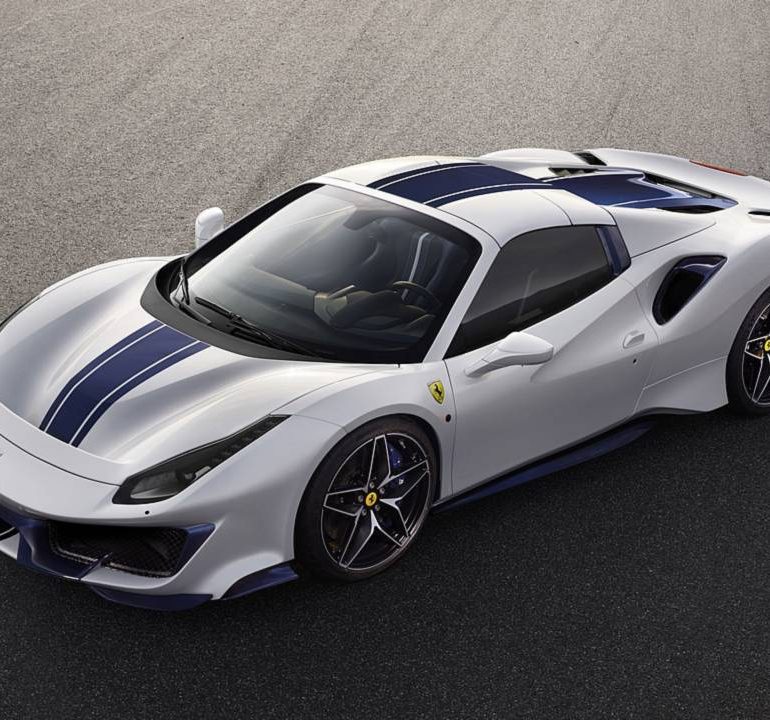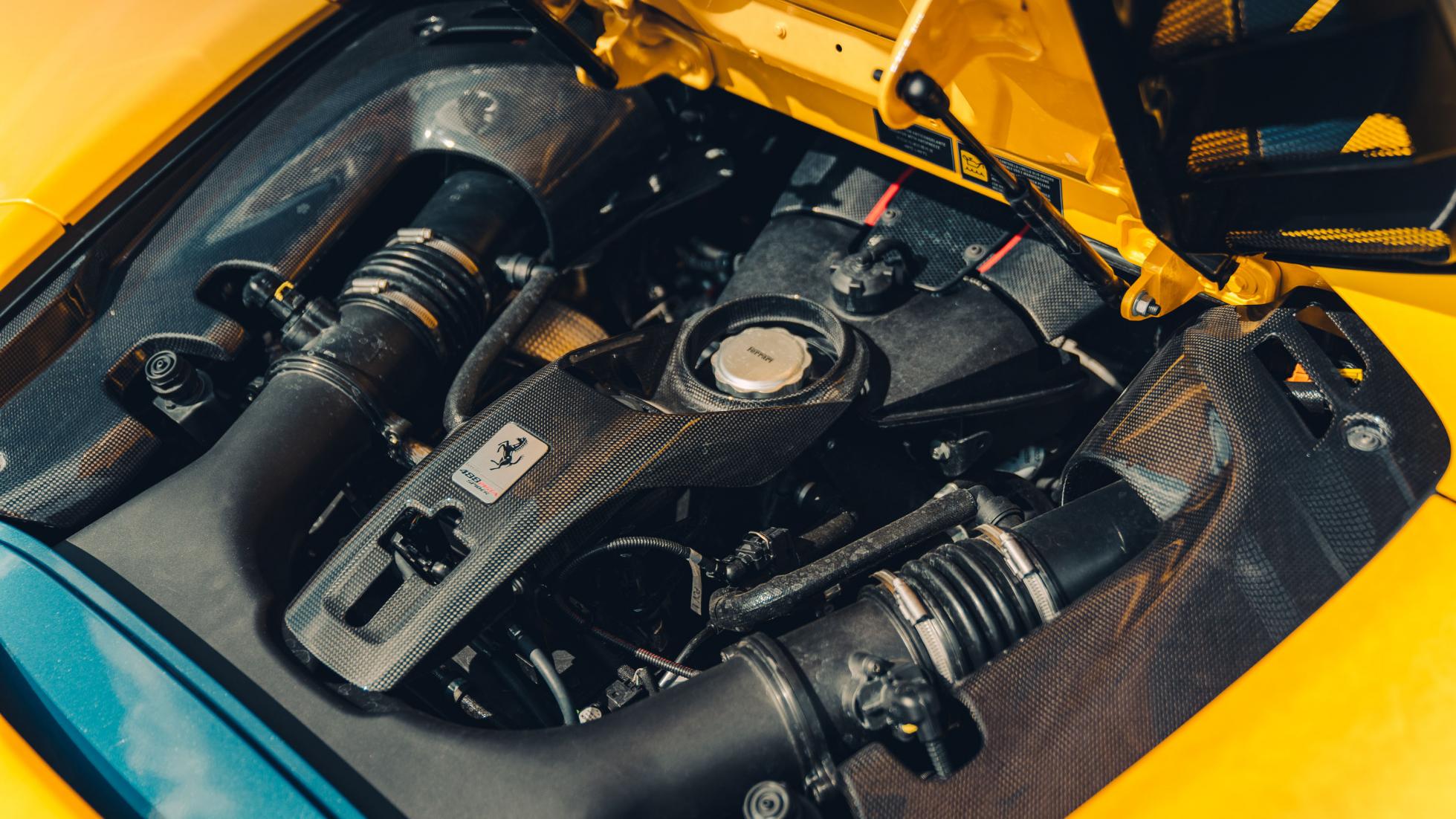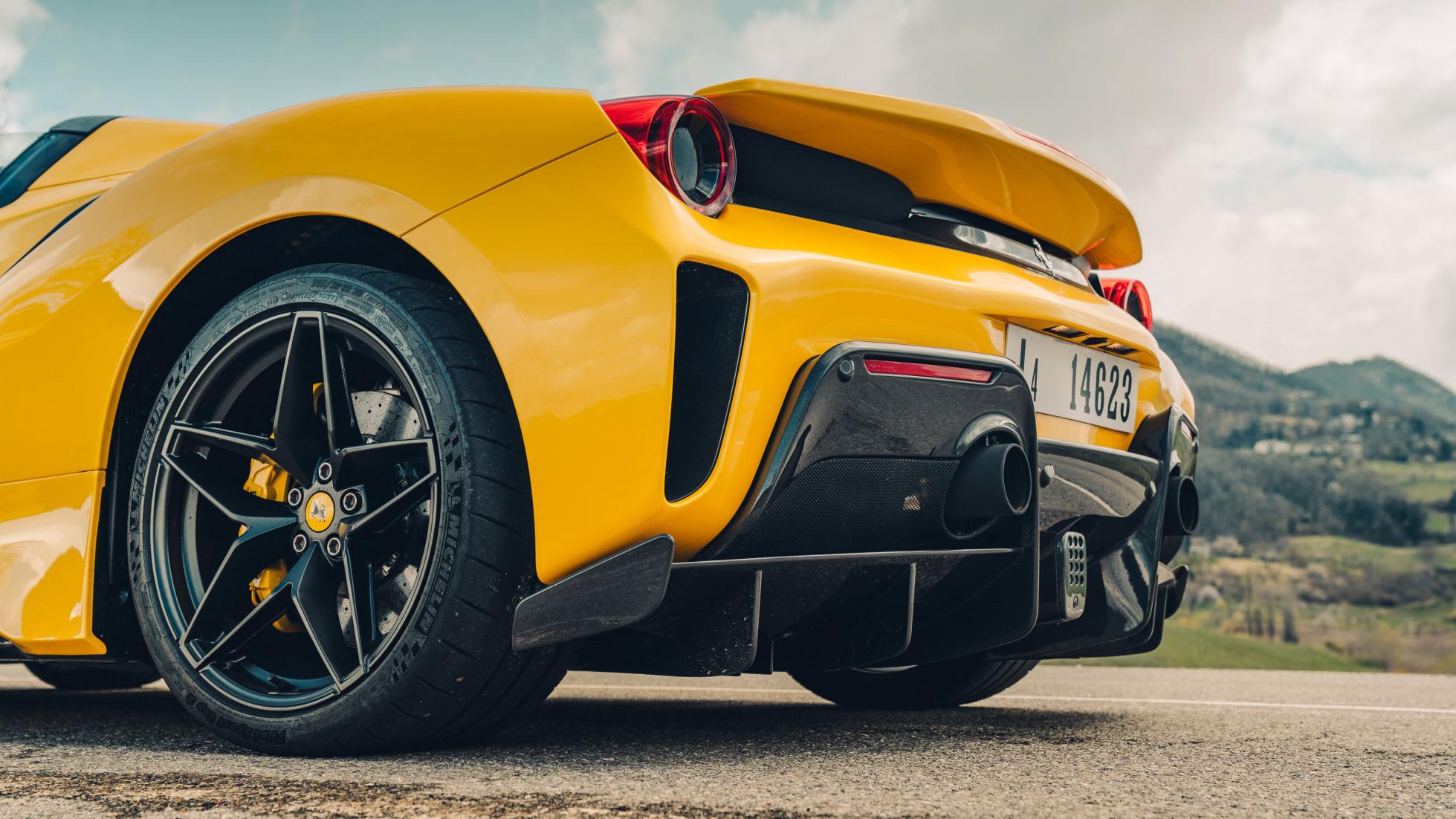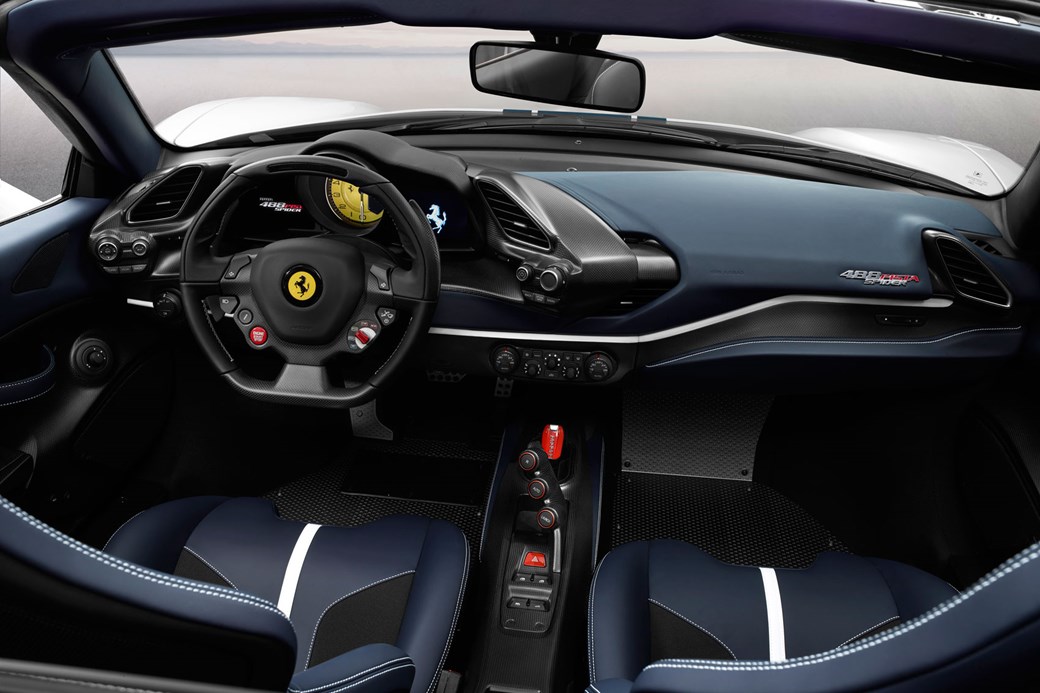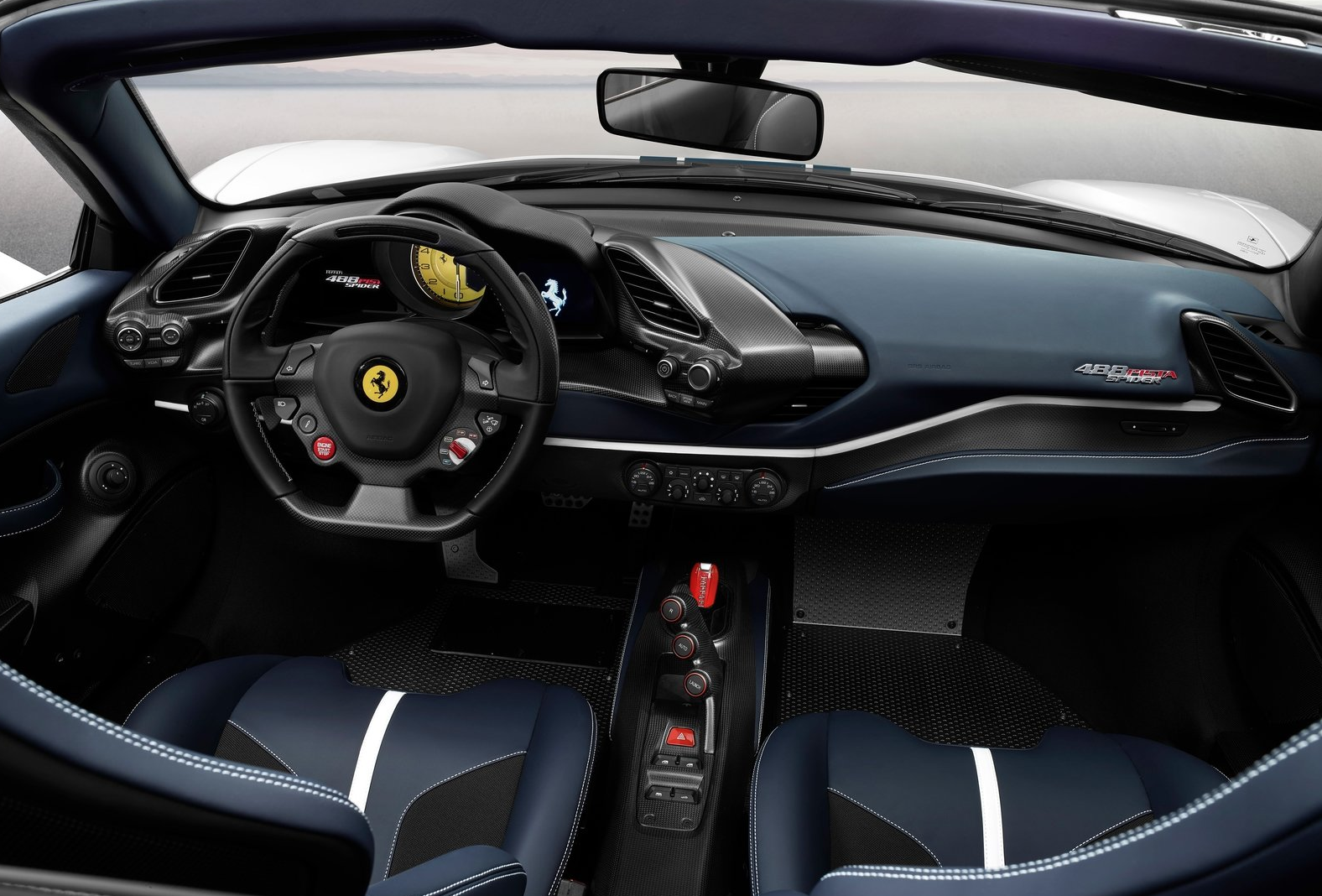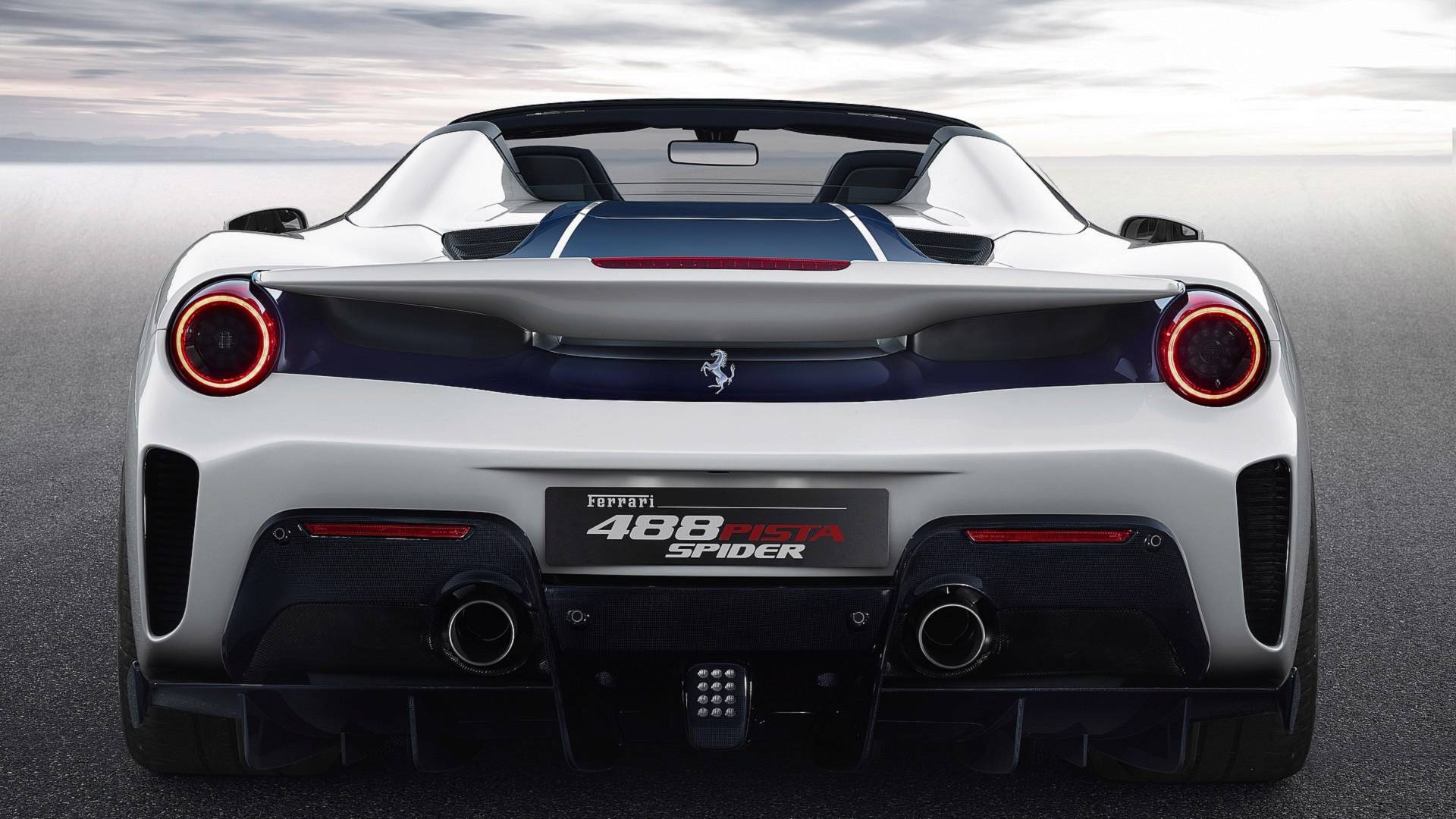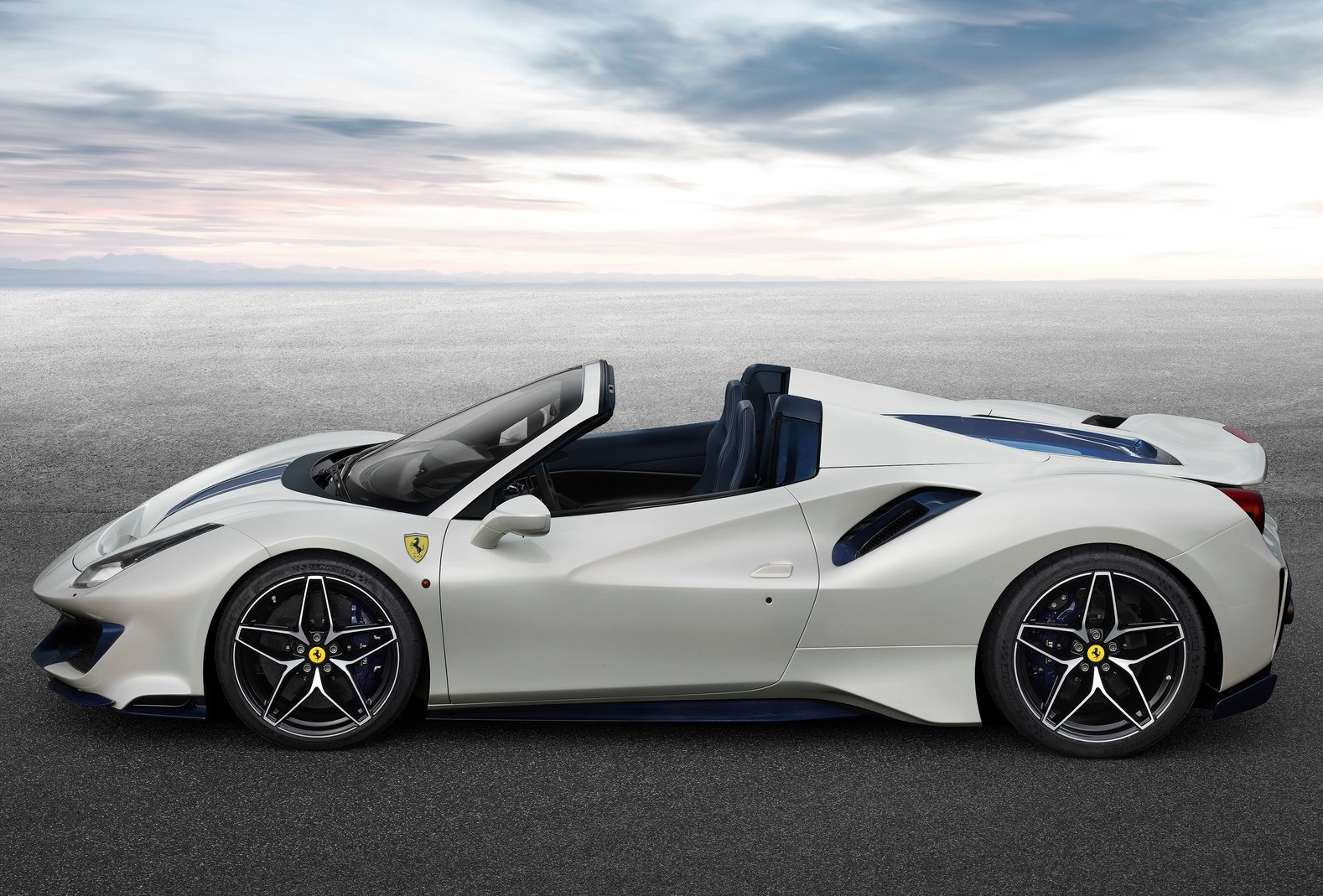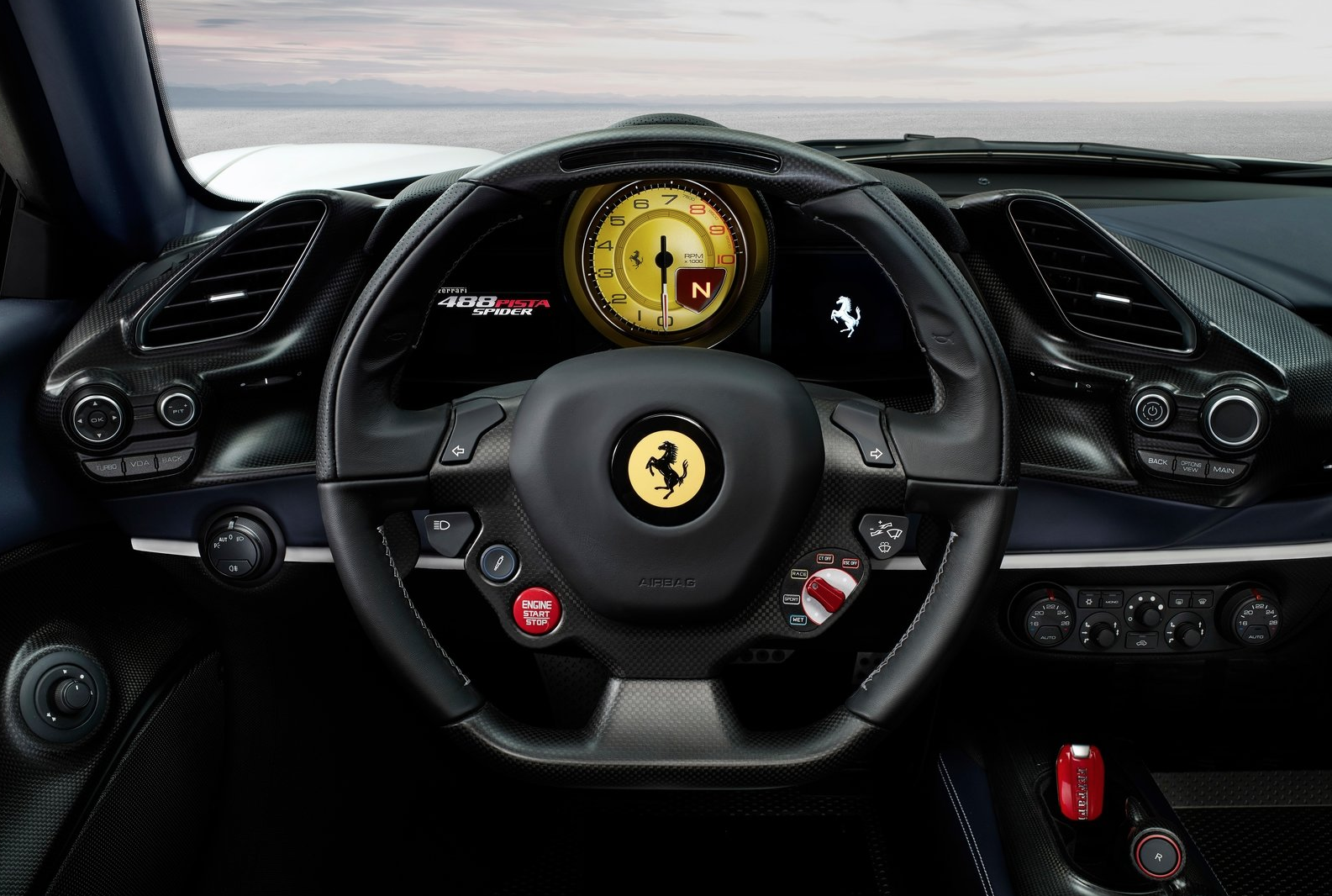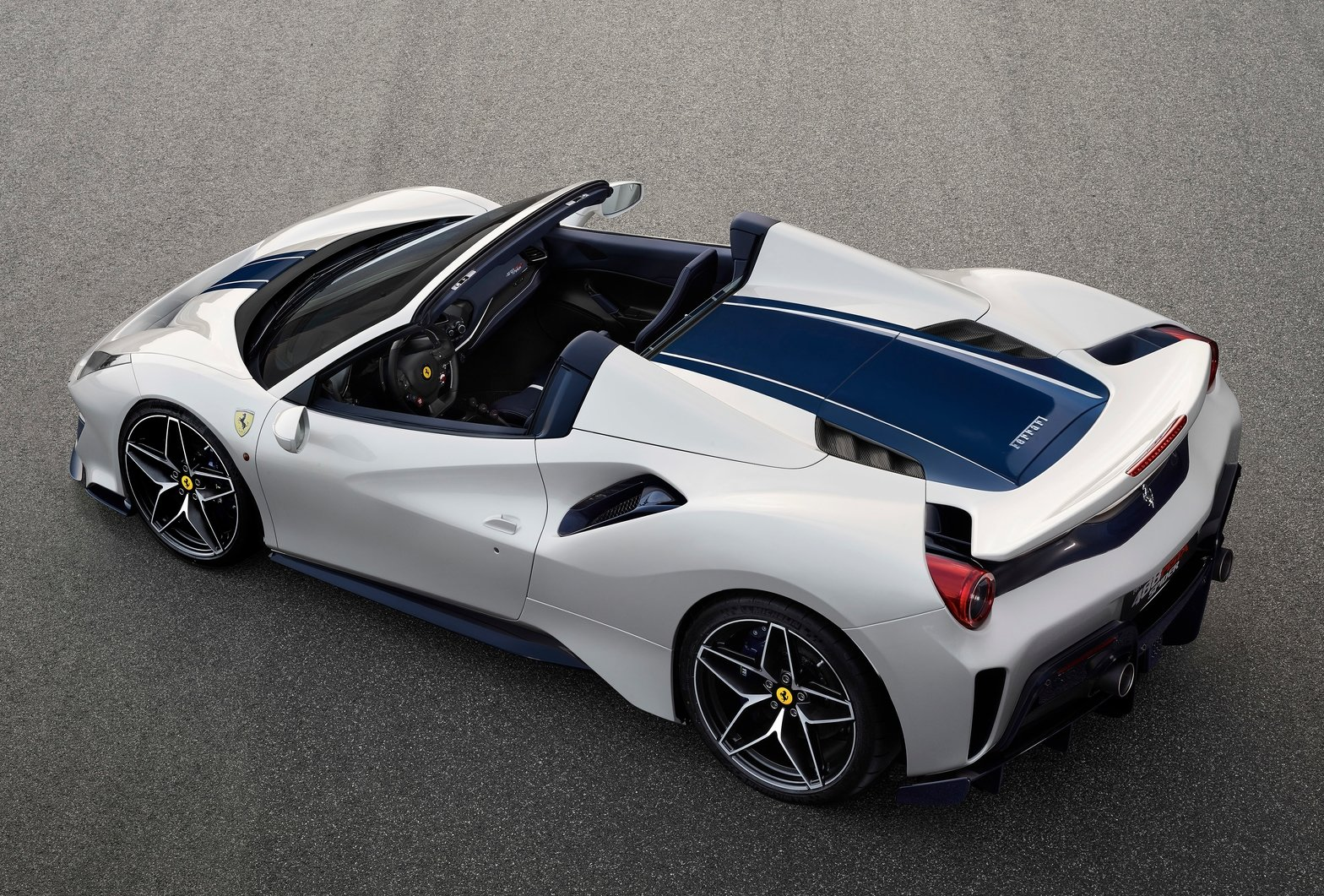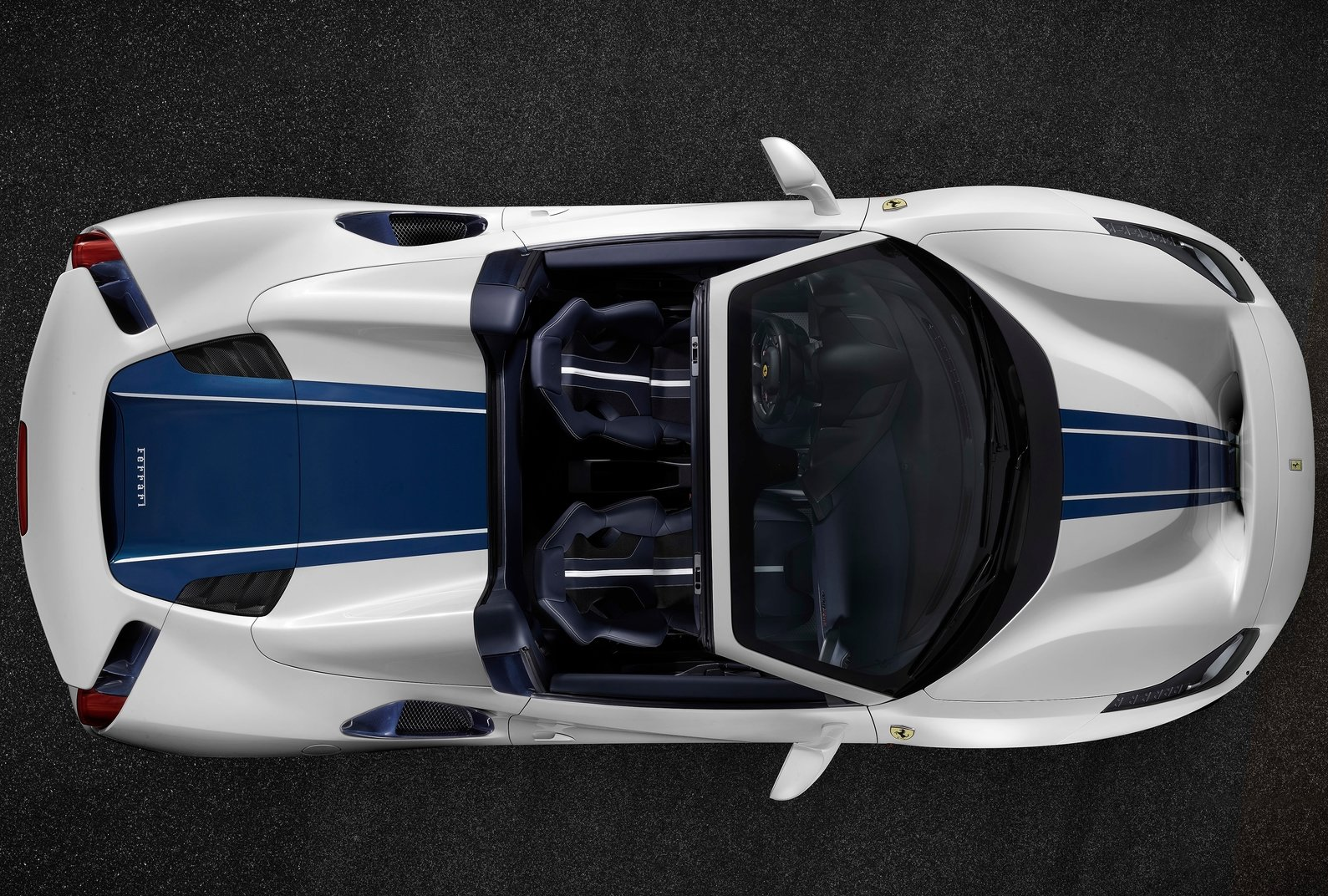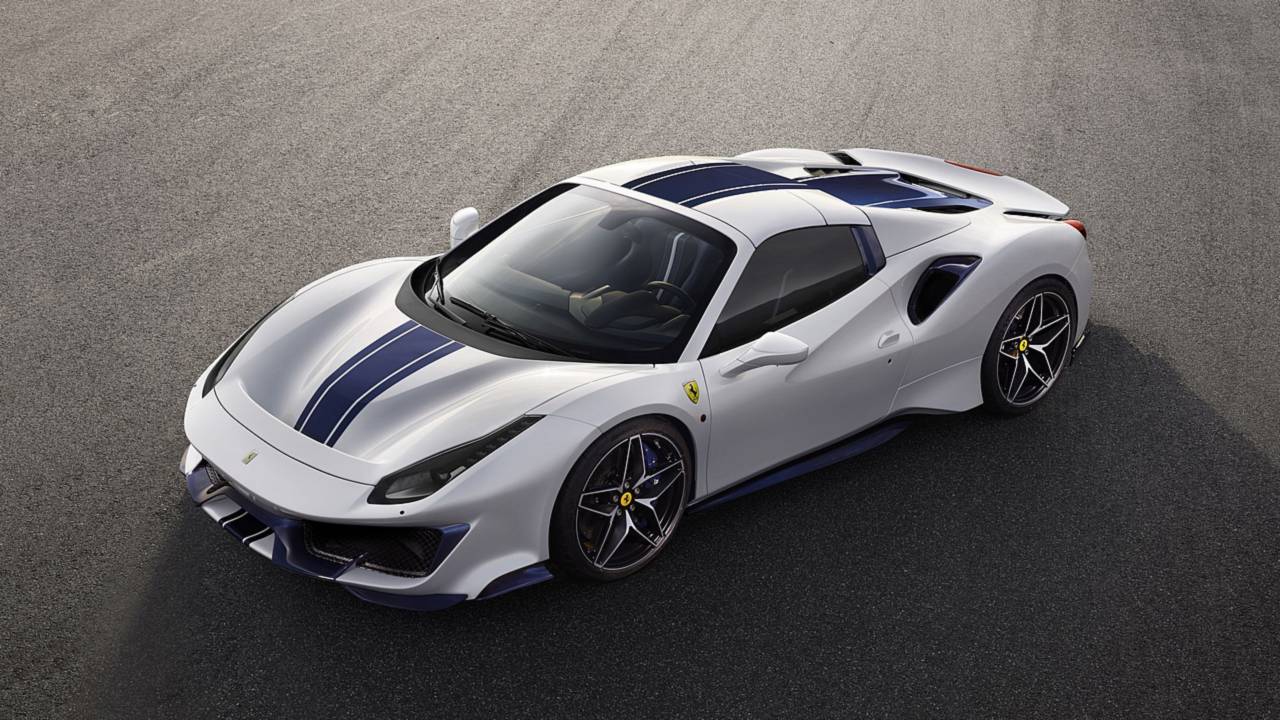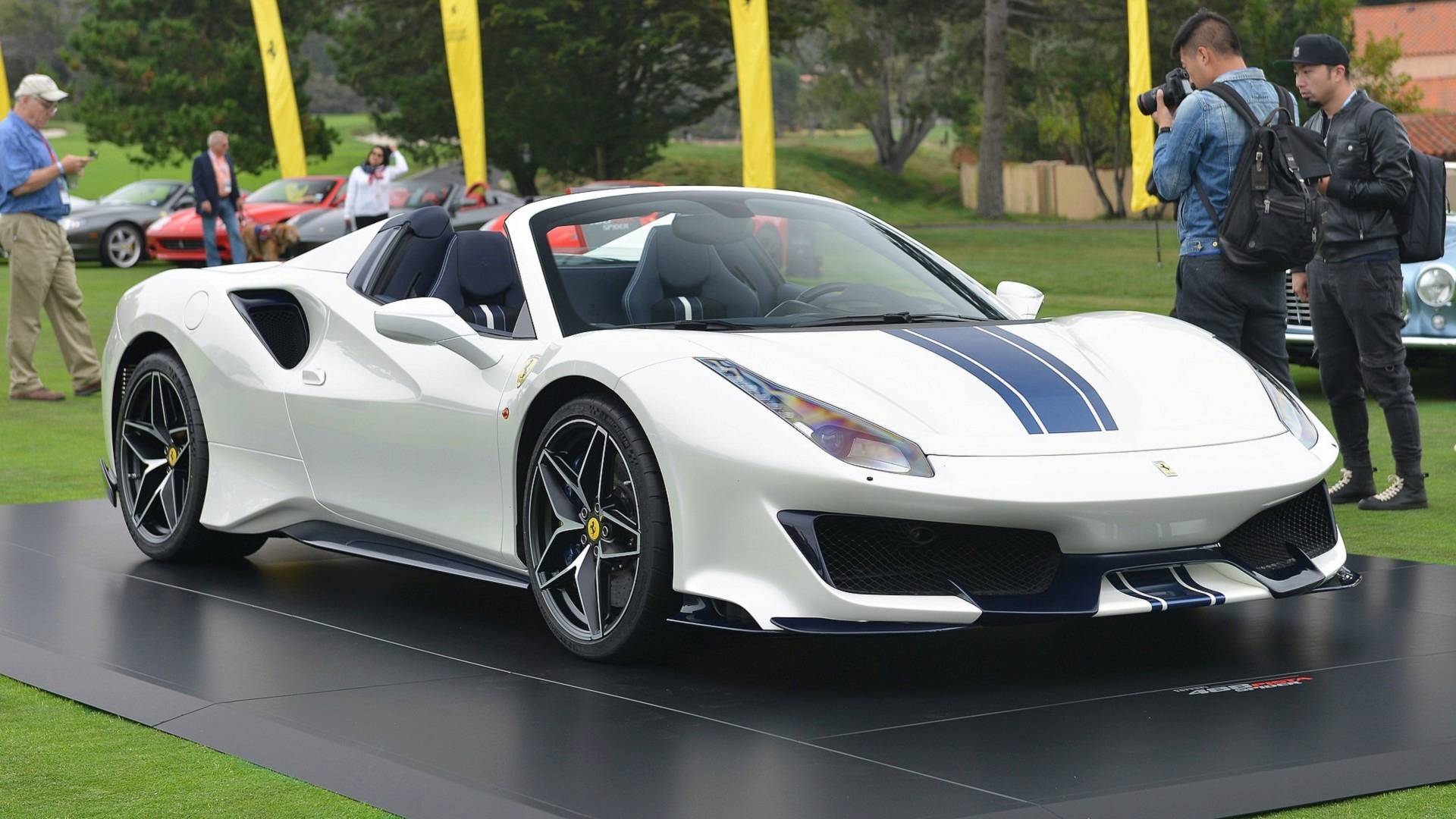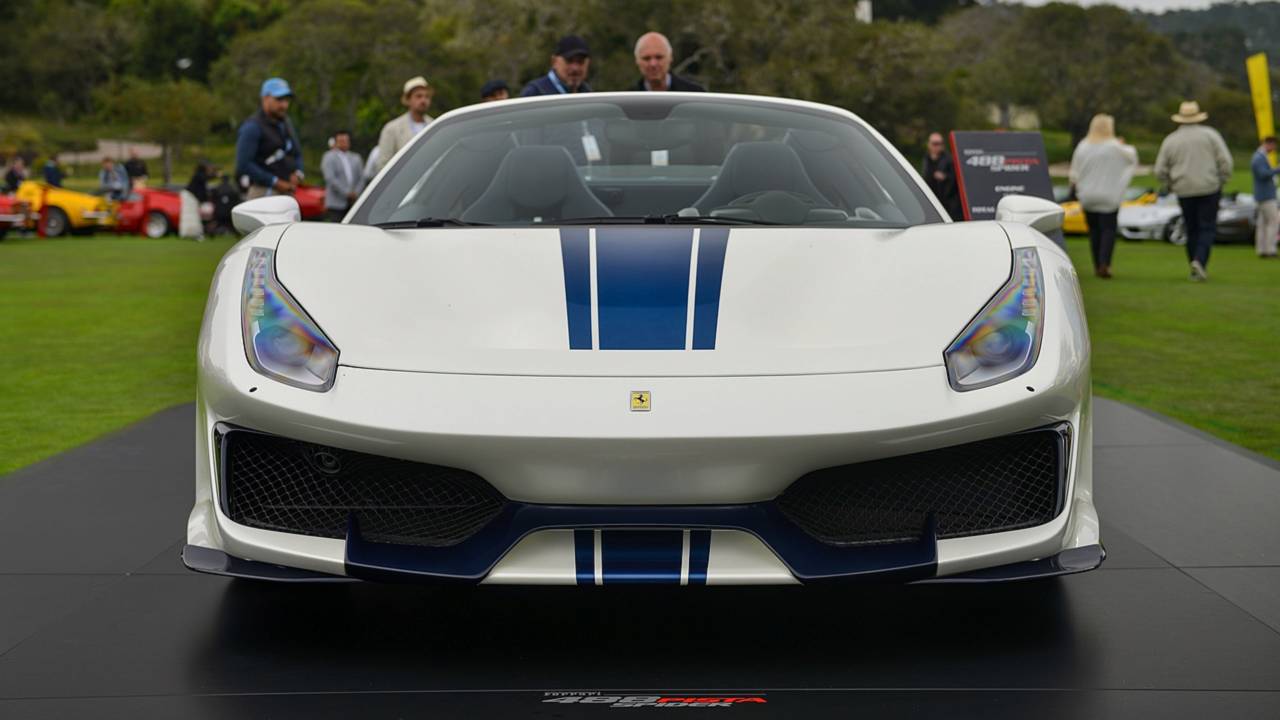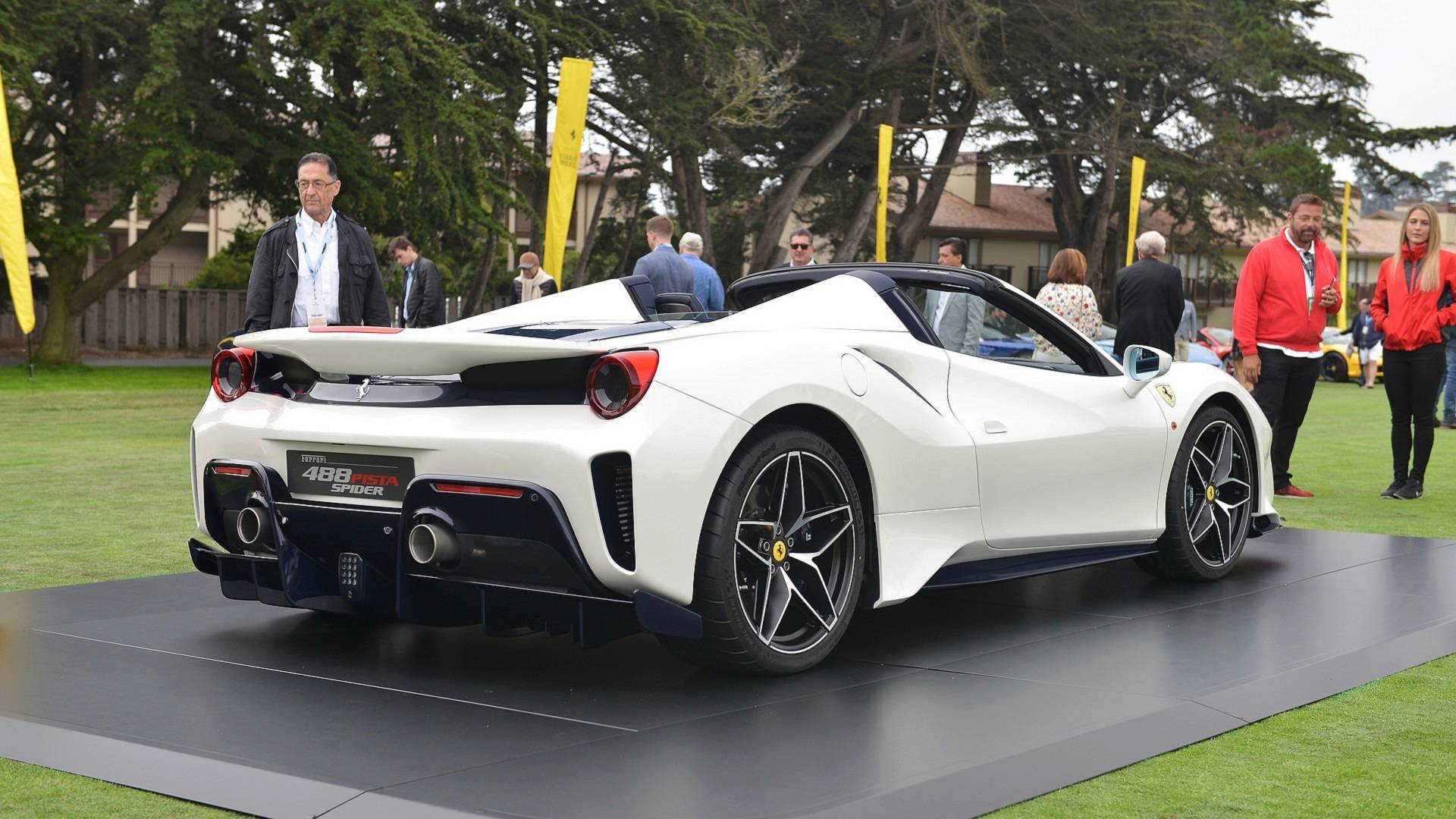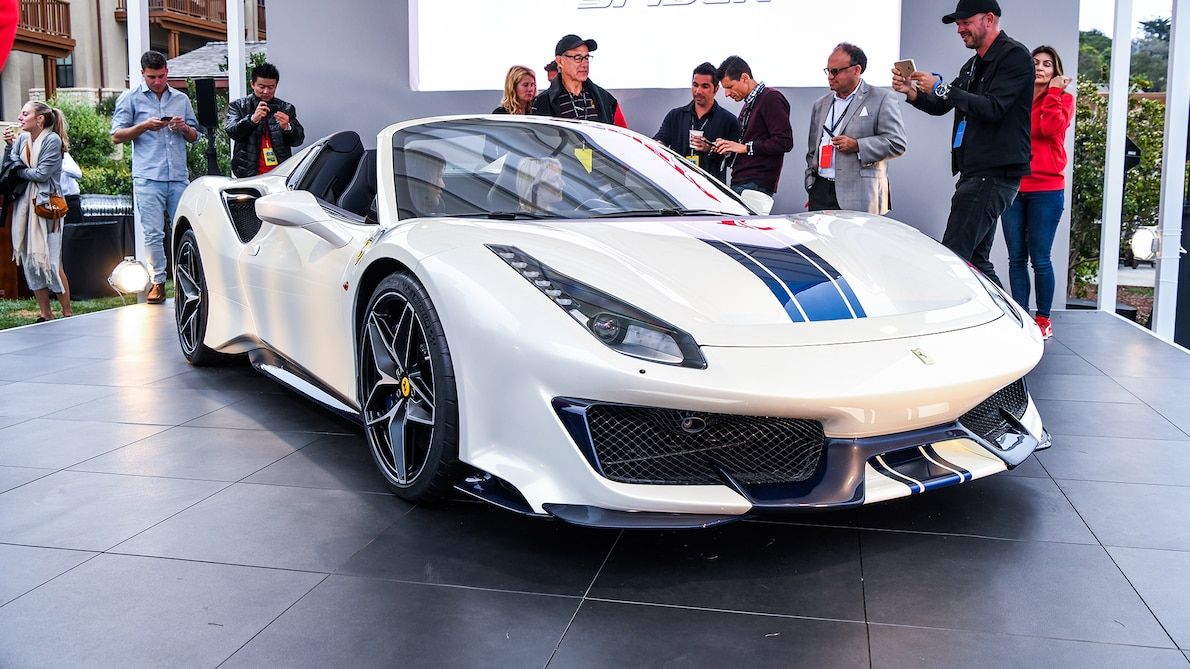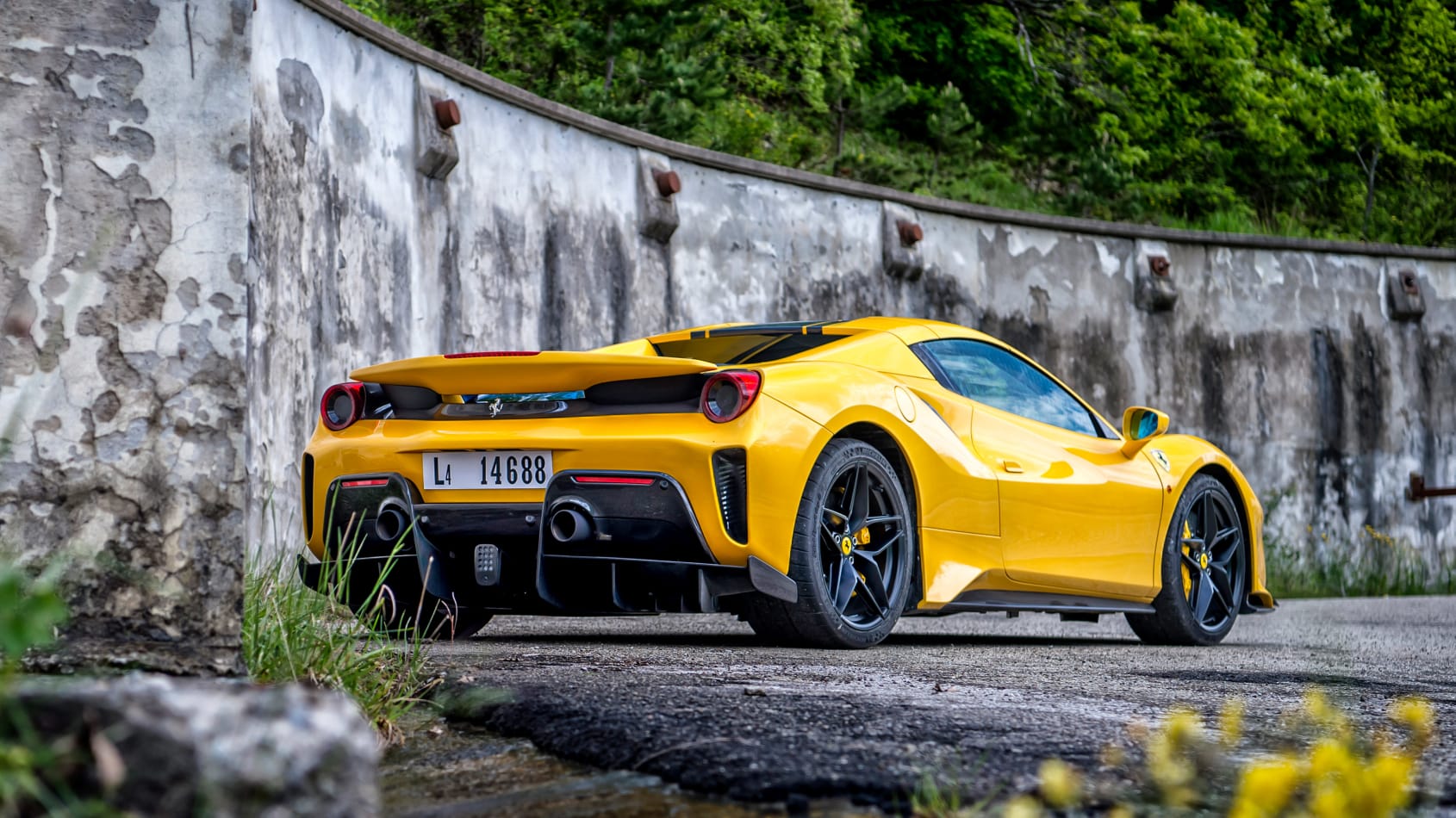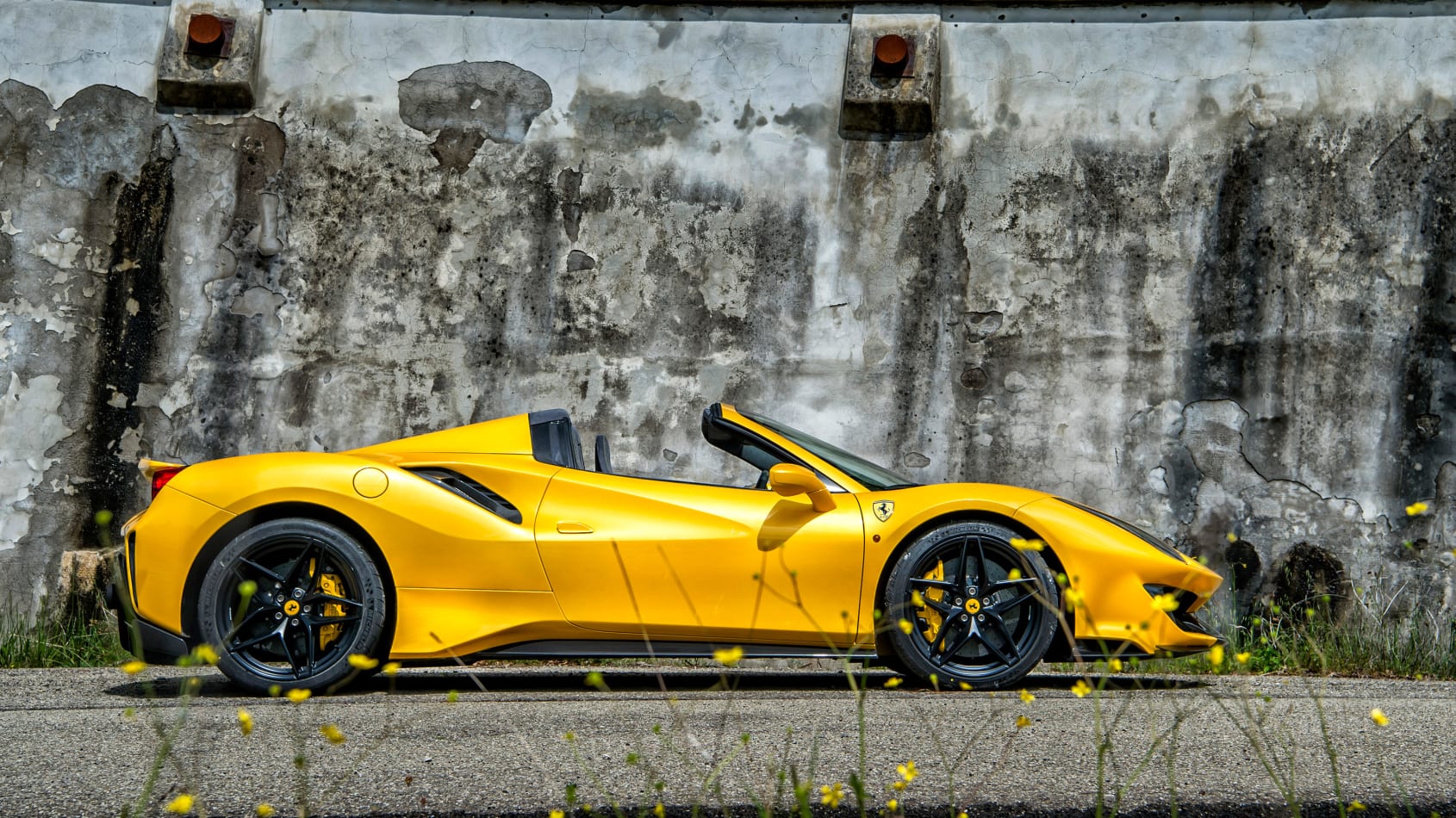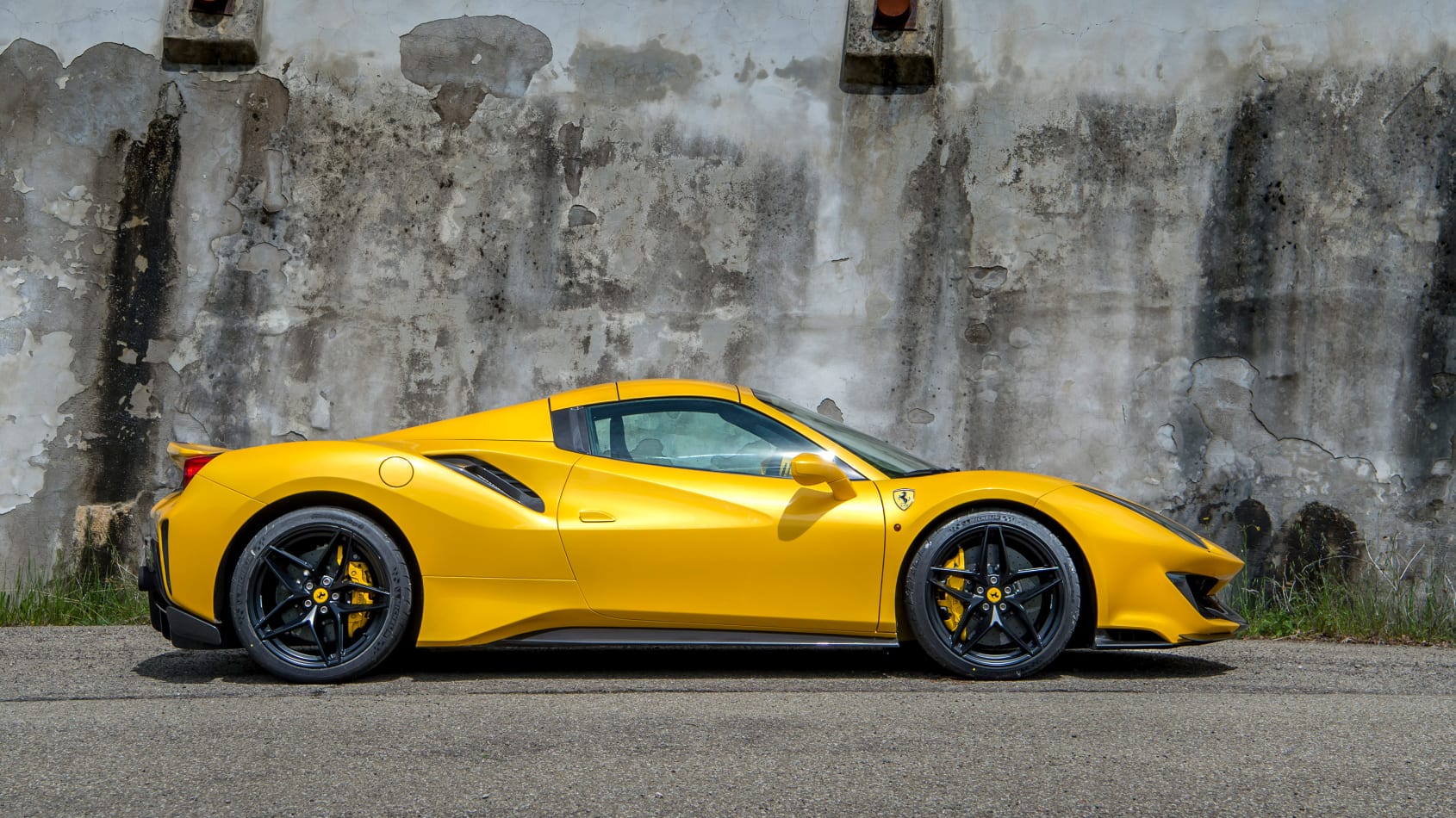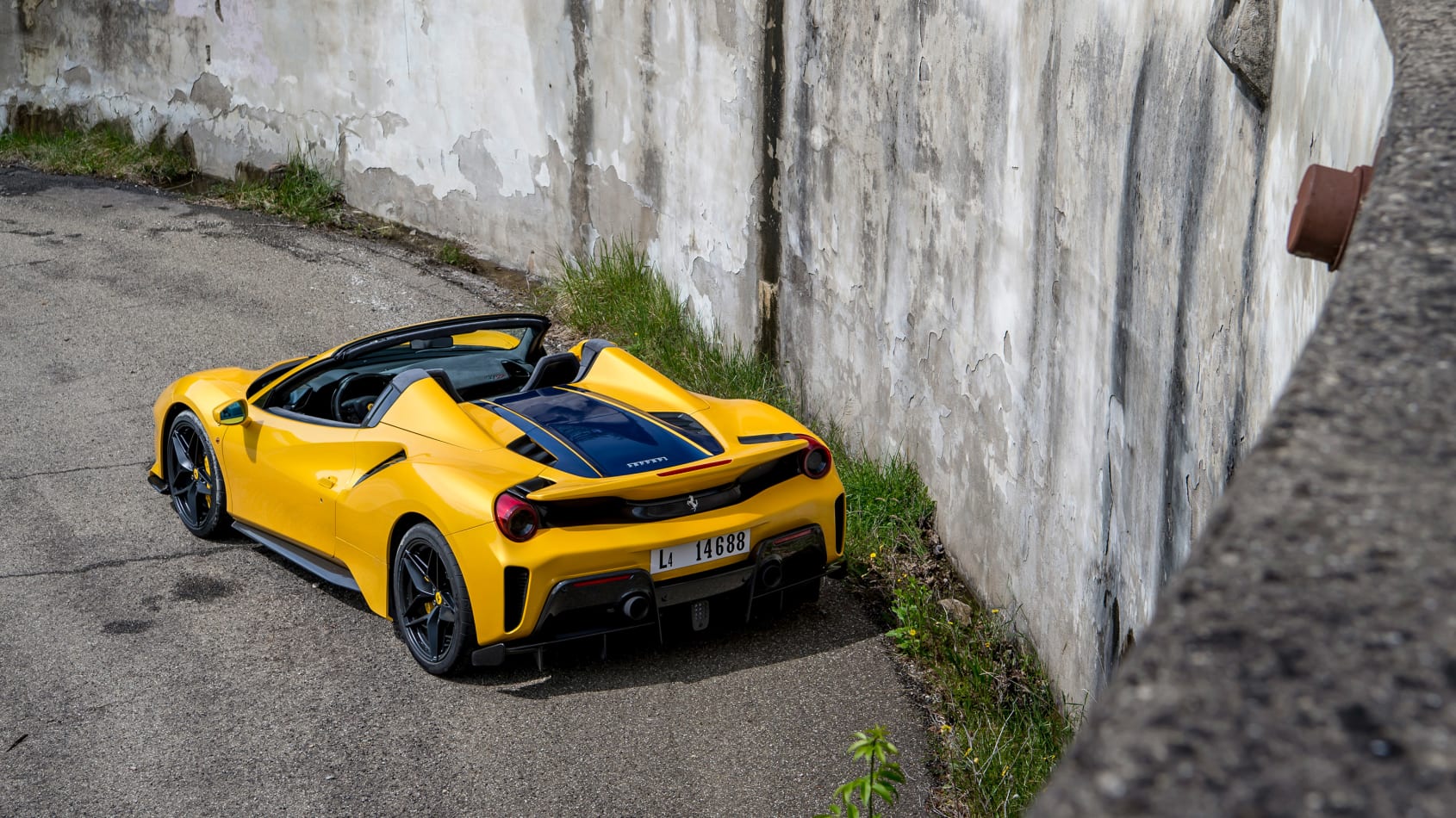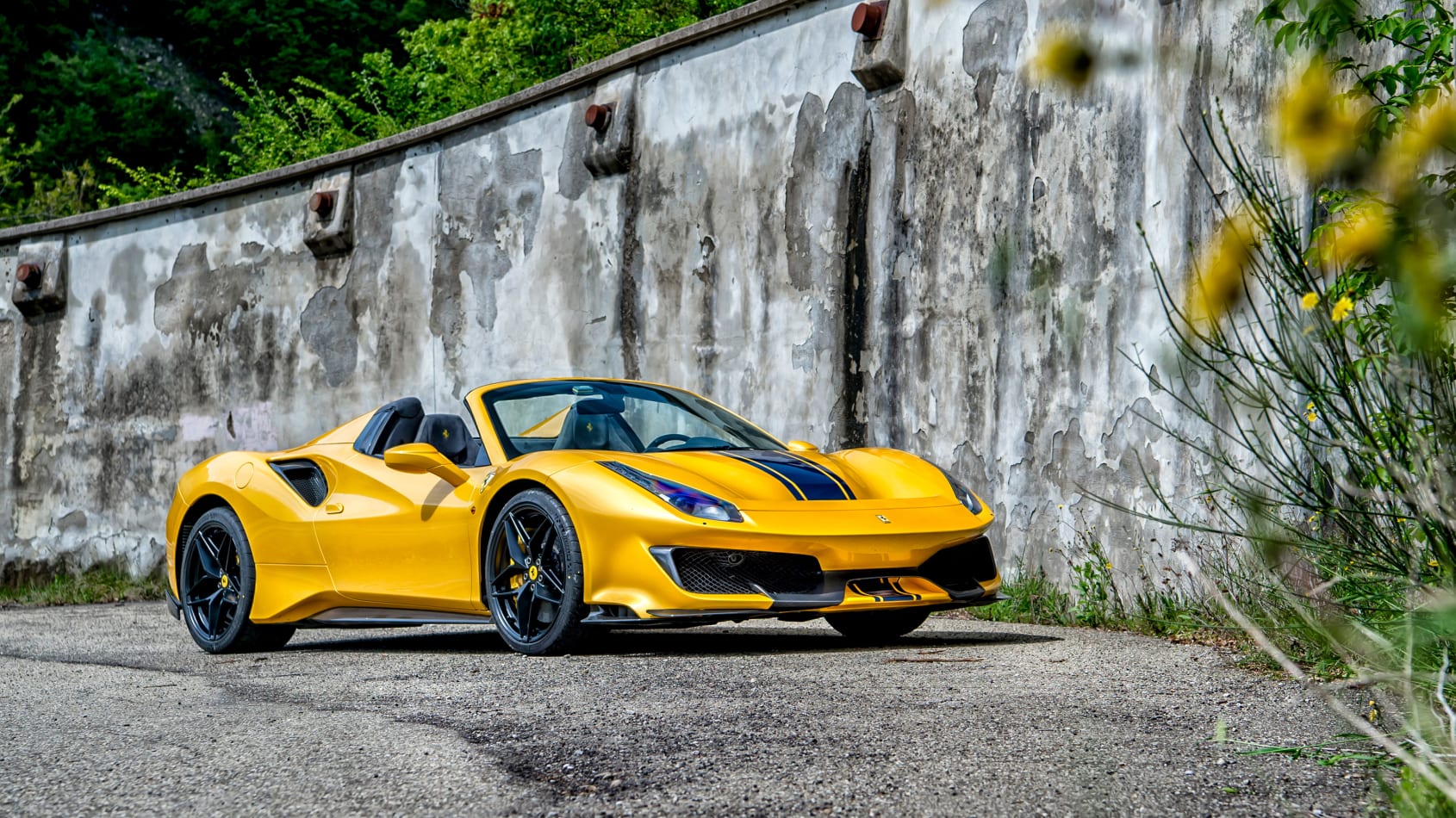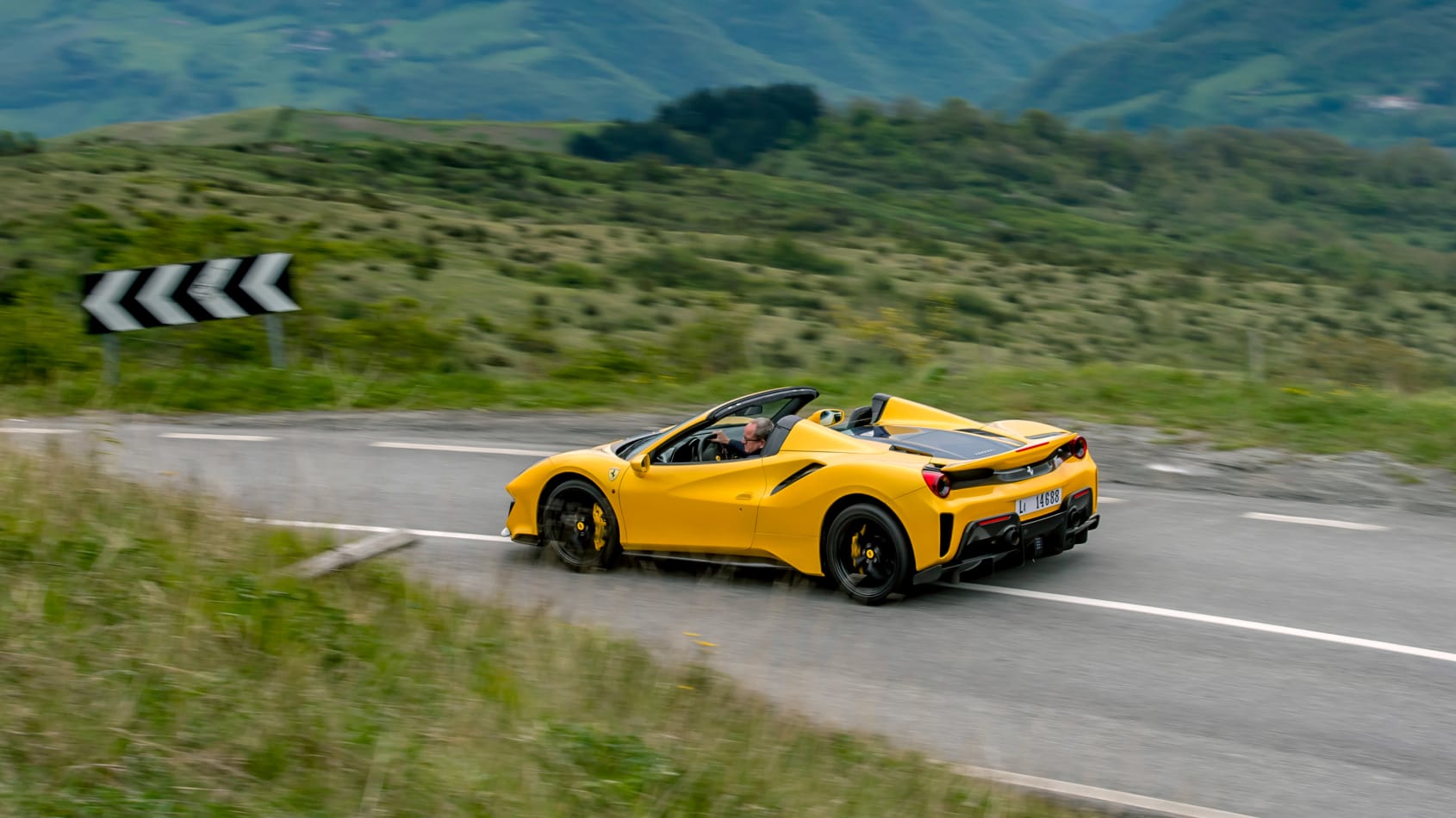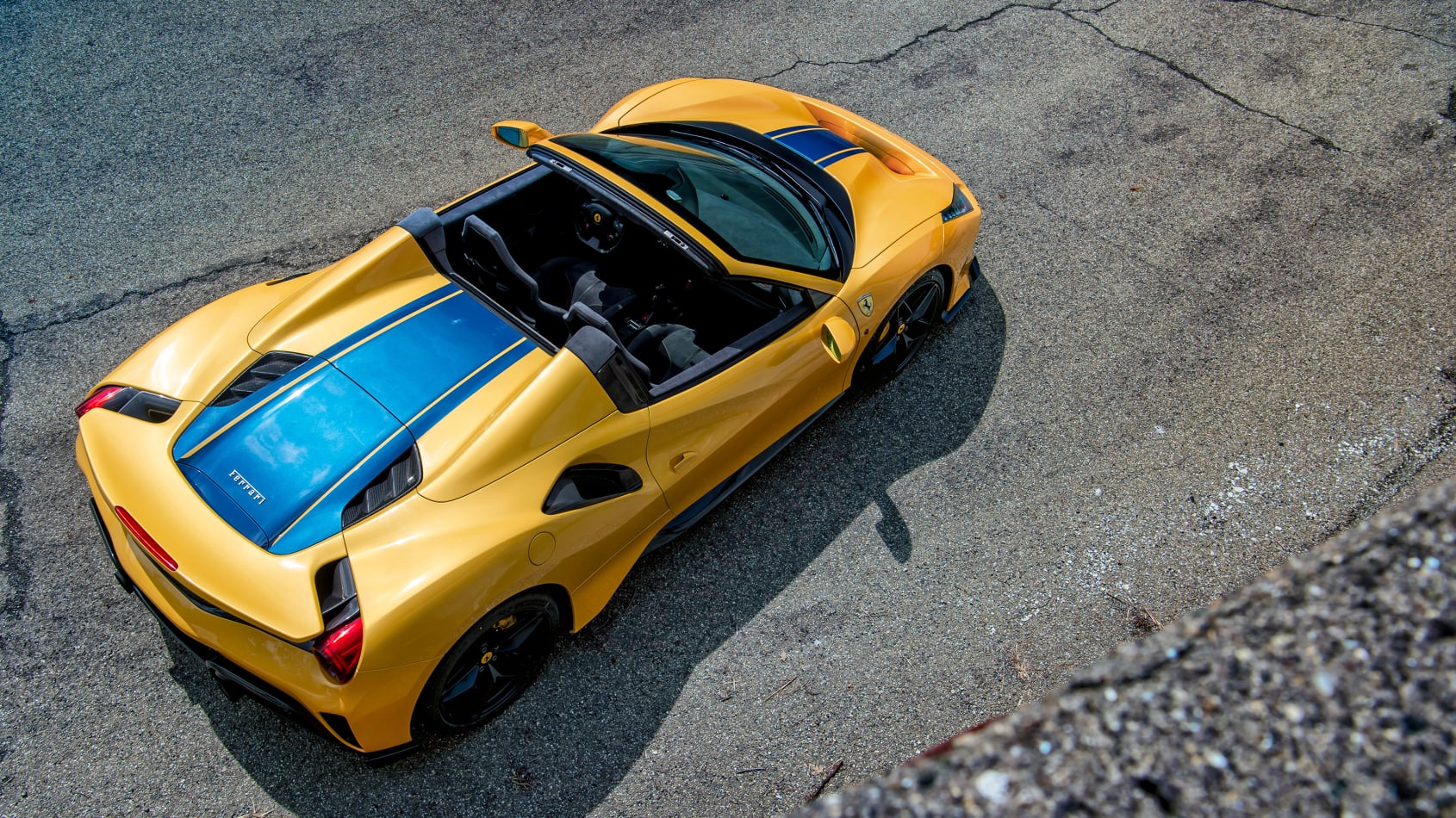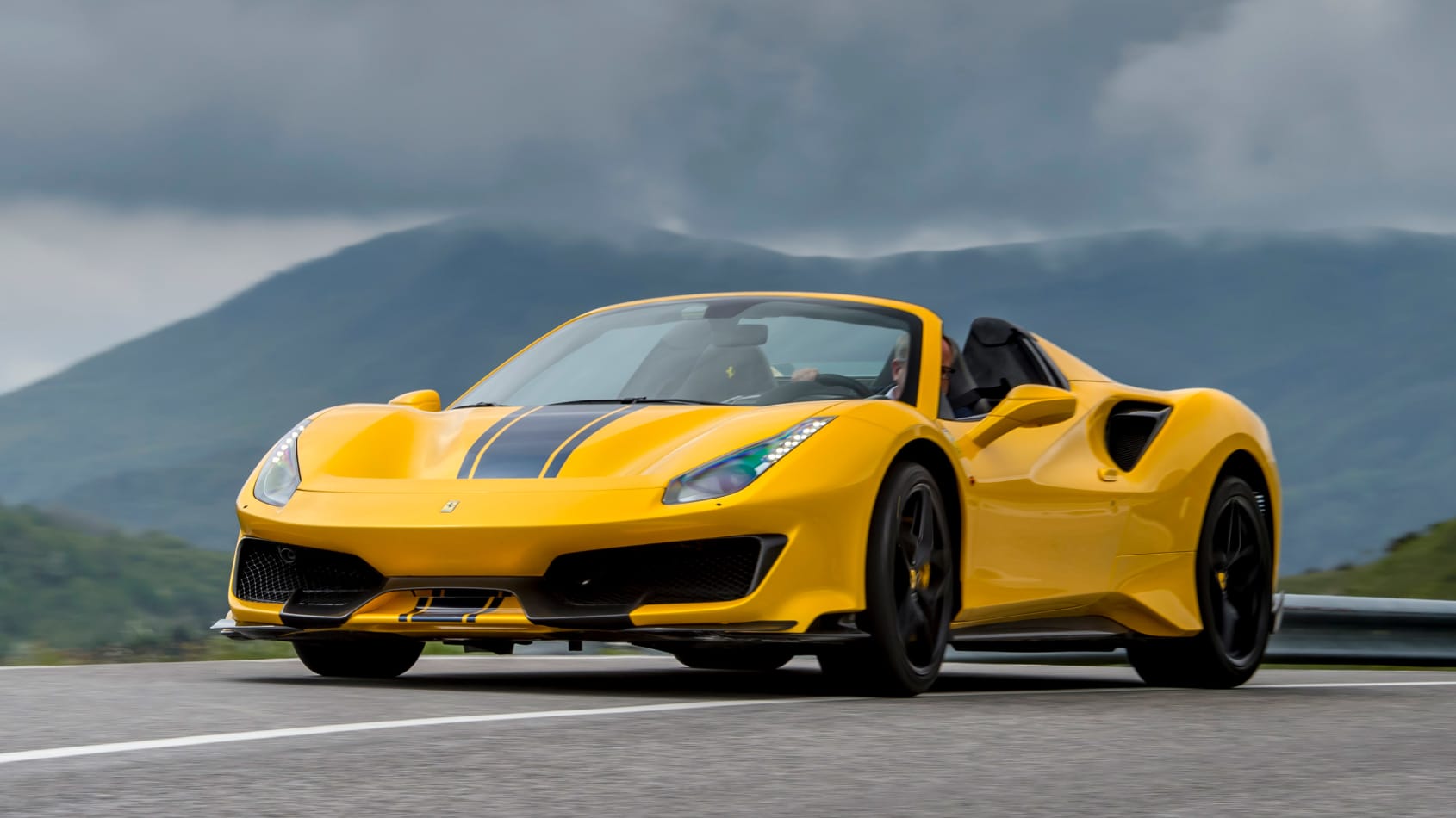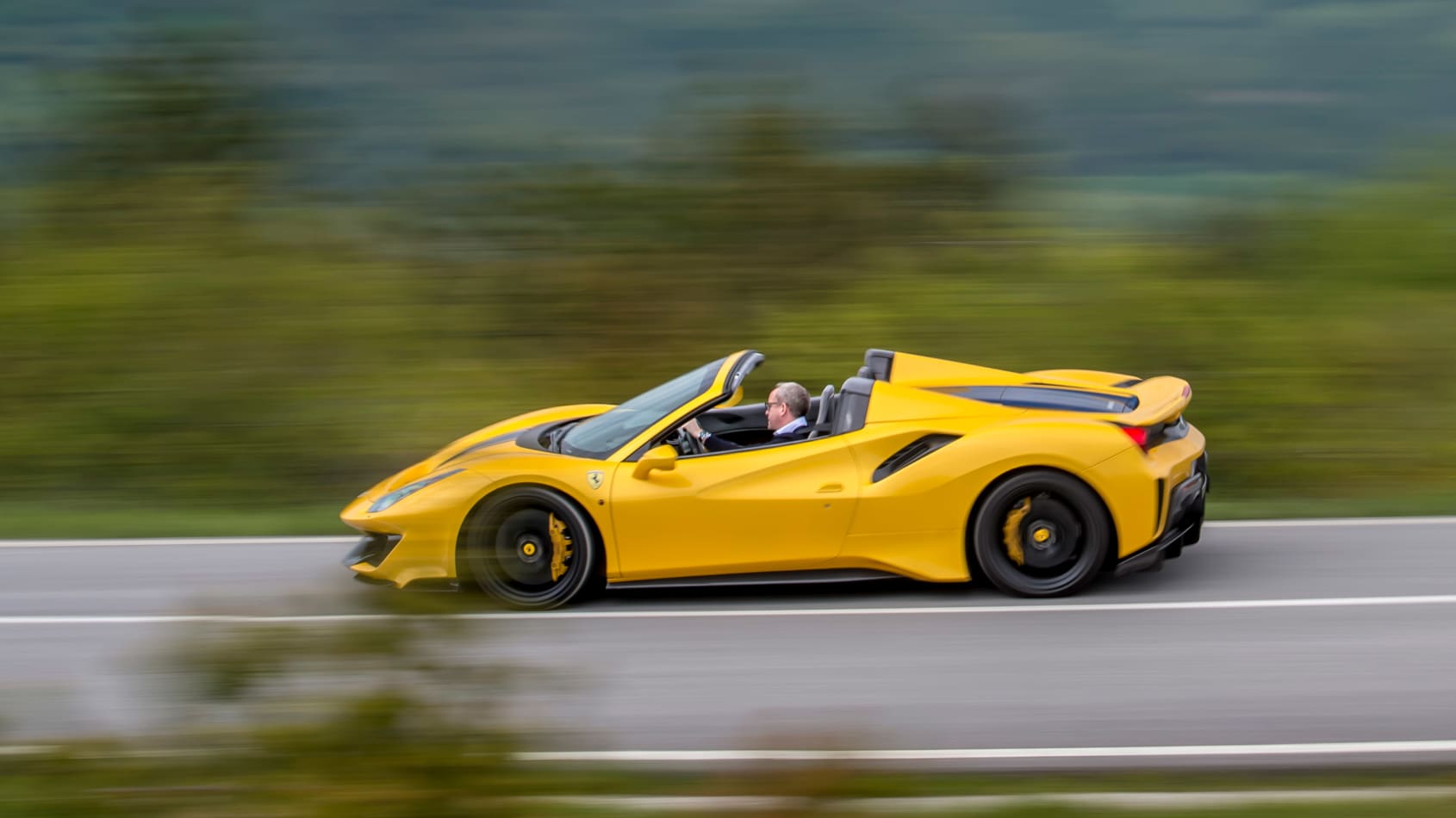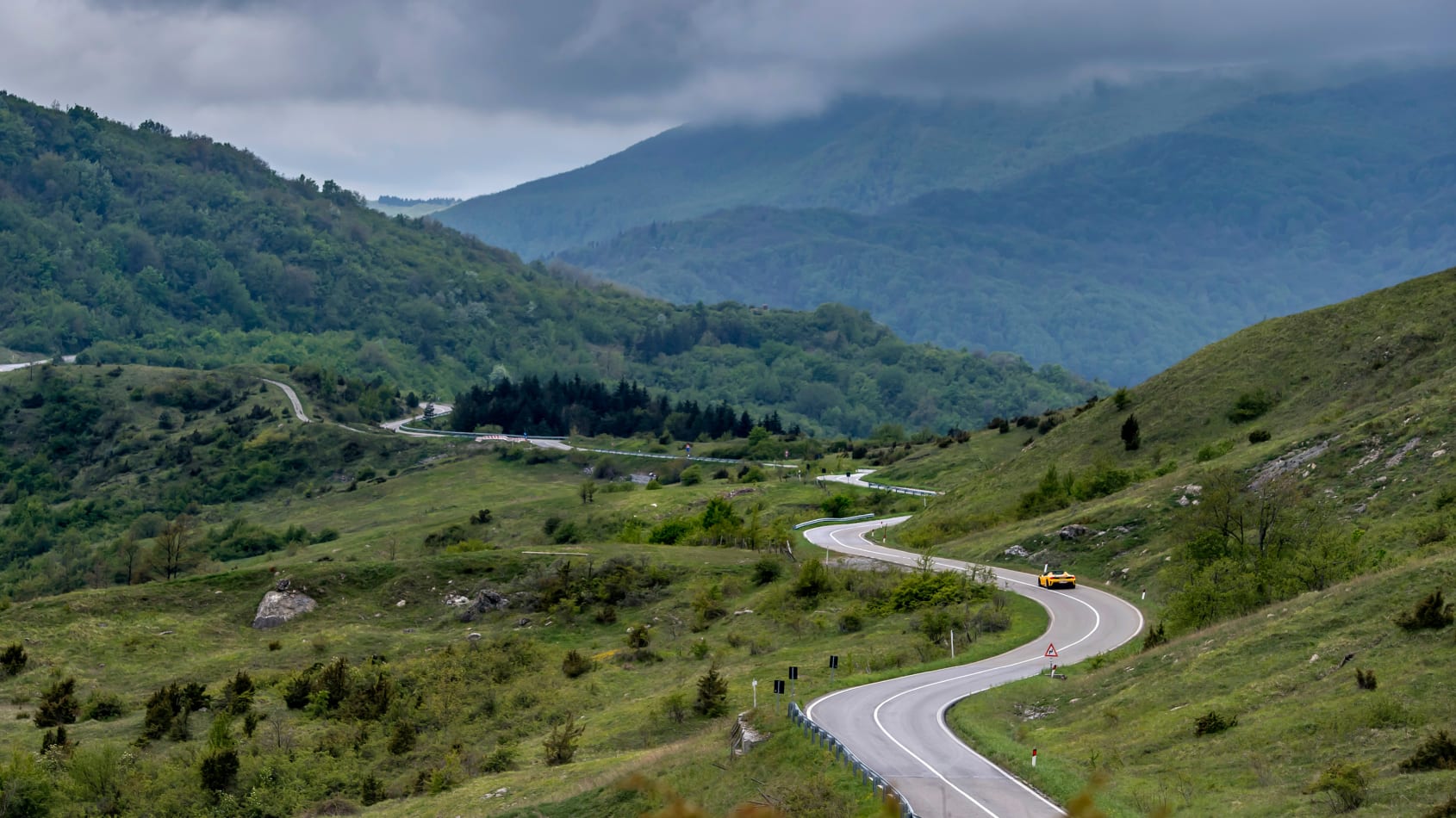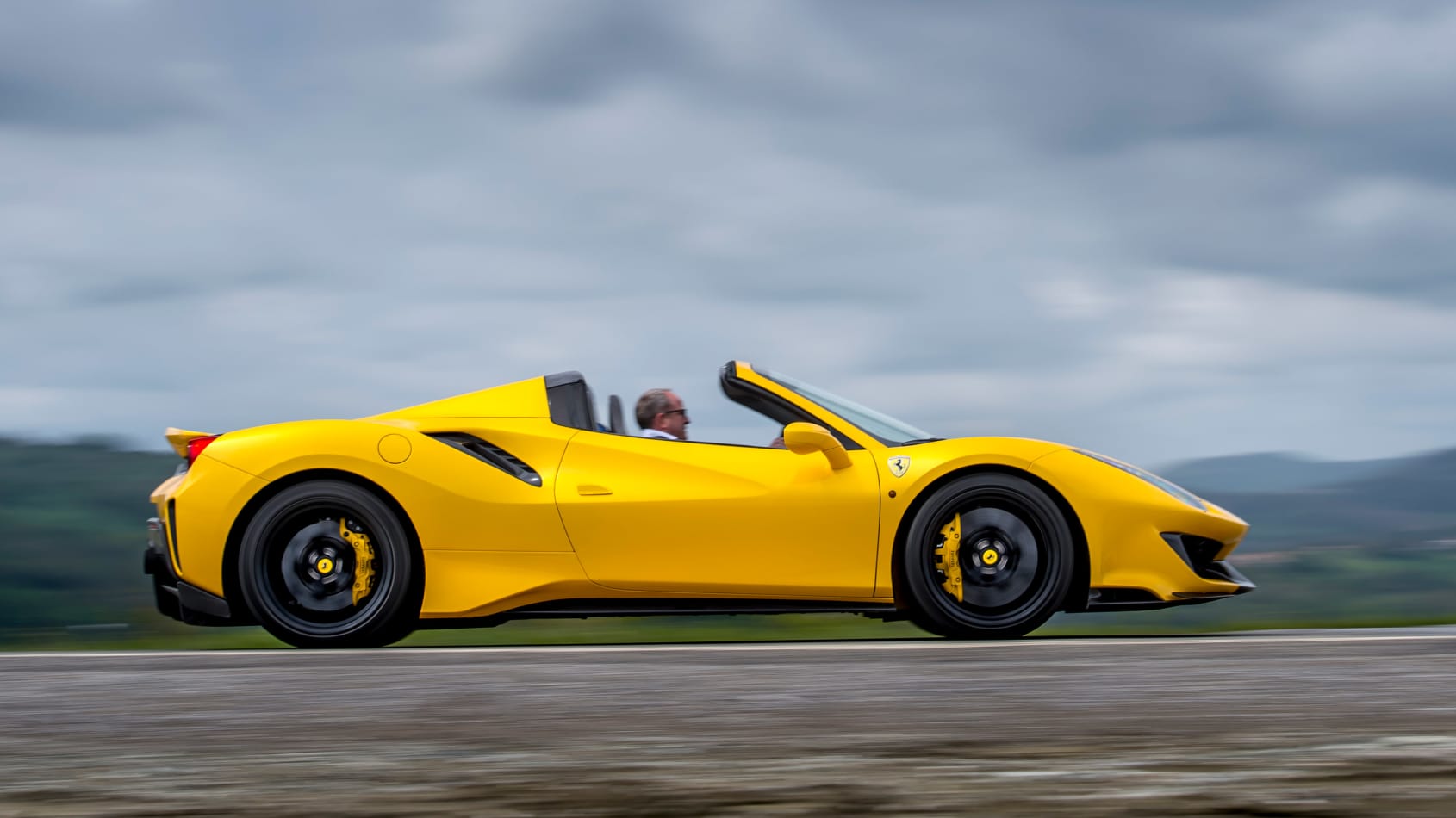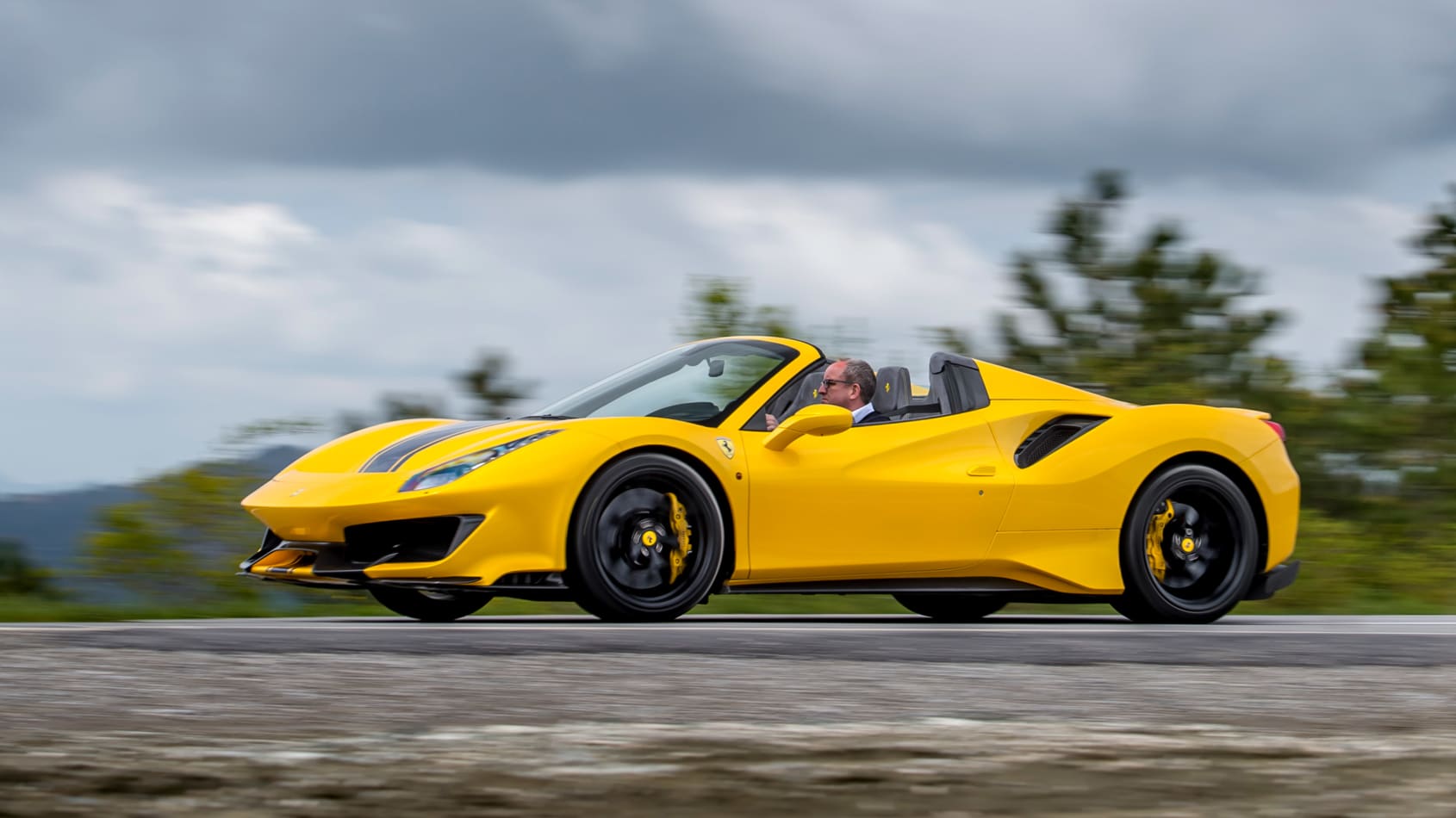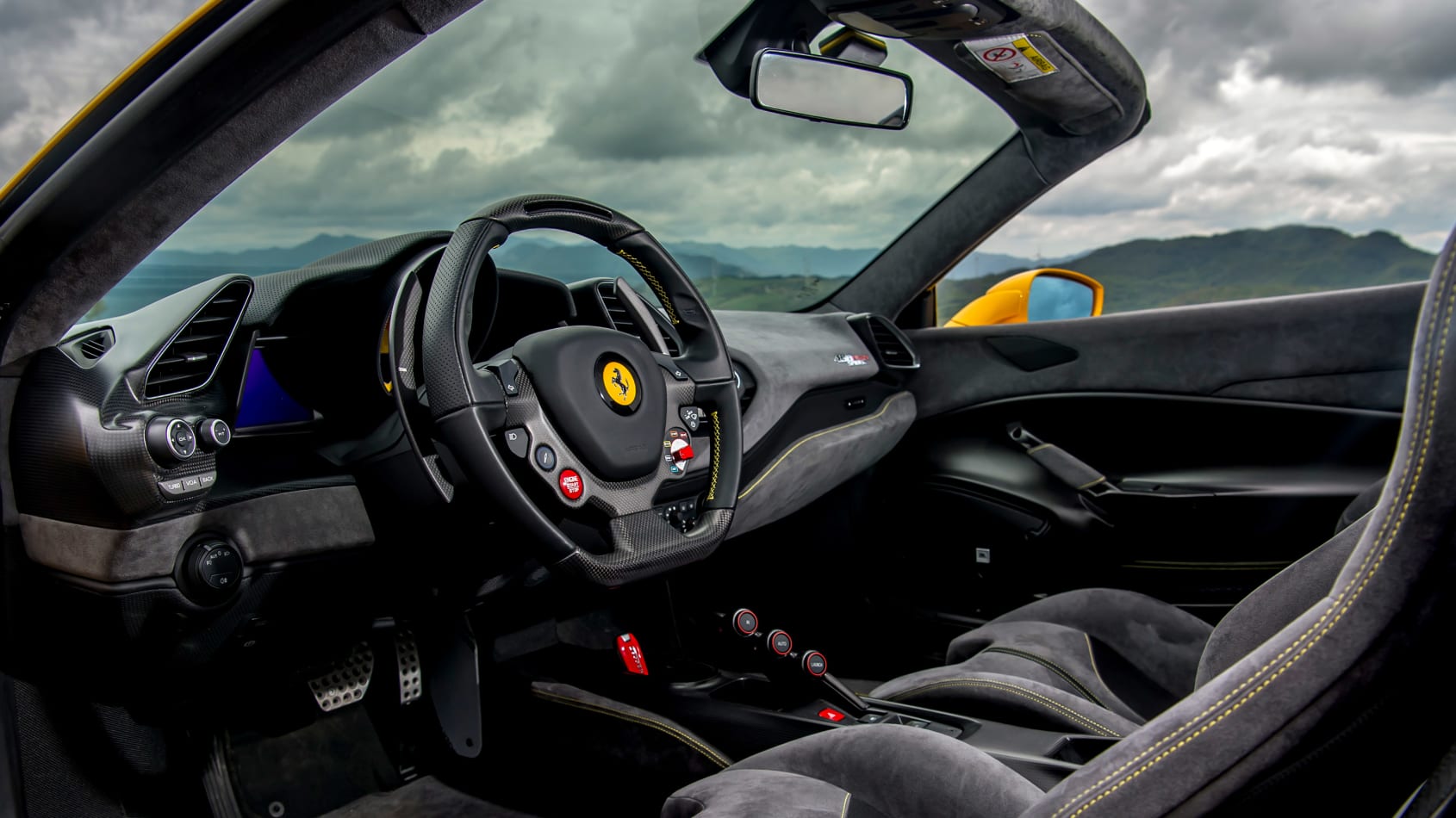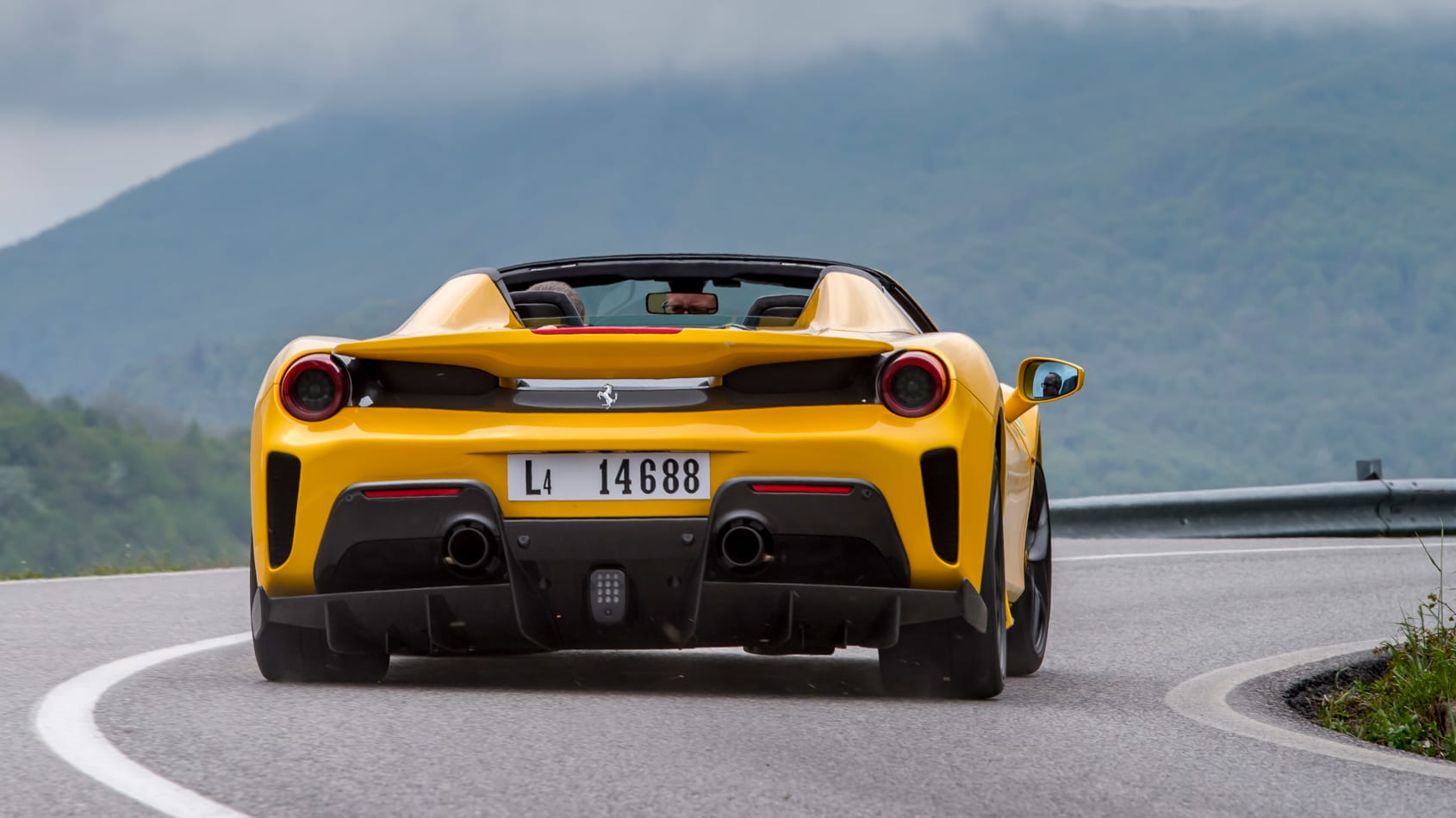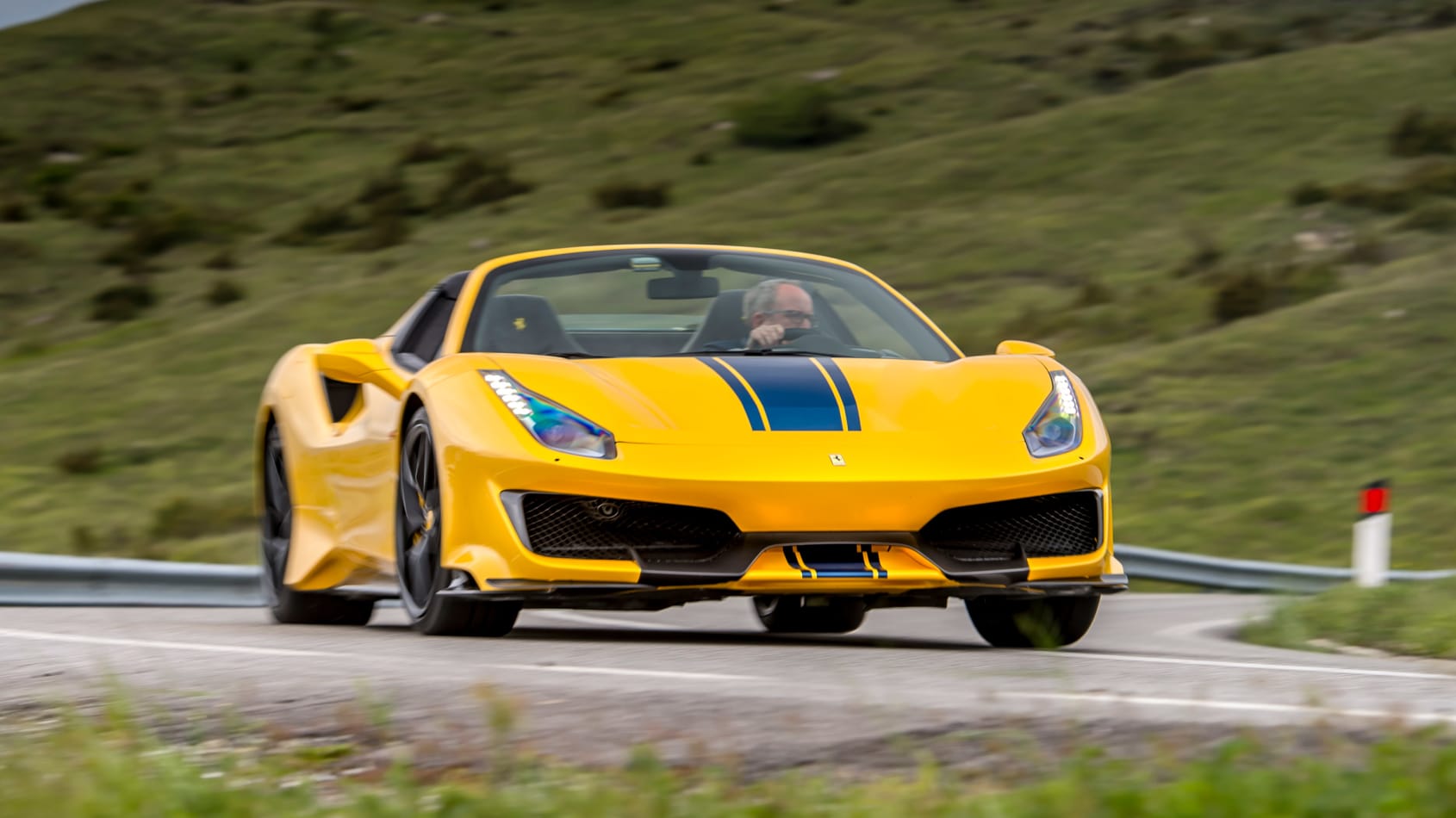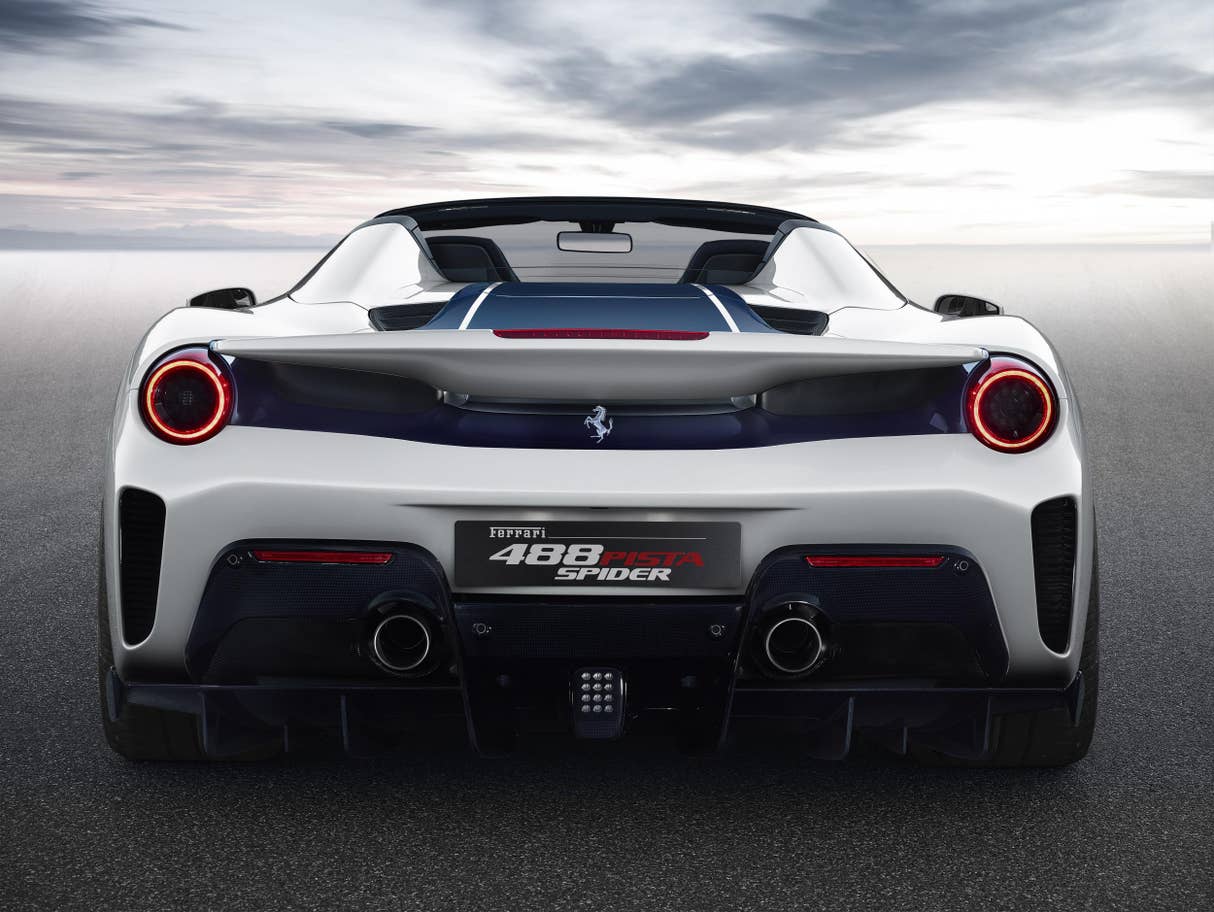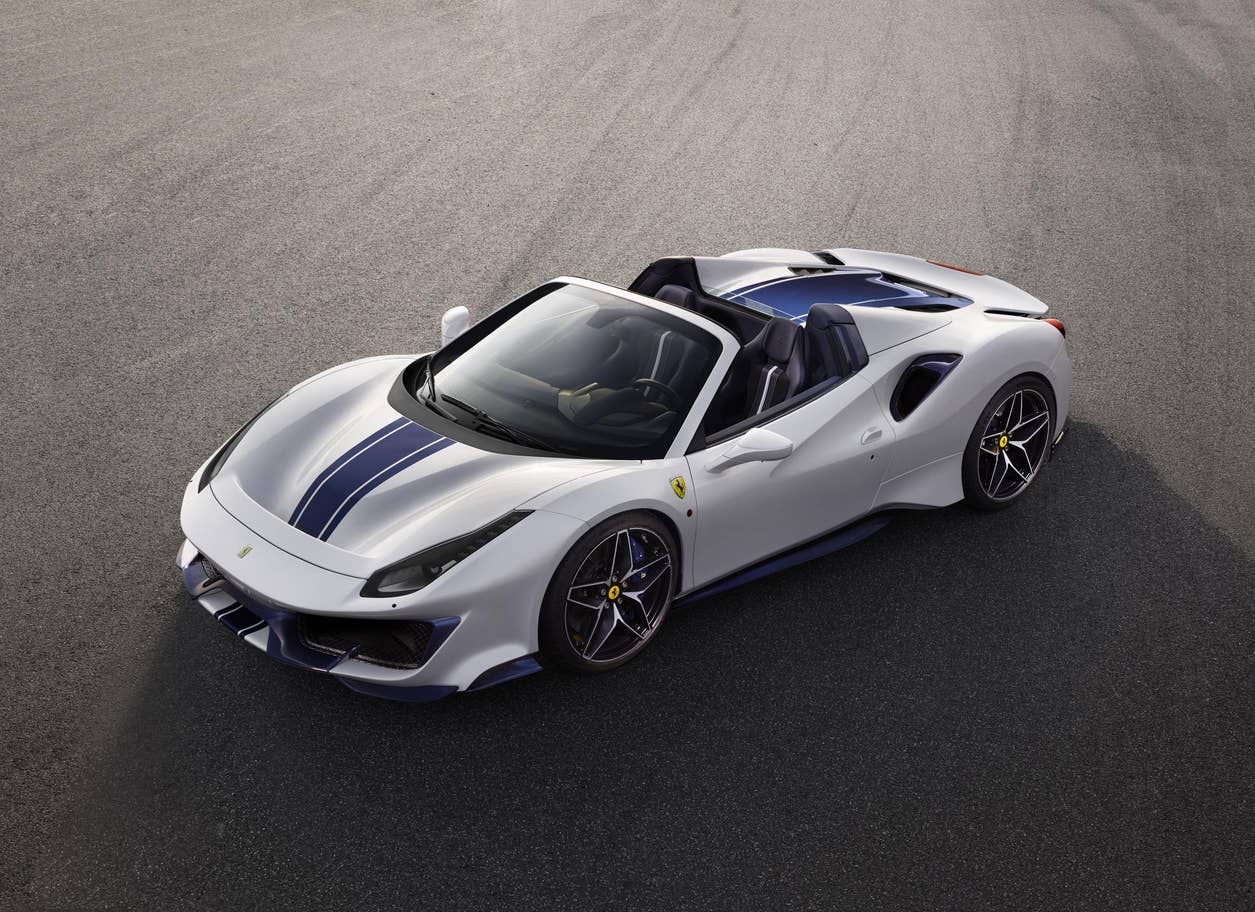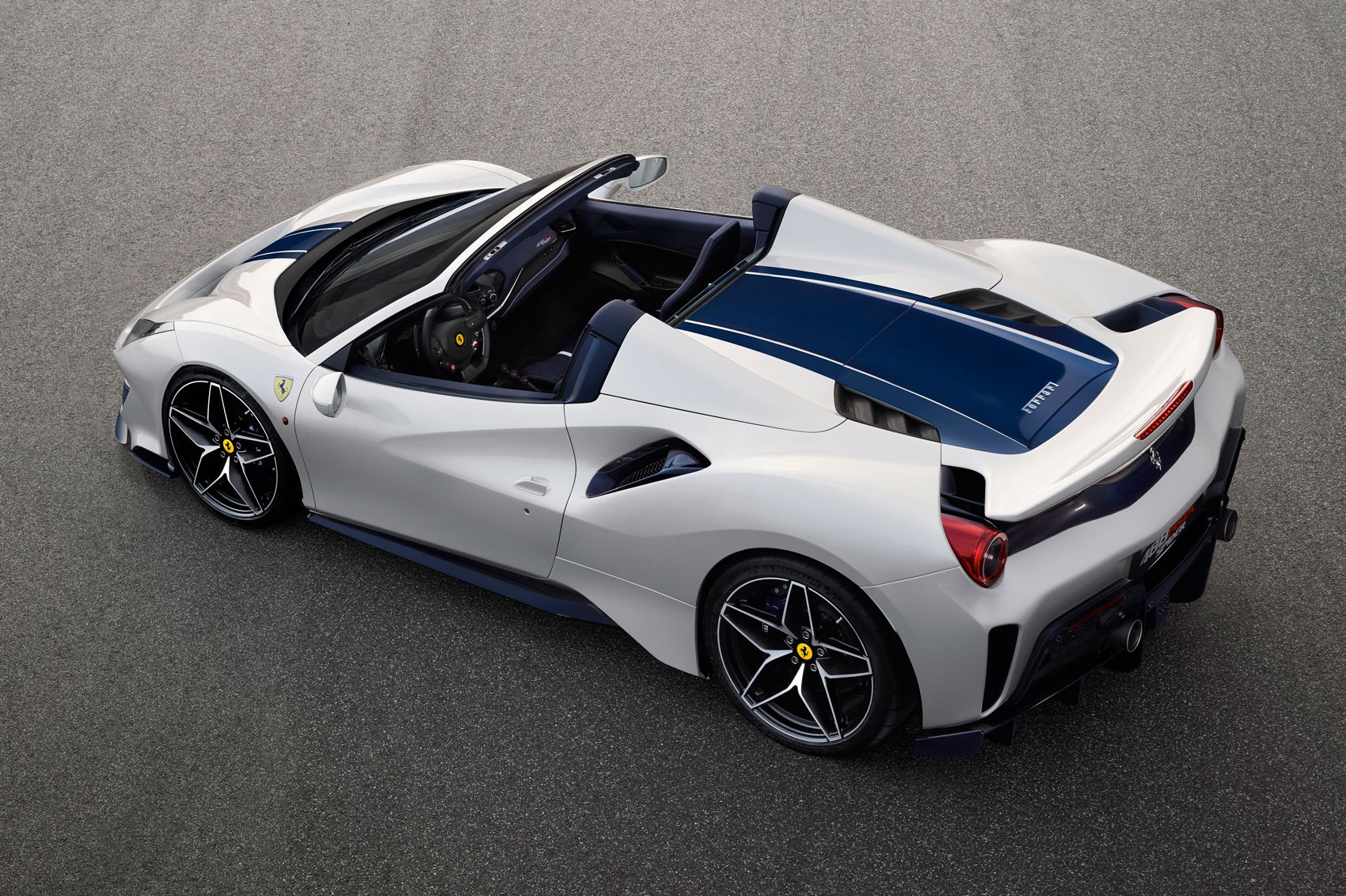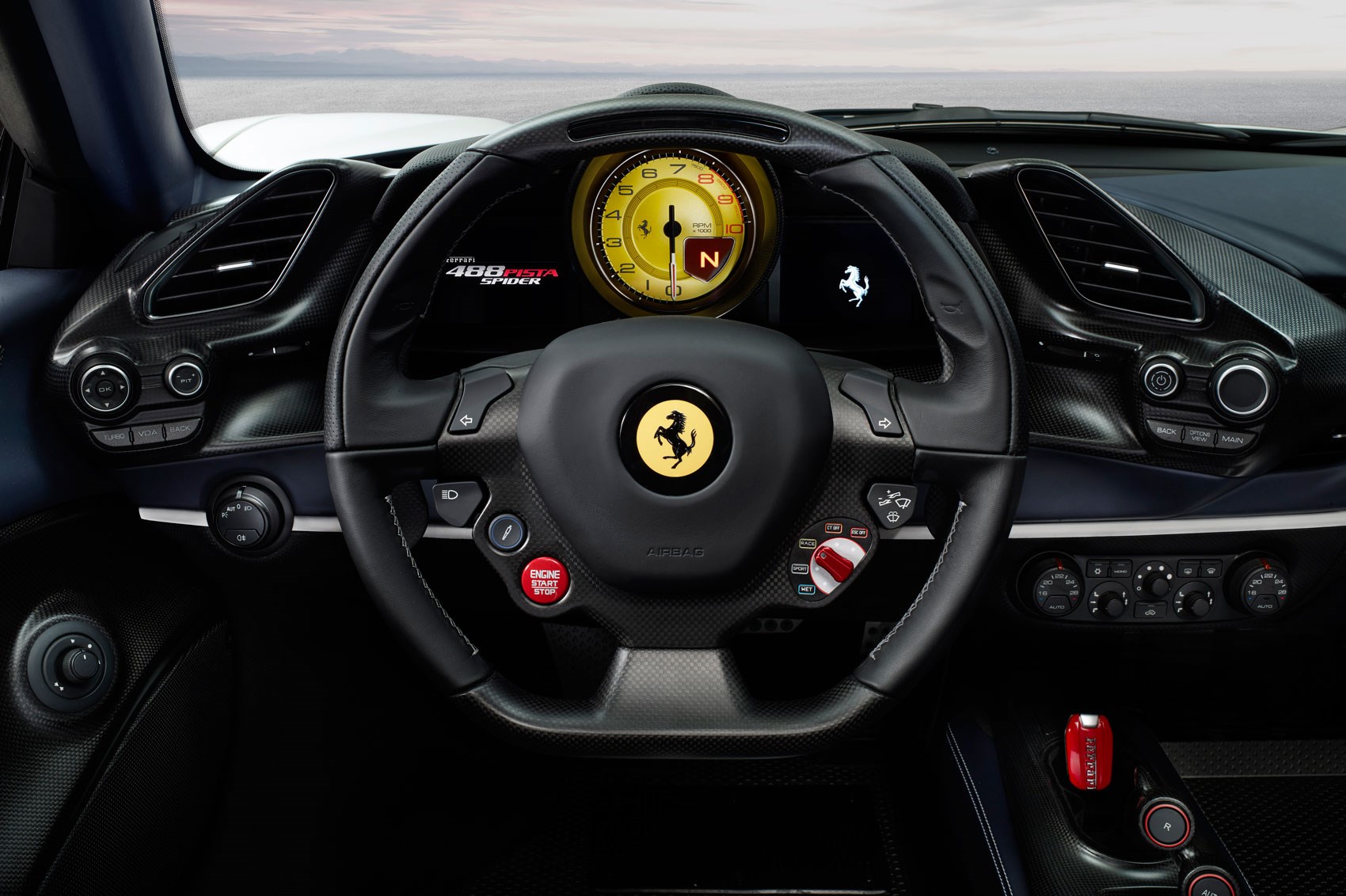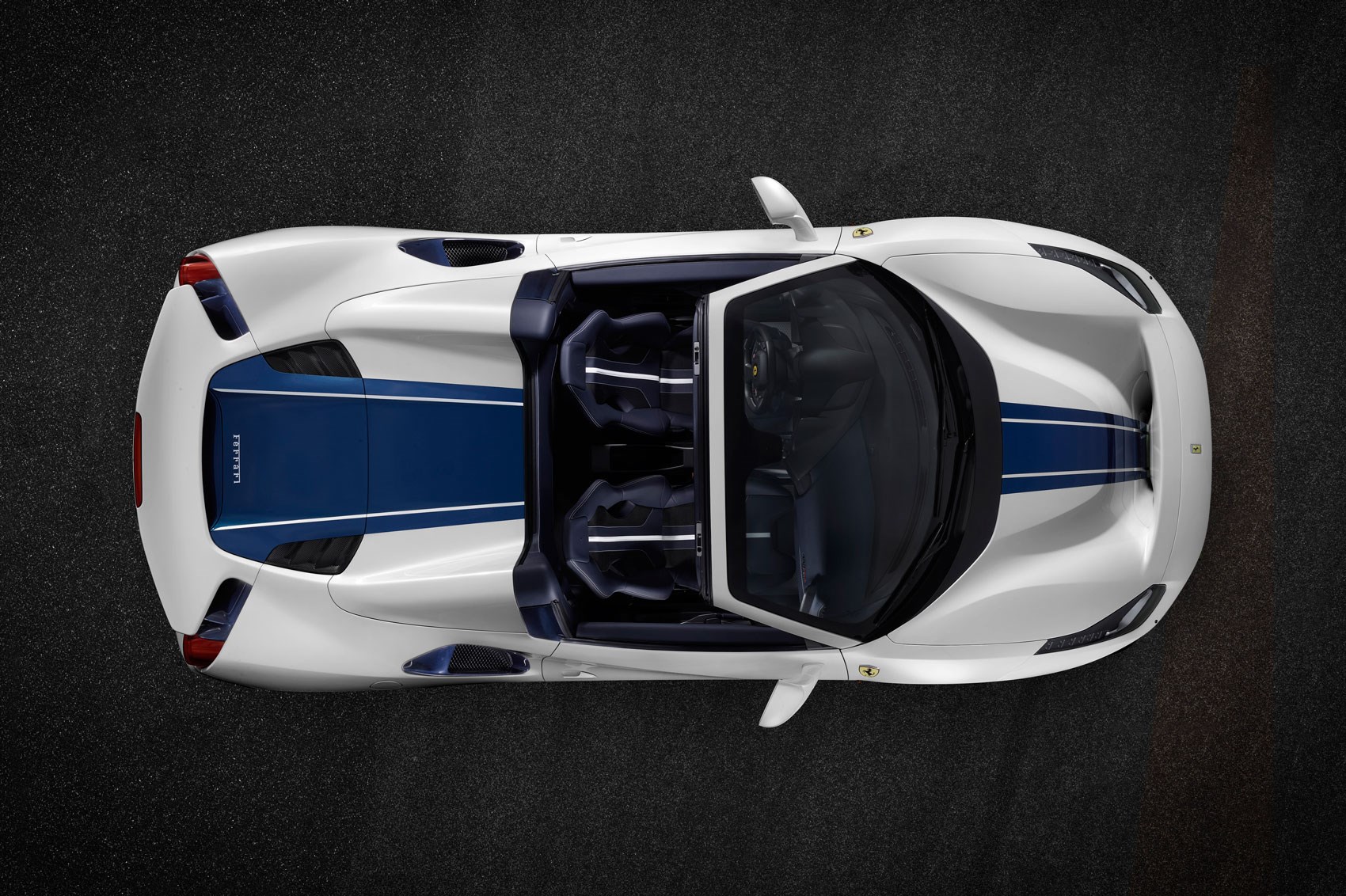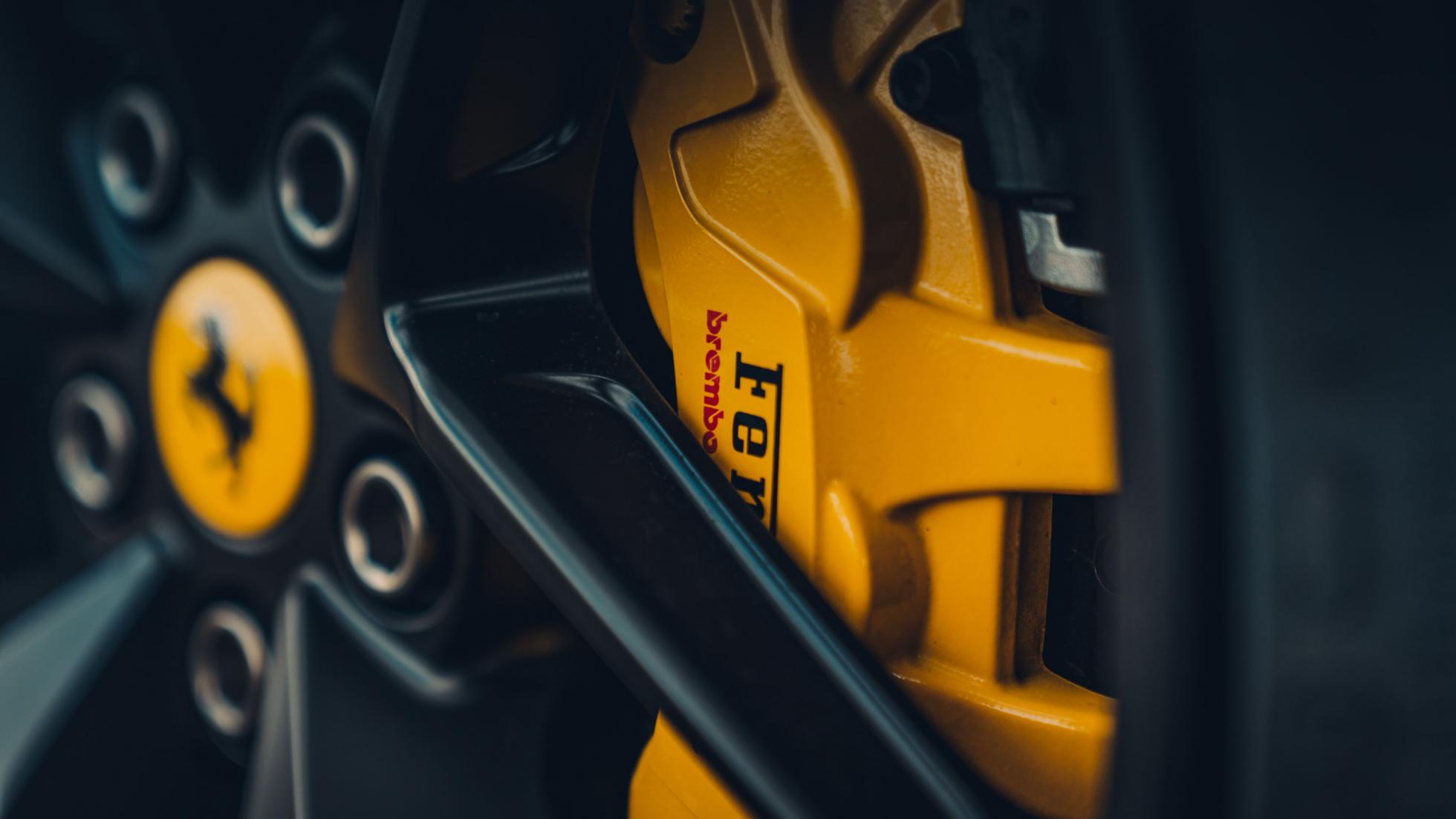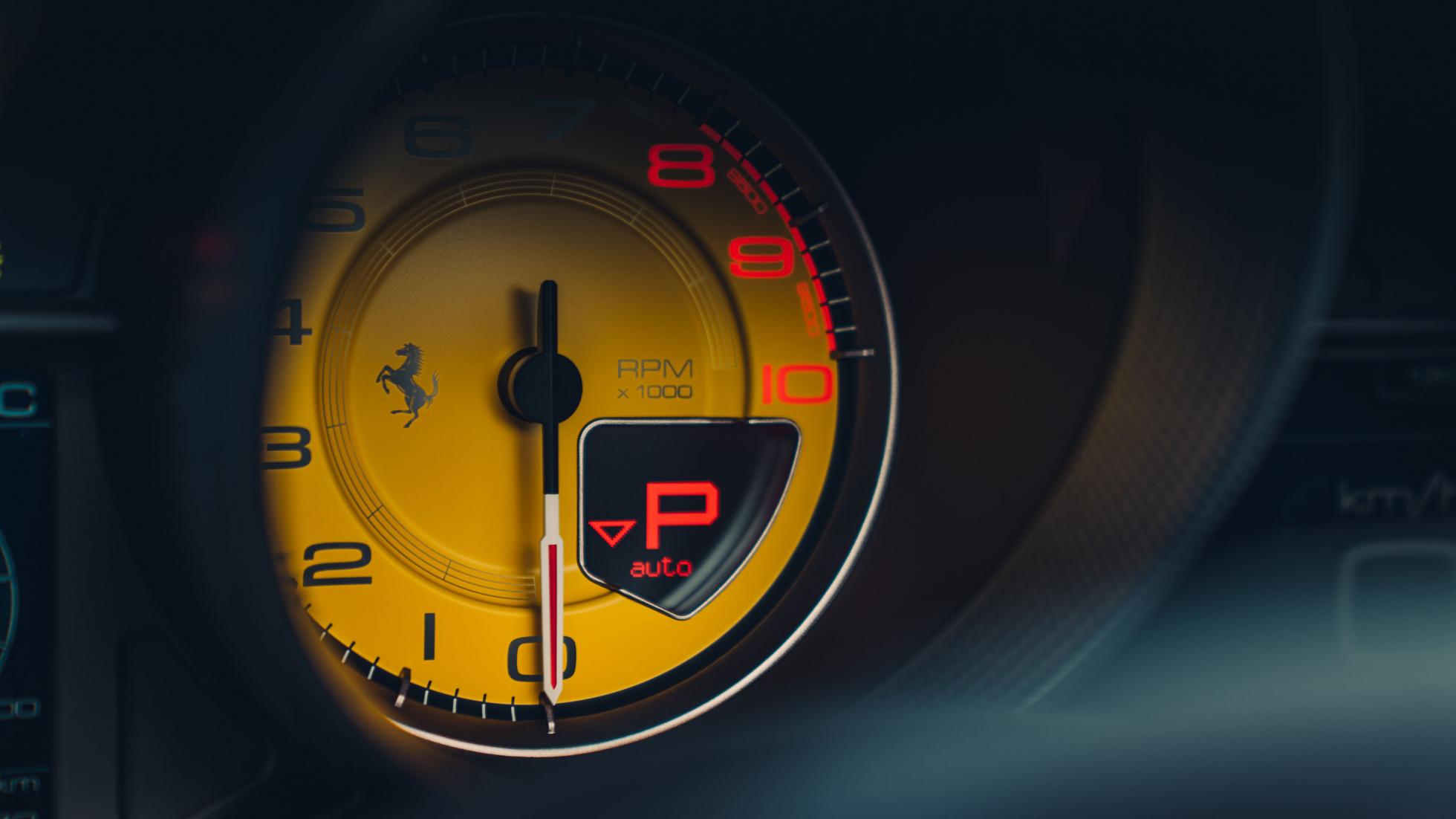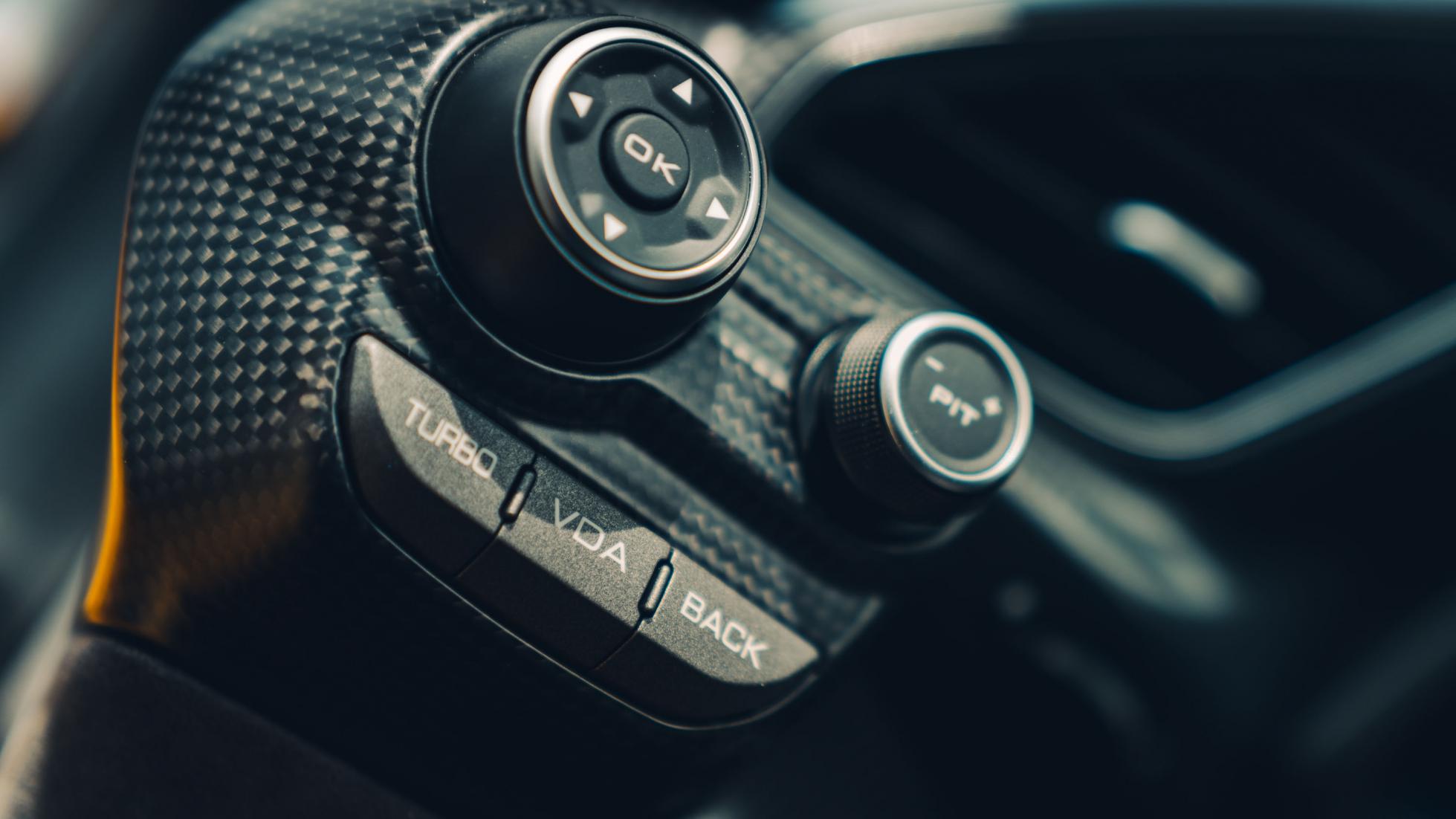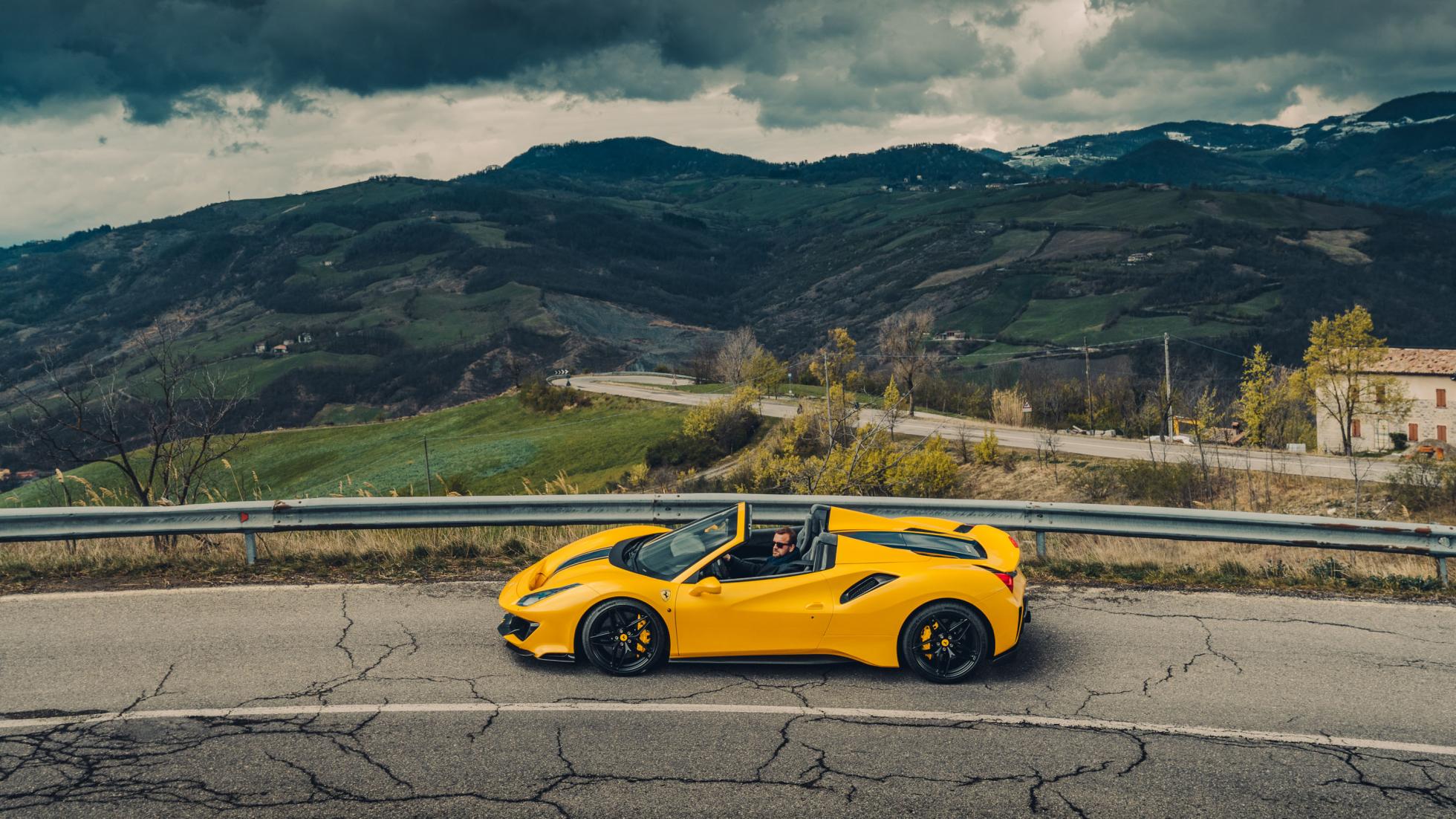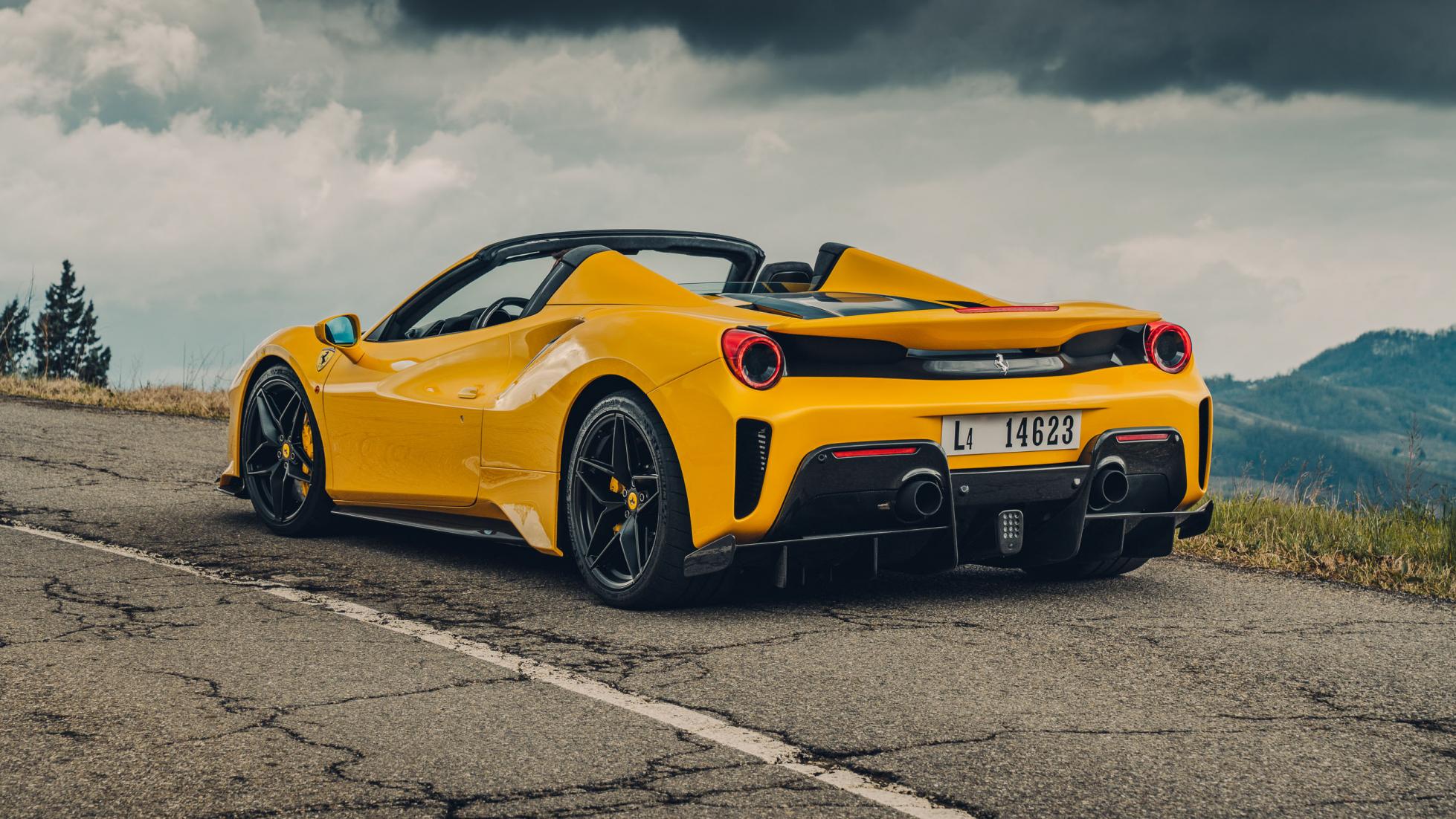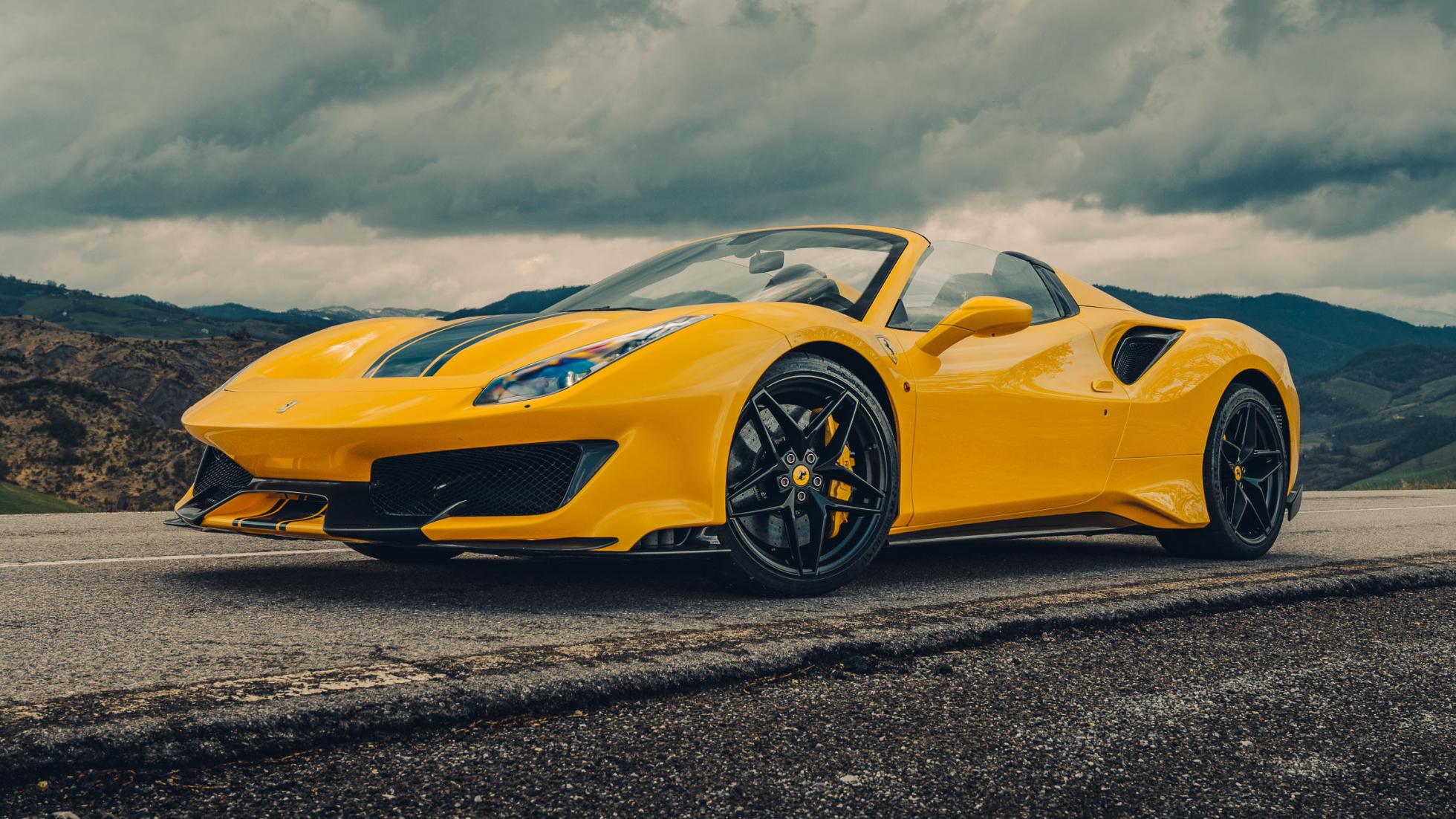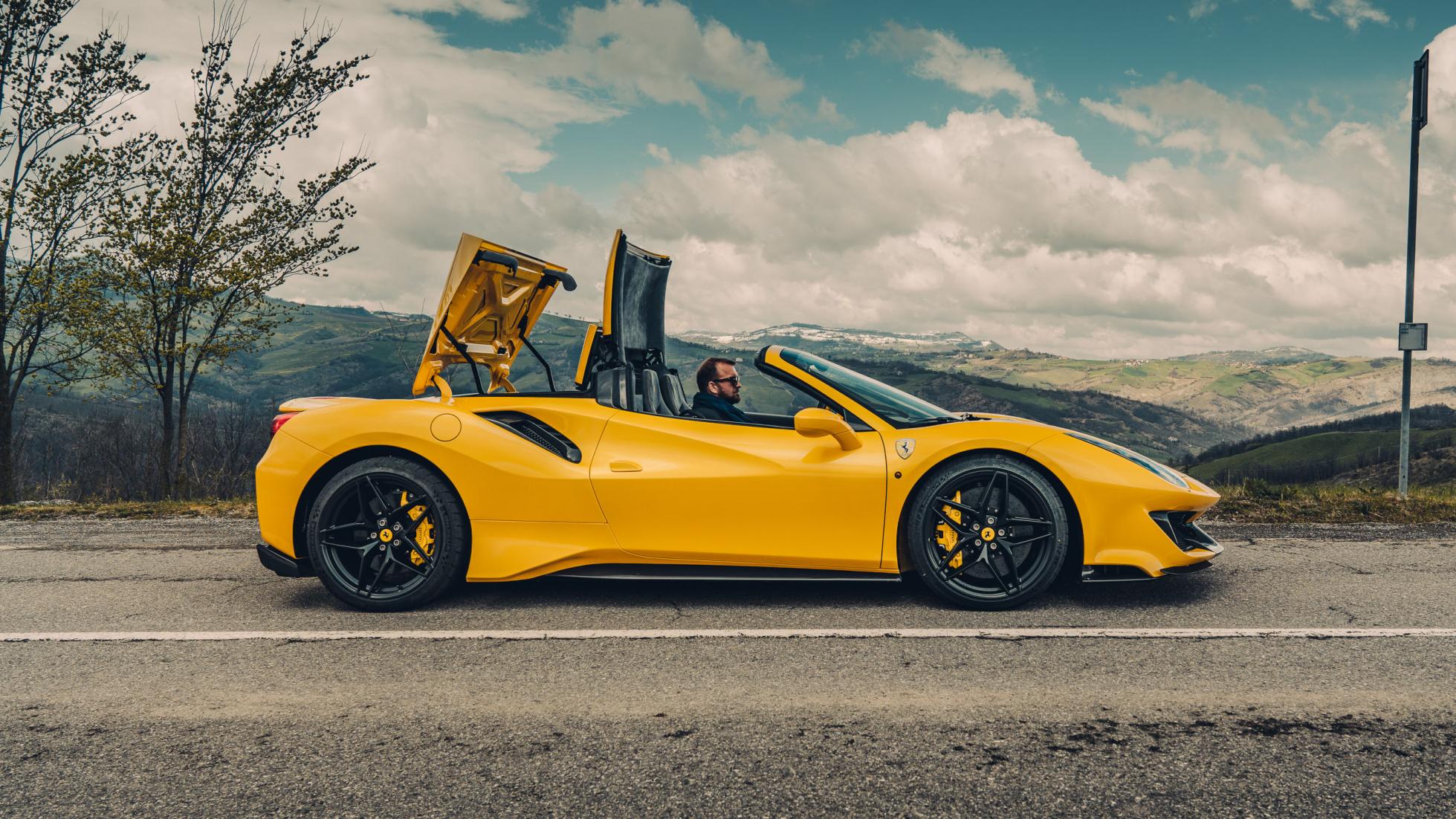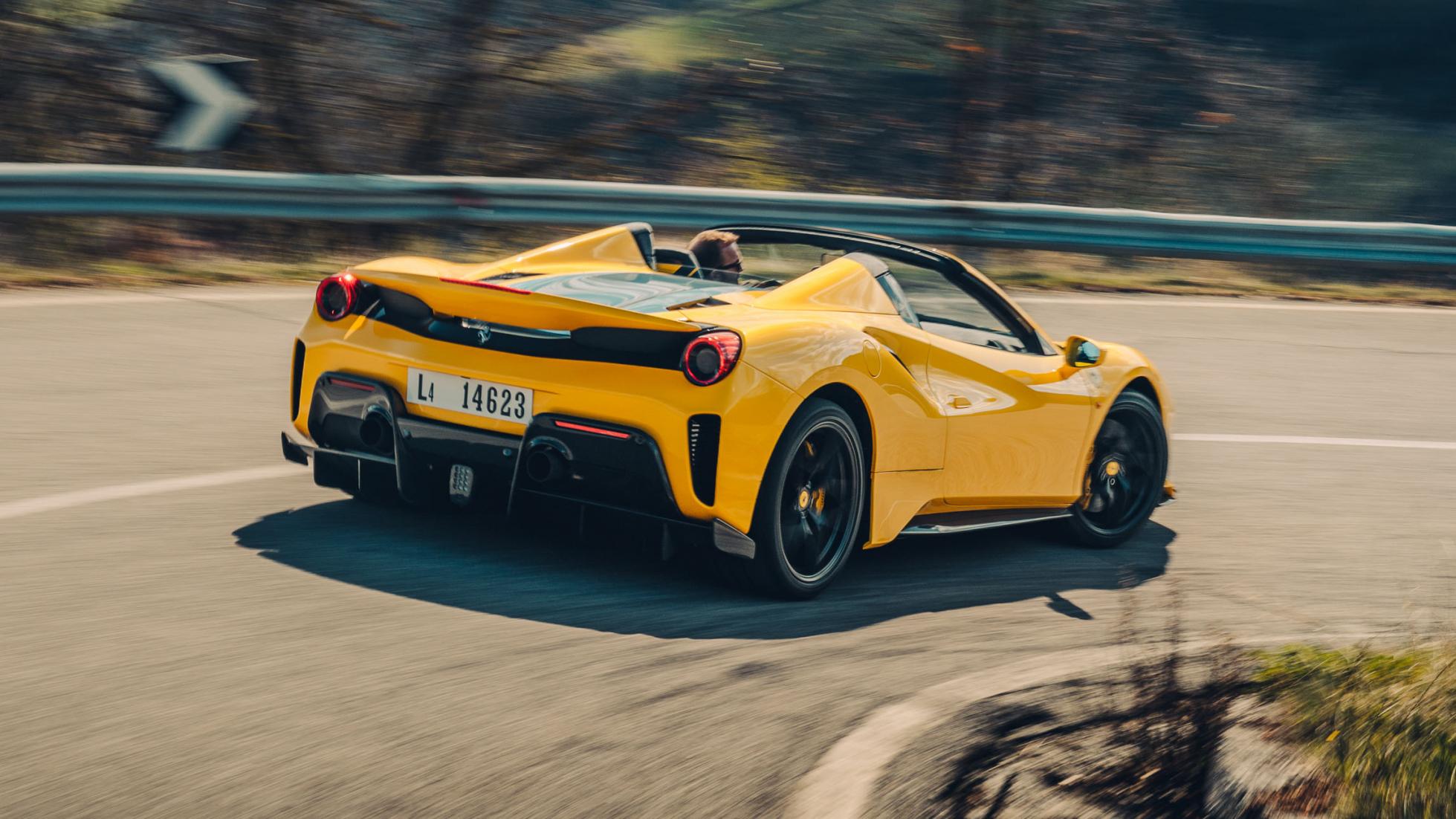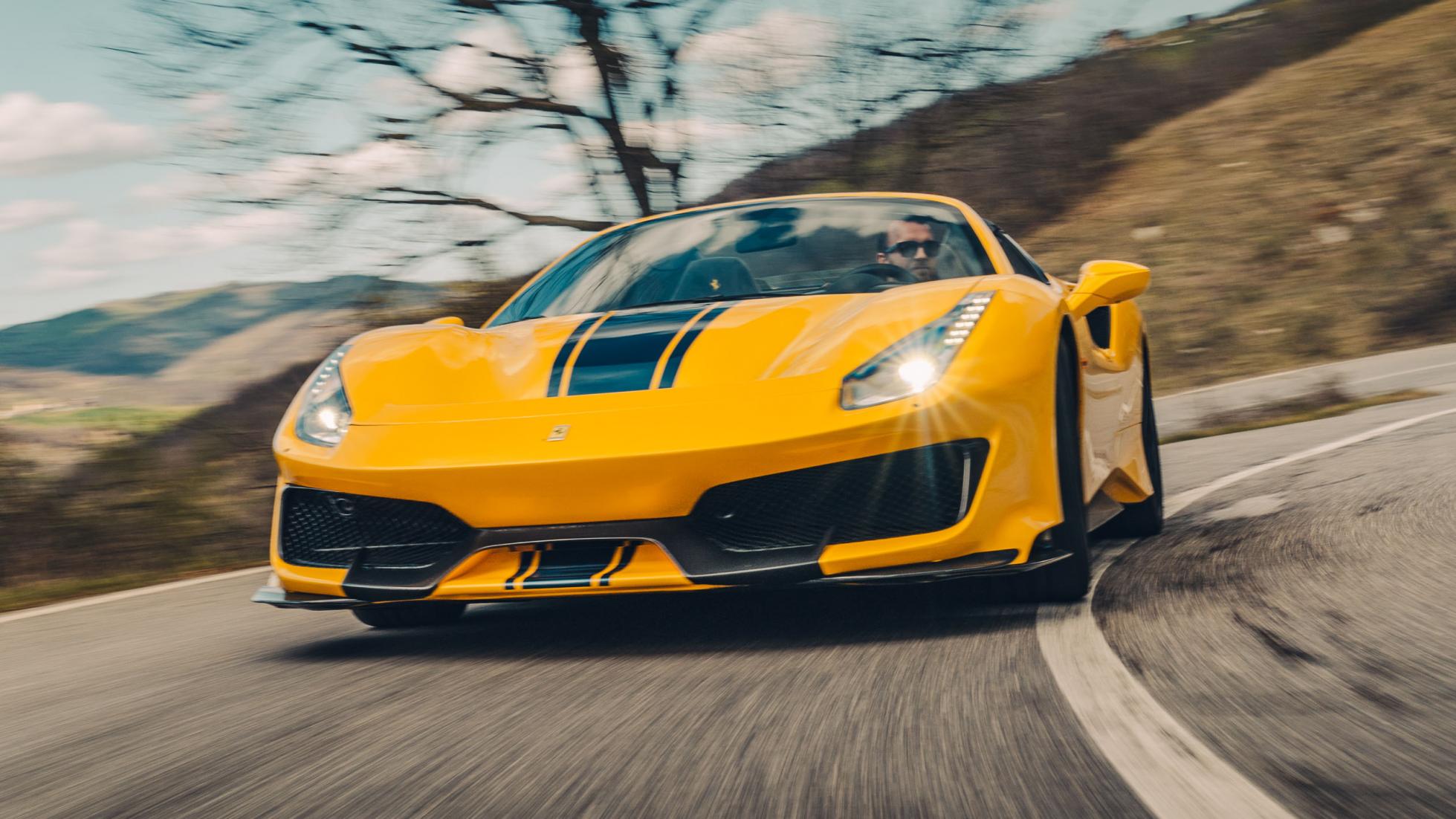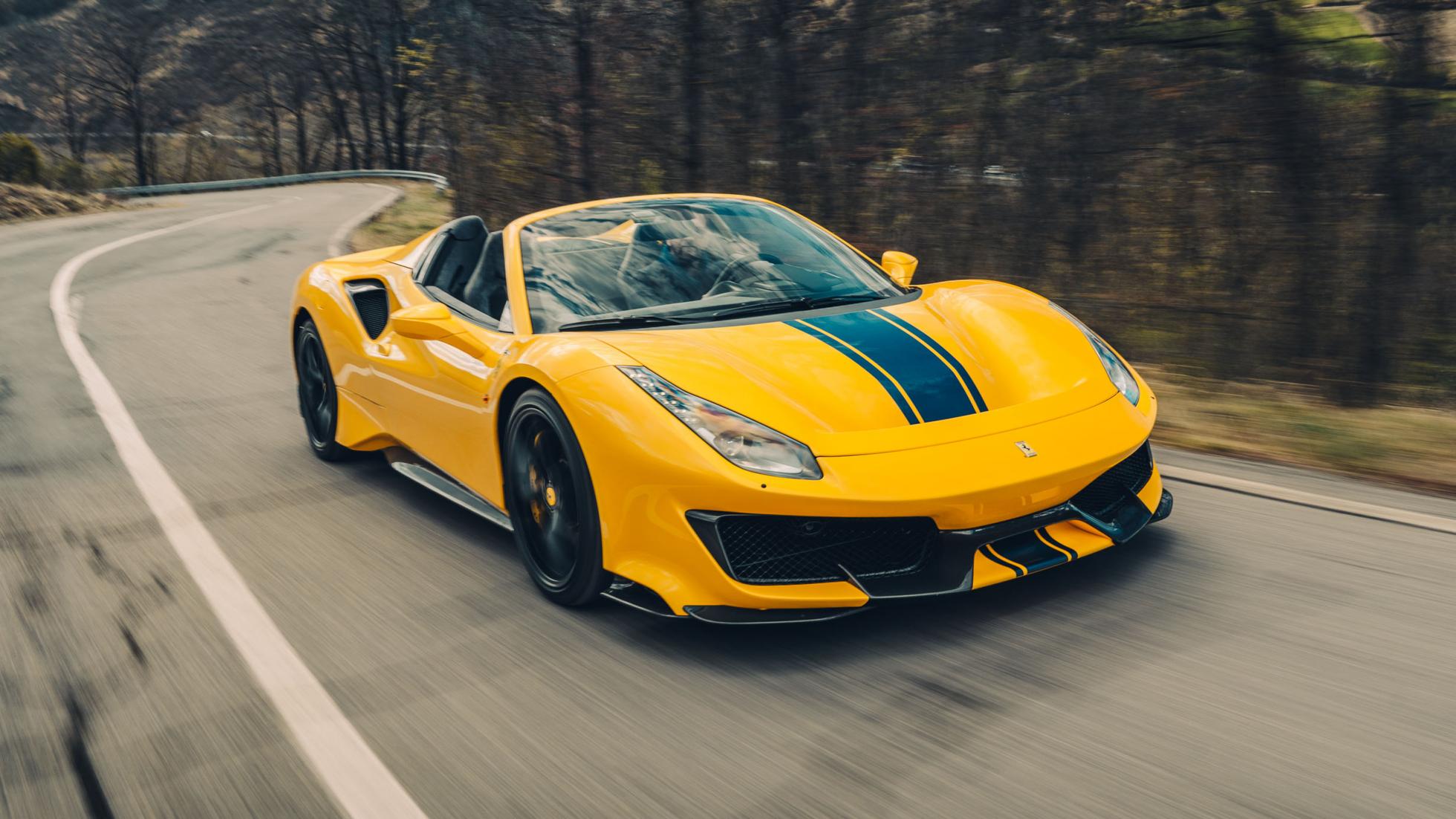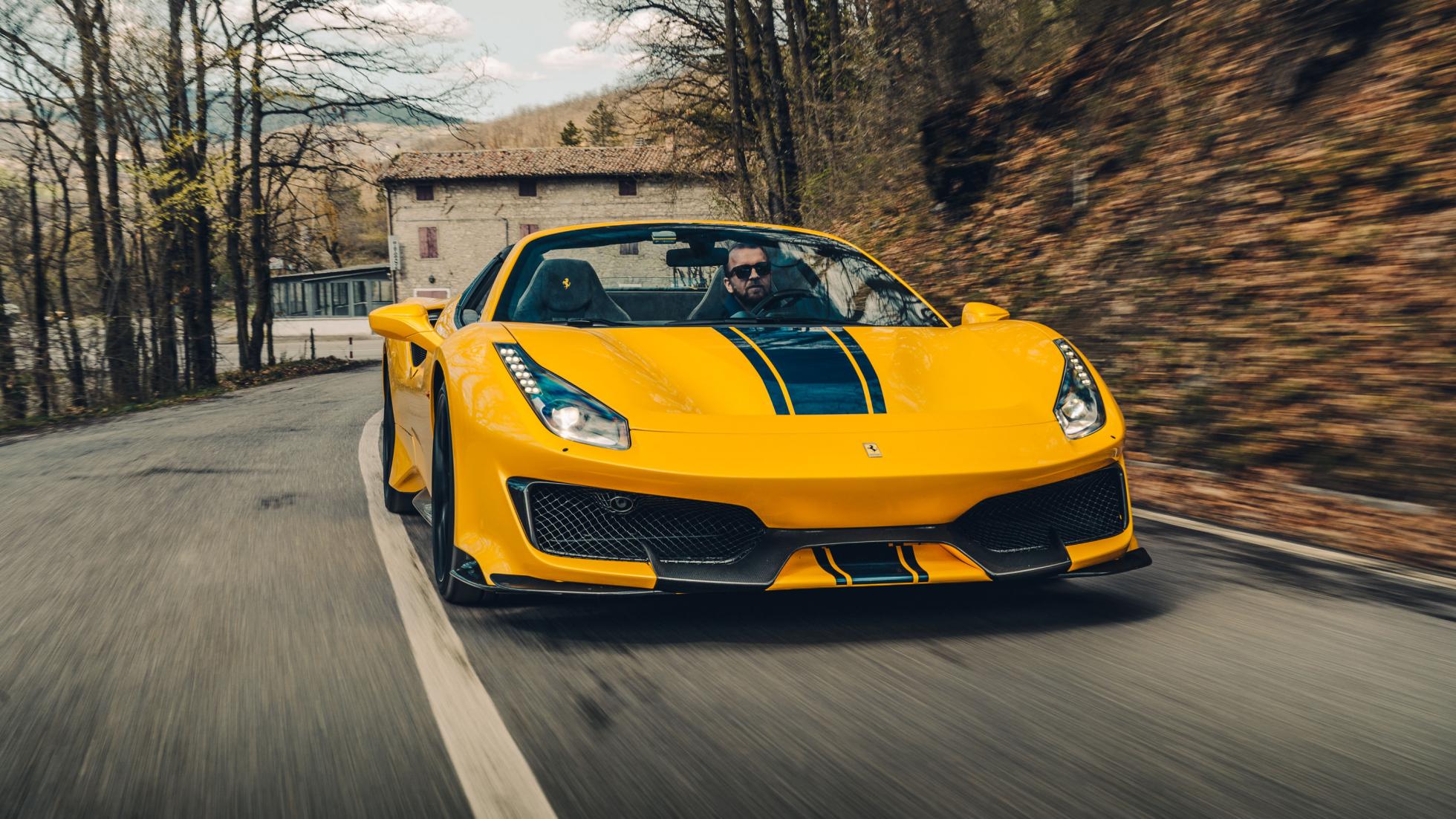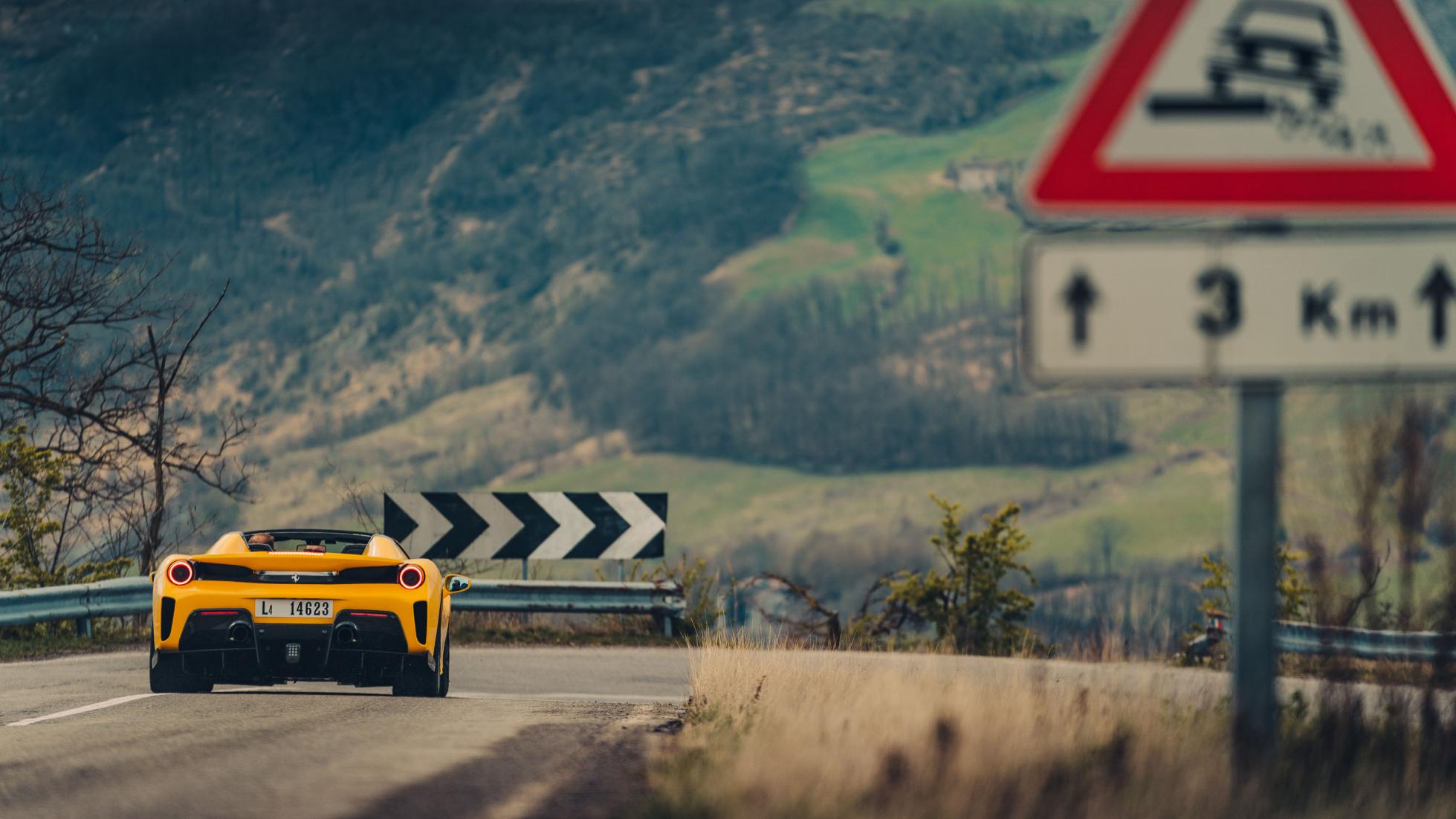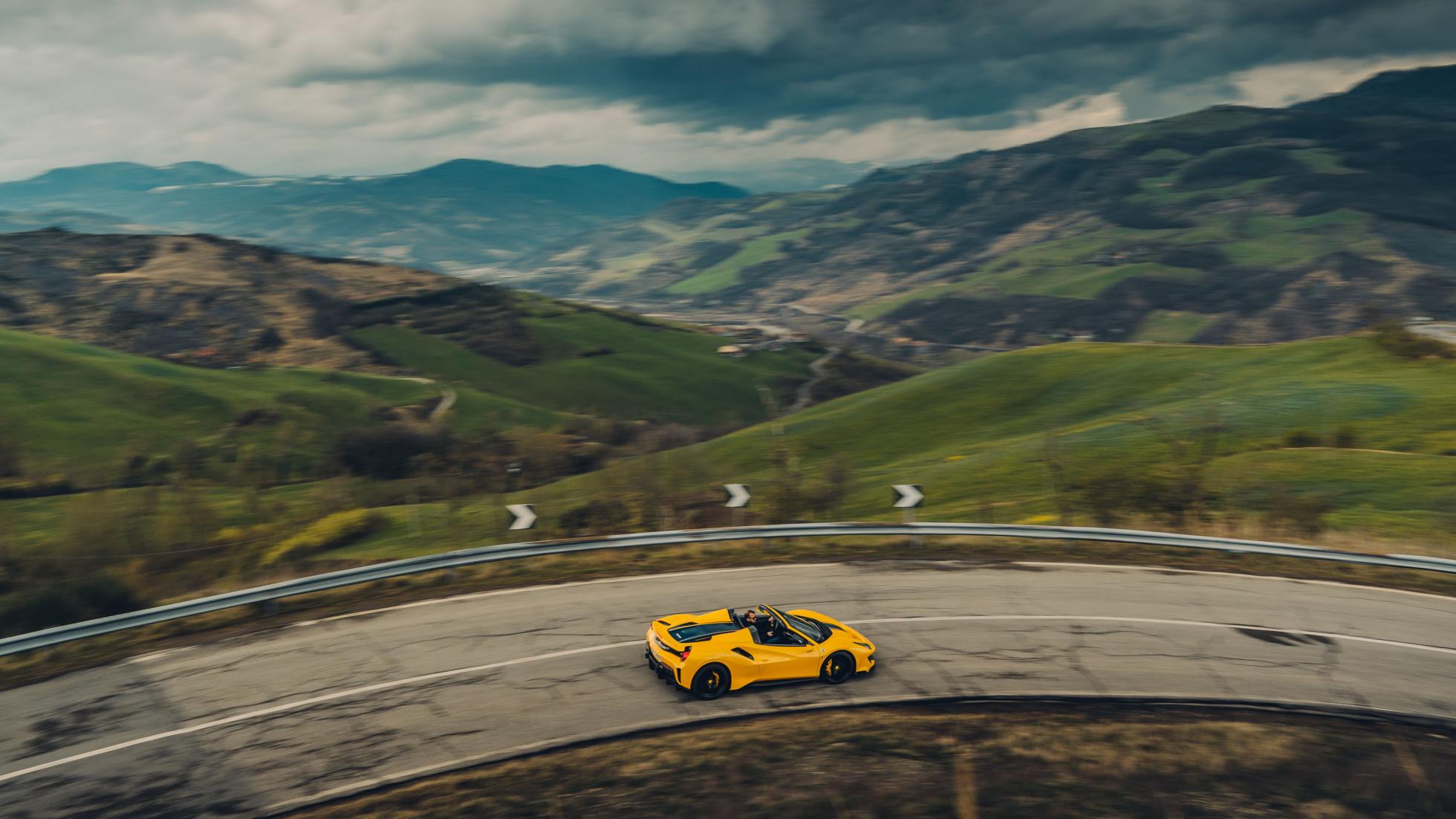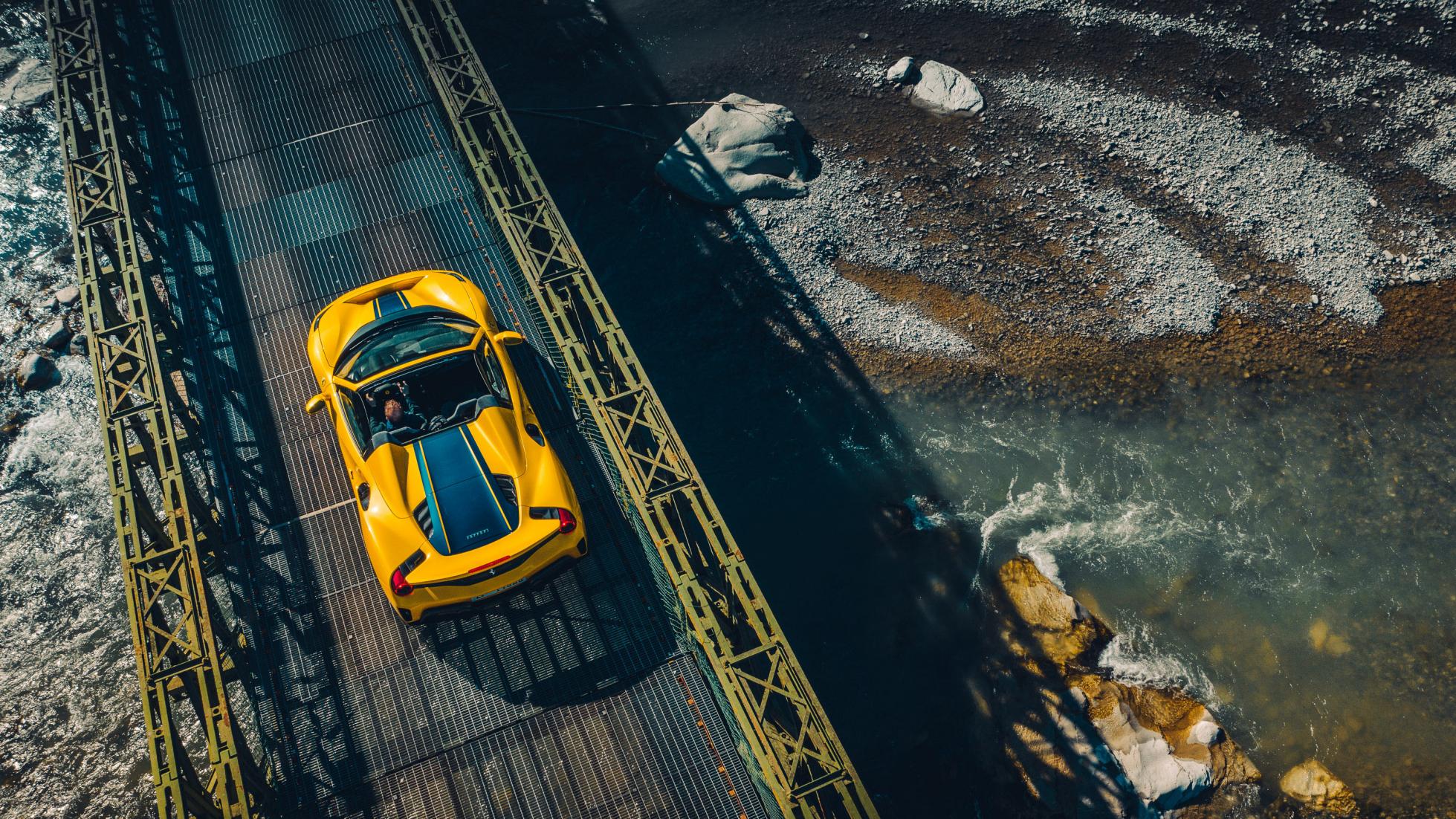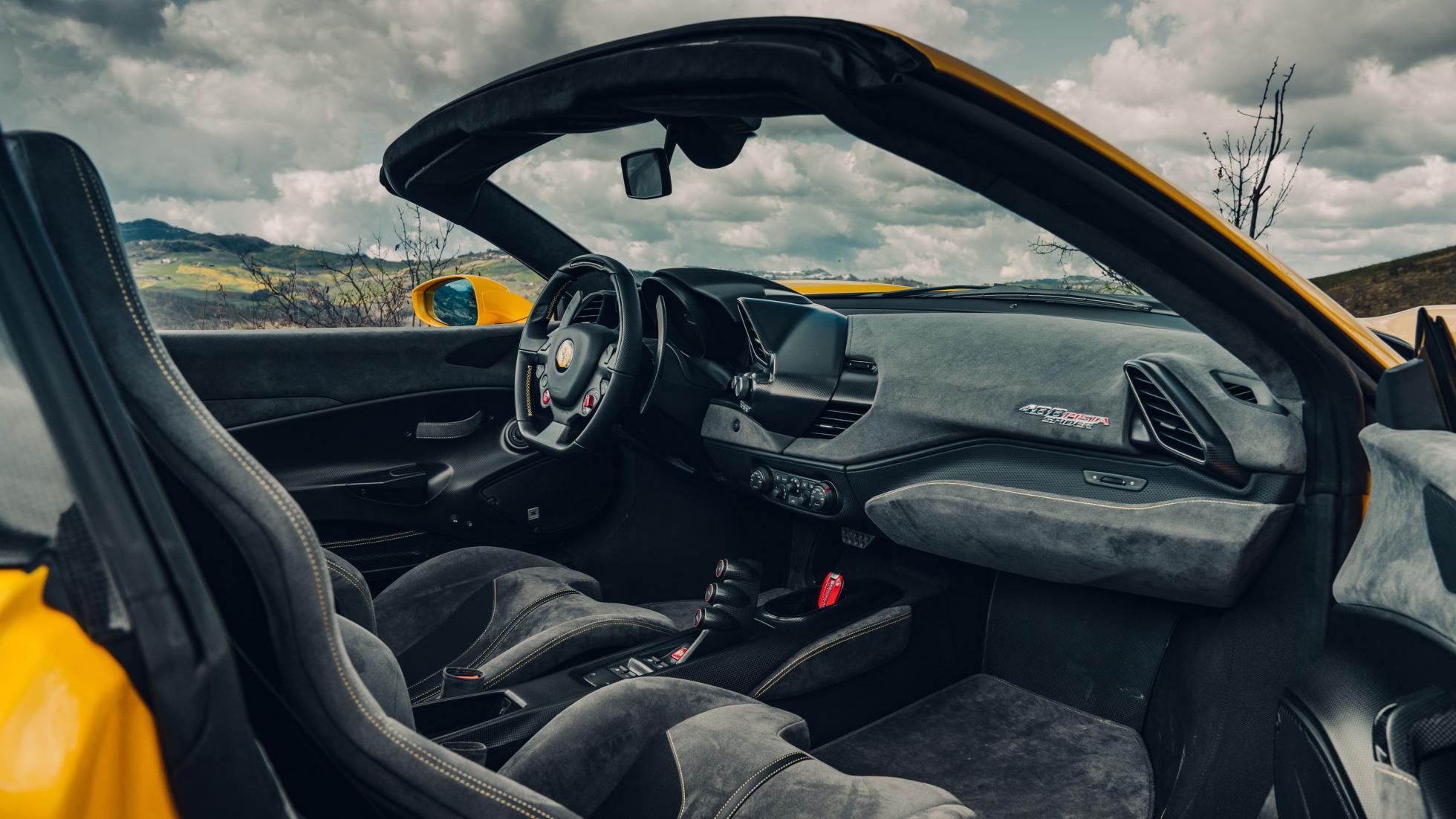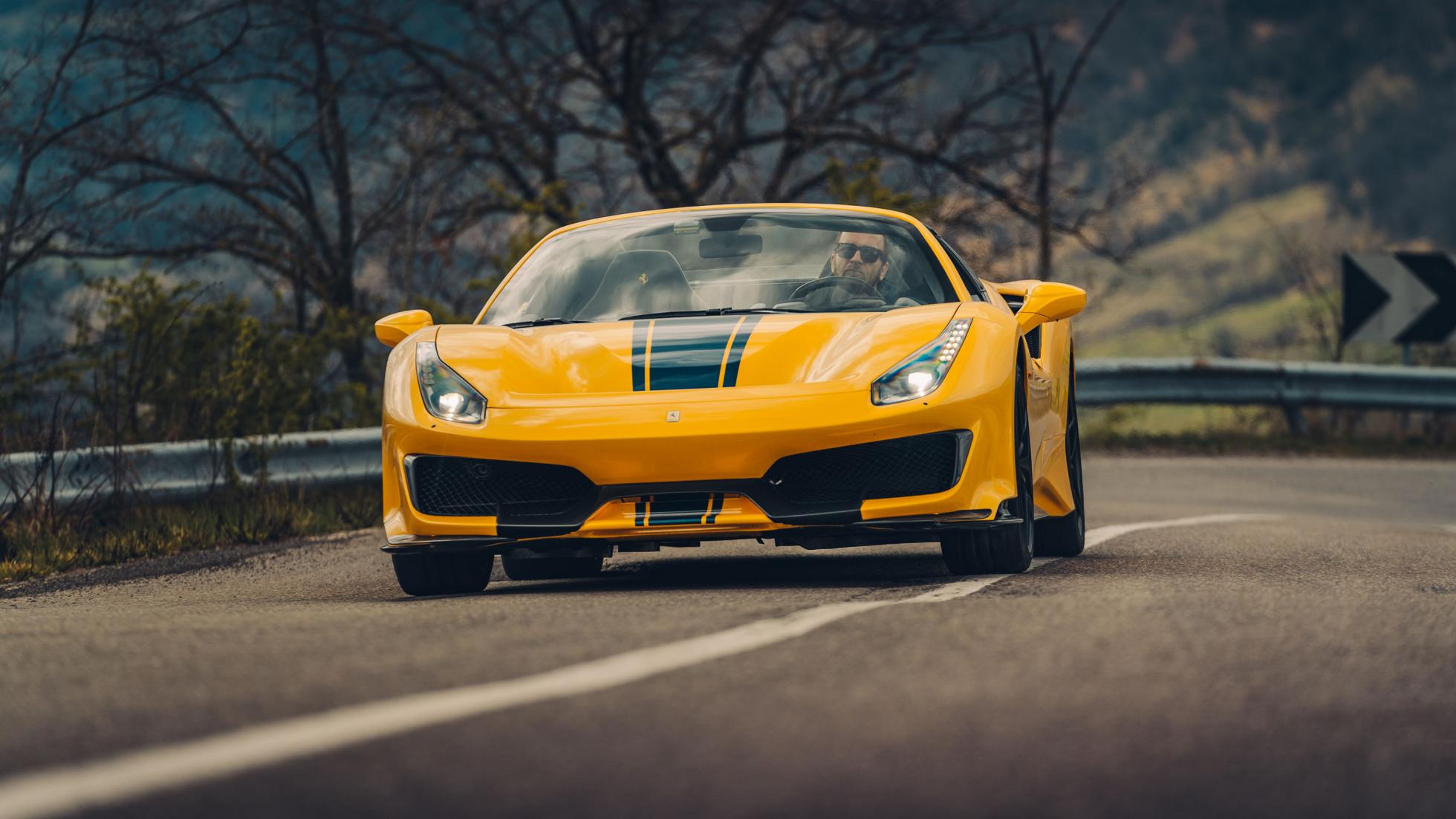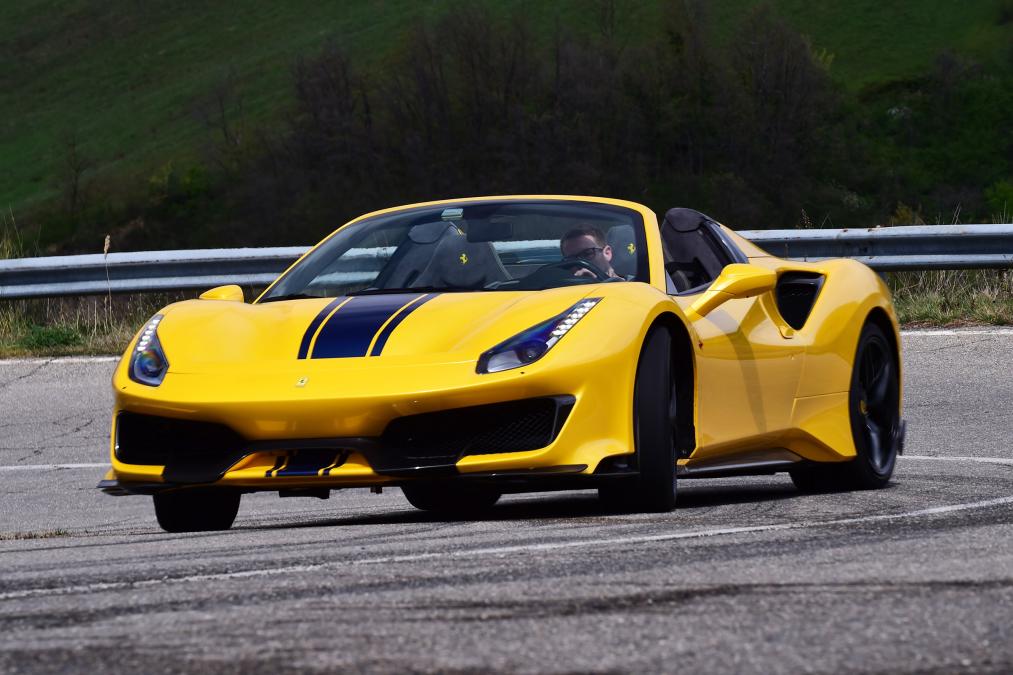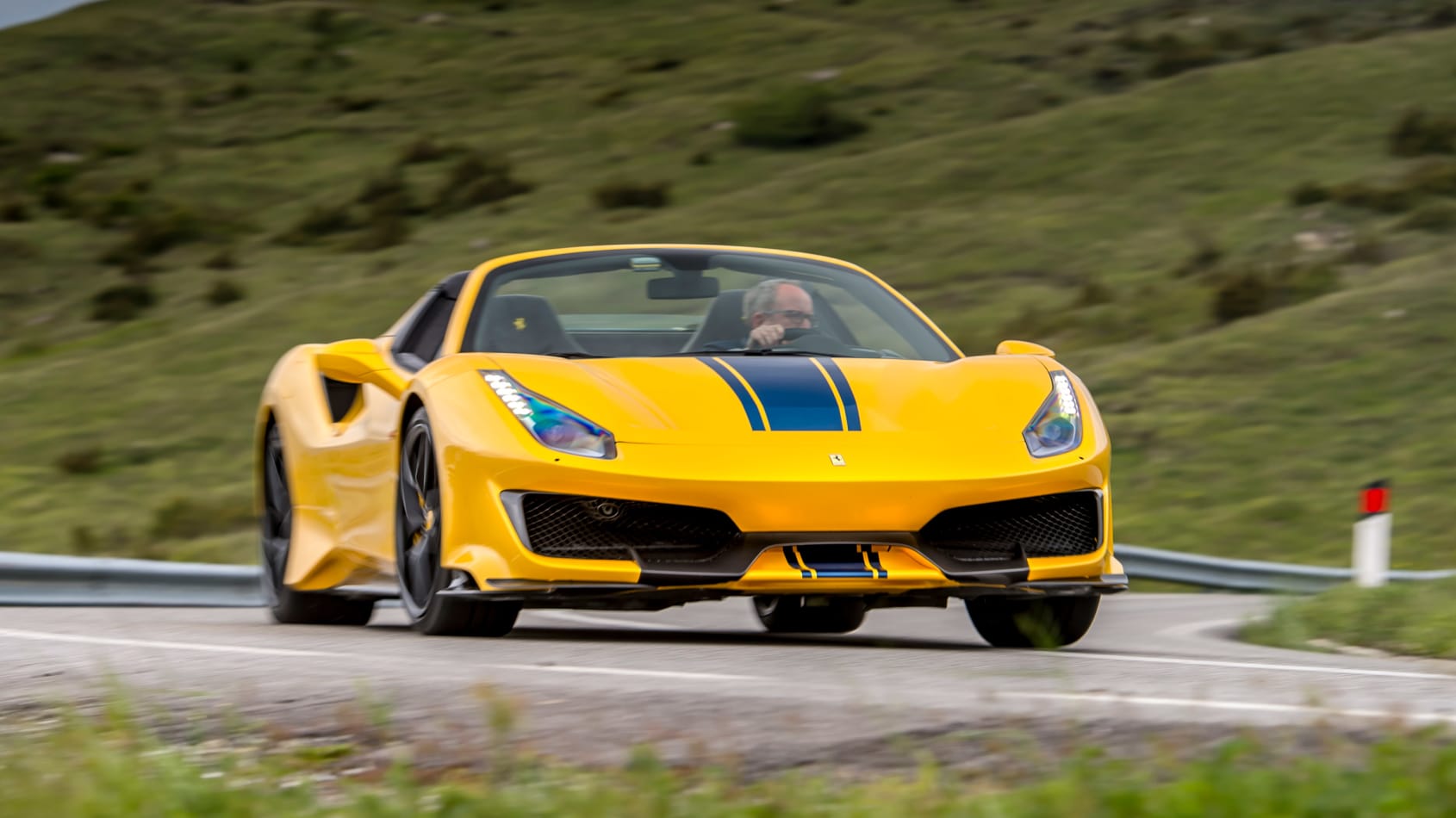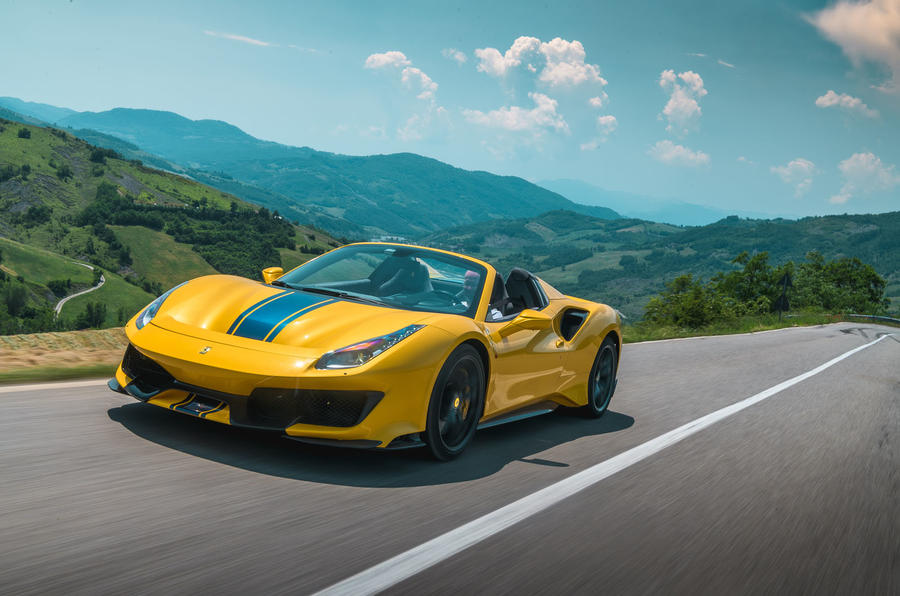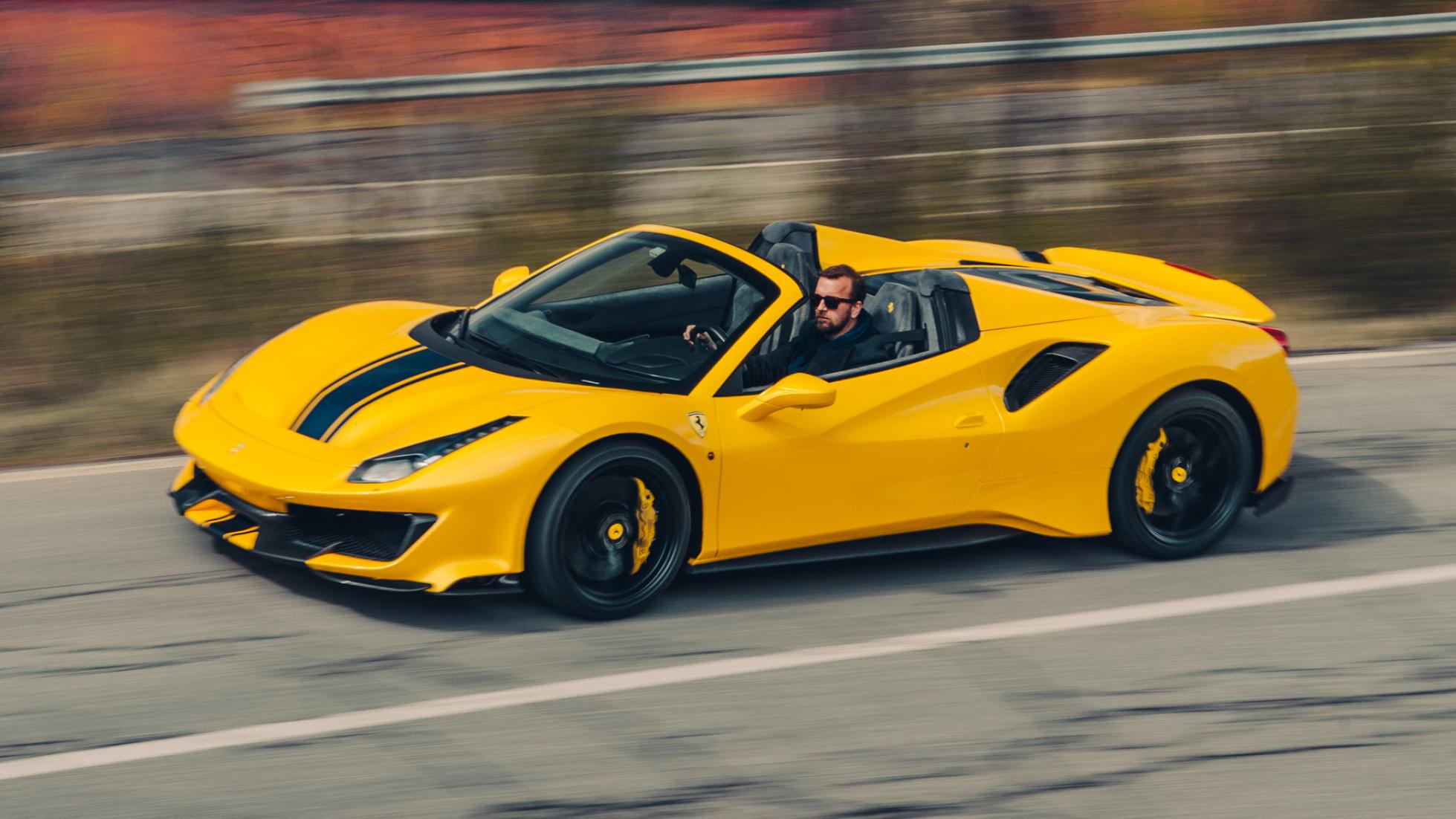Ferrari 488 Pista Spider
Introduction
Back in May 2018, I had the pleasure of reviewing the 2019 Ferrari 488 Pista – Ferrari’s most powerful V8 ever. The 488 Pista is the marque’s latest Special Series model and – following in the footsteps of its predecessors – epitomizes the pinnacle of Ferrari road cars.
Ferrari’s 488 Pista takes the “regular” 488 GTB to the next-level; even more so than what previous special series cars did for their respective standard models. The Pista is the beneficiary of an abundance of dynamics and technologies carried over from competitive racing, most notably in the FIA World Endurance Championship (WEC).
Ferrari 488 Pista Spider
Ferrari decided to surprise the world by unveiling the 488 Pista Spider at the Pebble Beach Concours D’elegance event in California later that year in August. The Spider is a convertible version of the 488 Pista coupe, and comes with a removal hardtop; though some would argue it functions more like a targa top vehicle. Ferrari also revealed that the new 488 Pista Spider would become the 50th convertible model in the company’s history.
Performance-wise, the Spider is indistinguishable from the coupe, sharing the same twin-turbocharged 3.9L V8 engine. In spite of its 100kg weight penalty – the result of the electronically-mechanized retractable roof and its components – the Spider still manages identical performance feats as the coupe, with a 0-100 km/h time of 2.85 seconds and a top speed of 340 km/h with the top up.
Besides the roof, the Spider visually differentiates itself from the coupe with an array of unique aerodynamic enhancements – all necessary changes to ensure that the Spider remained shoulder-to-shoulder with its fixed-top variant at the racetrack. The Spider is also fitted with its own special livery.
Year of the Spider
Not long ago, shearing the roof off a fixed-top supercar to make it a convertible was quite frankly, sacrilege from a performance point of view. Diminished structural rigidity, noticeably increased weight, less desirable body lines – sacrifices made for the open-top driving experience, which often resulted in an awkward, clumsy mess, really.
Such negative connotations are being duly rectified these days, with a movement of modern day supercars which is spearheaded by the world’s top exotic automakers, inevitably involving the Ferrari brand. The Ferrari 488 Pista Spider is one such car that could rule them all, in this specific regard. ‘Spider’ has also become the default moniker for which Ferrari identifies convertibles which are derived from their coupe versions.
Engine & Drivetrain
The Ferrari 488 Pista Spider is powered by the same engine used in the coupe – a twin-turbocharged 3.9L V8 which produces a magnificent 711-horsepower @ 8,000 rpm and 568 lb-ft of torque @ 3,000 rpm.
In relation to the Ferrari brand as a whole, this revised power plant is the most powerful V8 engine produced during Ferrari’s long history of building some of the world’s fastest cars. This translates to performance figures of 0-100 km/h in 2.85 seconds, 0-200 km/h in 7.6 seconds and a top speed of 340 km/h.
Respective to the standard 488 GTB model’s award-winning engine, the overall increase of 49 horsepower and 7 lb-ft of torque is achieved by borrowing engine parts from the 488 Challenge race car – such as Inconel exhaust manifolds, strengthened pistons, a larger intercooler, and a new camshaft.
Mated to the illustrious V8 engine is a 7-speed dual-clutch transmission – also carried over from the coupe – which can bang through each gear in as little as 30 milliseconds when driven in race mode setting.
Ferrari proudly remarks that “the engine sound is unique and unmistakably Ferrari, as such a special car warrants”.
Chassis & Handling
The Ferrari 488 Pista Spider weighs 200 pounds more than the coupe, but despite the extra hardware needed to accommodate the removable hardtop, it is remarkably still able to achieve nearly identical performance metrics. This is in a huge part due to proper aerodynamic augmentations, which allow the Spider to reach a top speed of 340 km/h, so long as the hardtop remains on.
Elsewhere on the car, the Spider differentiates itself from the coupe by way of a larger front splitter, a new deck lid and side skirts, and a redesigned rear diffuser. The Spider is also fitted with special livery – a central stripe that runs the length of the car which Ferrari proclaims, “recalls the movement of the airflow and exalts the lines of the car”.
Ferrari continues to equip the Spider with version 6 of their Side-Slip Angle Control System (SSC). This vehicle dynamics system is able to simultaneously control the electronic differential, traction control, magnetic damping and brake pressure software, with perfect synergy. The brake pressure software, dubbed “Ferrari Dynamic Enhancer” or (FDE), is a world-first system which can adjust brake pressure at the calipers.
The car’s overall development is mainly derived from Ferrari’s involvement in the FIA World Endurance Championship (WEC), where its 488 GTE and 488 Challenge race cars have competed and won numerous Manufacturers’ titles.
With such favorable genetics to borrow from, the Pista – and by extension, the Pista Spider – is much more than just a horsepower bump and stickier tires. Thanks to untethered access to the race team’s parts bin, the Pista Spider manages to have 20 percent more aerodynamic efficiency compared to the regular 488 Spider courtesy of some active aero bits. Ceramic brakes and Michelin Pilot Sport Cup 2 tires also come as standard fare on the Pista Spider, as well as a specially tuned active suspension with stiffer springs.
The end-goal, Ferrari says, is to “offer impeccable track-like performance on and off the road, even when in the hands of non-professional drivers”.
Shortly after an unveiling at Ferrari’s private racetrack – Fiorano Circuit near Maranello, Italy – the Pista coupe completed a lap with a time of just 1:21.5; a noteworthy 1.5 seconds faster than what a Ferrari 488 GTB could manage around the circuit. The Pista Spider is expected to be no less rapid.
Design & Interior
The most obvious design element to mention on the Ferrari 488 Pista Spider, would be its electronically operated retractable hard-top mechanism which open or close while travelling up to 30 mph. While being ultimately responsible for the 100 kg weight increase over the fixed-top variant, the Spider’s performance remains virtually unaffected.
Large credit to that outcome comes from the Spider continuing to be heavily influenced by the 488 GTE race car’s aerodynamics. This means that a number of features – such as F1-inspired S-ducts, an optimized front air splitter, and modified vortex generators and rear diffuser – all combine to improve downforce, while minimizing drag and turbulence.
Keeping with the beat, the Spider is no different from the Pista inside the cabin, which inevitably translates to an ergonomically proficient cockpit surrounded in carbon fibre fixings. The Spider also features a unique racing livery that runs the entire length of the car; starting at the front bumper, then onto the S-Duct, before finishing at the rear spoiler. Other exclusive options such as one-piece carbon fibre wheels (in lieu of the standard also-unique-diamond-finish alloy wheels) will also be made available on the convertible.
Ferrari has openly acknowledged the popularity of convertibles – particularly in the U.S. – and will be incentivized to to appeal to their demand.
Pricing
The Ferrari 488 Pista Spider starts at £252,765, which is in excess of $350,000 USD equivalency. Ferrari has stated that all examples have been sold and spoken for, so the $400,000+ (after options, taxes, etc.) buyer’s will have to fork out for one, might end up being a reasonably sound investment should they also be in the business of flipping rare and exotic automobilia.
Specifications Summary
Engine |
|
| Configuration | 90º V8 |
| Location | Mid, longitudinally mounted |
| Construction | Aluminium block and head |
| Displacement | 3,902 cc / 238.1 cu in |
| Valvetrain | 4 valves / cylinder, DOHC |
| Fuel feed | Direct Fuel Injection |
| Lubrication | Dry sump |
| Aspiration | Twin Turbo |
| Power | 710 bhp / 530 kW @ 8,000 rpm |
| Torque | 770 Nm / 568 ft lbs @ 3,000 rpm |
| BHP/Liter | 182 bhp / liter |
Drivetrain |
|
| Front Brakes | Ventilated and cross-drilled discs, 398mm (15.7 in) |
| Rear brakes | Ventilated and cross-drilled discs, 360mm (14.2 in) |
| Gearbox | 7 speed Automatic |
| Drive | Rear wheel drive |
Dimensions |
|
| Weight | 1,380 kilo / 3,042 lbs |
| Length / Width / Height | 4,605 mm (181.3 in) / 1,975 mm (77.8 in) / 1,206 mm (47.5 in) |
| Wheelbase / Track (fr/r) | 2,650 mm (104.3 in) / 1,679 mm (66.1 in) / 1,649 mm (64.9 in) |
| Fuel tank | 78 Litre (20.6 Gallon US / 17.2 Gallon Imperial) |
| Wheels (fr/r) | 9 x 20 / 11 x 20 |
| Tyres (fr/r) | 245/35 – ZR20 / 305/30 – ZR20 |
Performance Figures |
|
| Power to weight | 0.51 bhp / kg |
| Weight distribution | 42% front / 58% rear |
| Top Speed | 340 km/h (211 mph) |
| 0-100 km/h | 2.8 s |
Picture Gallery & Videos
Images
Videos
Top Gear: Ferrari’s latest track special is the £250,000, 720 bhp 488 Pista, a turbocharged sequel to the sublime 458 Speciale. Chris Harris finds out if it lives up to its heritage.
Doug DeMuro: The Ferrari 488 Pista is an amazing Ferrari — and today I’m reviewing the 488 Pista to show you why it’s such a tremendously exciting car. I’m showing you inside the 488 Pista and I’m revealing all the Pista’s quirks and features, and taking it for a drive.
Autocar: The Ferrari 488 Pista is one of our absolute favourite supercars of the moment. It’s more focused and raw than the regular 488 GTB so has sensational handling, but is still perfectly capable and comfortable on poor roads. Now with a folding roof, then, the Ferrari 488 Pista Spider tries to retain all of those characteristics but with an open air experience too.
Ferrari Official: The new special 488 Pista Spider series, the 50th open-top model produced by the Prancing Horse, is the company’s highest ever performing Ferrari spider, with a record power-to-weight ratio of 1.92 kg/hp. It combines the finest race-developed technological solutions with the joy of en plein air driving to deliver an exhilarating experience behind the wheel.
Official Press Release
Meet the Ferrari 488 Pista Spider: the highest performance Prancing Horse drop-top ever
Paris, 2 October 2018
After its world premiere at the Pebble Beach Concours d’Elegance®, the new special series Ferrari 488 Pista Spider has made its European debut at the Paris Motor Show. The 50th drop-top model to be introduced by the Prancing Horse is also the most powerful series production spider in Ferrari history, with an unprecedented weight/power ratio of 1.92 kg/cv.
The Ferrari 488 Pista Spider combines the finest race-developed technological solutions with the joy of en plein air driving to deliver an exhilarating experience behind the wheel. The driver feels absolutely as one with the car in a symbiotic relationship that guarantees instantaneous responsiveness to commands and absolute control when executing even the most complex manoeuvres. This is hardly surprising as the Ferrari 488 Pista Spider benefits from the greatest technological transfer from the track of any road-legal open-top car.
The model’s engine, dynamics and aerodynamics are derived from two track cars: the 488 Challenge and the 488 GTE. The latter won the GT class of the FIA World Endurance Championship in 2017, thus giving Ferrari a total of five GT Manufacturers’ titles since the championship’s inception in 2012. Furthermore, this model has very clearly benefited from the extensive development work done to produce the coupé version, the 488 Pista.
The Ferrari 488 Pista Spider sports the most powerful V8 engine in Maranello history which was also named Best Engine for the third consecutive year at the 2018 International Engine of the Year Awards. The 3902cc twin-turbo V8 unleashes 720 cv (50 cv more than the 488 Spider) with torque calibrated to deliver a feeling of constant, ever-increasing acceleration. The engine also won the special “Best of the Best” title as the top engine of all the winners of the last 20 years.
Its performance figures are the highest of any spider ever built by the Prancing Horse, including 0-100 km/h acceleration in 2.85 seconds and a lap time at Fiorano of just 1’21’’5.
The 488 Pista Spider’s target client is a typical diehard Ferrarista who already owns other Ferrari spiders. These are drivers that want to feel all the power and speed the 488 Pista Spider is capable of yet also enjoy drop-top driving and the soundtrack of that unparalleled engine.
But the innovations are not confined merely to a boost in power output – they also extend to an overall reduction in weight and beyond. In fact, the Ferrari 488 Pista Spider delivers even better handling, making it one of the most enthralling models Ferrari has ever produced, thanks also to multiple innovations in various different areas.
ENGINE
In terms of its characteristics and performance, the 488 Pista Spider’s engine sets the benchmark not just for new generation turbo engines but all engines, including naturally aspirated ones. This is why it was voted “Engine of the Year” for three years running: 2016, 2017 and 2018. It is also the most powerful V8 ever sported by a road-going Ferrari in terms of both its overall and specific power outputs. It also delivers the highest power increase over the model it was developed from, the 488 Spider.
The car’s technical performance figures are exceptional and set it at the very top of its segment. The Ferrari 488 Pista Spider can unleash 720 cv at 8,000 rpm -50 cv more than the 488 Spider and 115 cv more than the previous special version. Its specific power output has been upped to a best-in-class 185 cv/l. Maximum torque is higher at all engine speeds, peaking at 770 Nm (10 Nm more than the 488 Spider) and is available from 3,000 rpm.
These results were achieved thanks to the new engine intake layout developed for the 488 Challenge, with the intakes moved from the flanks to the rear spoiler area, ensuring a higher volume and cleaner flow of air to the engine, thereby contributing to the increase in power. Moving the air intakes from the sides to the rear also freed up space for a larger intercooler ahead of the rear wheels. This solution drastically reduces fluid-dynamic load losses and ensures a higher volume and cleaner flow of air to the engine, thereby contributing to the increase in power.
Weight was reduced by adopting evolved components such as Inconel exhaust manifolds, a lighter crankshaft and flywheel, and titanium con-rods, all using F1-derived technologies. In total, 18 kg was slashed off the weight of the engine alone.
The 488 Challenge also provides the turbos with integrated rev sensors. Response times are instantaneous and even faster than the 488 Spider, thanks to a new specifically-developed control strategy. A new pedal map also makes driving on the limit even easier.
Specific valves and springs combined with a new cam profile also contributed to the engine’s power boost. The cylinder liners are thinner too. These significant upgrades are completed by the geometry of the new exhaust manifolds. Not forgetting either the carbon-fibre intake plenums, which have become one of the signatures of Ferrari’s special series cars.
All the structural components were modified to deal with the engine’s power boost. The pistons and cylinder heads have been strengthened to cope with the higher loads. Parallel to this, particular attention was also focused on reducing internal friction by introducing, for example, solutions derived directly from Formula 1.
The engine’s sound is unique and unmistakable, as befits a special series car. In fact, the sound level is higher than the 488 Spider in all gears and at all engine speeds. The retractable hard top also makes all of this easier for occupants to appreciate than in the coupé version. The new Inconel exhaust manifolds and optimised exhaust bypass logic contribute to the superior quality and the intensity.
All these solutions contribute to the engine’s lower inertia allowing it to rev even more quickly, so much so that the driver can see the rev counter needle flying particularly in rapid transitions, such as gear shifting and scorching low-gear acceleration.
Aside from boosting power, the Ferrari 488 Pista Spider’s engine also makes the car’s handling more intuitive and its powerful, razor-sharp performance available to all drivers in all driving situations, both on the road and the track.
A slew of high performance features have been introduced to allow drivers to exploit to the very fullest the potential afforded the Ferrari 488 Pista Spider’s engine.
A new boost control strategy optimises response time and performance in sporty driving on the limit, making all the power the driver asks from the throttle available virtually instantaneously.
The rev limiter’s “Wall Effect” strategy is another leap forward in terms of extreme engine performance. Rather than gradually limiting the revs towards the limiter, it cuts off right at the red-line of 8,000 rpm, maximising the amount of power available in power-on dynamic driving situations.
TRANSMISSION
The sporty driving feedback is further enhanced by the high-performance gear shifting, typical of a thoroughbred race car. The new gear shift strategy, available in the manettino’s RACE position, reduces shifting times by 30 ms.
Also adopted once again on this model is the hugely successful Ferrari Variable Torque Management strategy for all gears. To adapt it to the car’s extreme sporty spirit, all of the torque curves were redesigned to deliver a feeling of consistently smooth, powerful acceleration all the way to the red line.
VEHICLE DYNAMICS
The aim of the Ferrari 488 Pista Spider’s dynamic development was to produce a car that offers high mechanical performance in terms of lap times and standing starts, driving pleasure and accessibility of performance to drivers of all types.
The vehicle dynamics developed for this drop-top V8 special series car thus offer a seamless combination of superb acceleration, braking efficiency, steering precision, grip, stability and handling that produces an unparalleled and genuinely immersive driving experience. This is thanks in part to the Ferrari Dynamic Enhancer (FDE) which makes controlling the lateral dynamics in high performance situations more intuitive, controllable and predictable.
To achieve these objectives, Ferrari’s engineers had to work on several fronts, starting with introducing numerous lightweight solutions as well as evolving both a new generation of the Side Slip Control System (SSC 6.0), improving the efficiency of the braking system and the introduction of new Michelin Sport Cup 2 tyres.
As was the case in the 488 Pista, the Spider features a lateral dynamics control system that uses Ferrari software to adjust the brake pressure at the callipers. The Ferrari Dynamic Enhancer (FDE) is available when the manettino is in the “CT-OFF” position. It regulates the lateral dynamics parameters, including side slip angle estimation. The control system intervenes in advance, lightly actuating the callipers through, and exiting corners.
As a result the system manages the evolution of the side slip angle, making control of the lateral dynamics in high-performance situations more intuitive, controllable and predictable. So it is not a stability control system, but a maximum performance-focused system.
The introduction of the Ferrari Dynamic Enhancer into the integrated SSC 6.0 system thus gives drivers extra confidence so that they can more easily handle even lengthy oversteer situations. It also makes performance on the limit easier to reach and control even for less expert drivers.
The Ferrari 488 Pista Spider is extremely efficient in dealing with rapid changes of direction and offers drivers a unique sense of predictability. The recalibrated SCM-E dampers and the 10% stiffer springs contribute to this improved handling precision. Longitudinal acceleration is 13% higher than on the 488 Spider.
Although the 488 Pista Spider was developed for mostly road use, it was also designed to deliver impressive performance on the track. As a result, the braking system was modified to improve cooling, particularly under extreme use, and also to cut the time it takes to get up to temperature.
The 488 Challenge’s brake servo was adopted to enhance the sporty pedal feel and deliver smooth, consistent braking even in extreme conditions. These interventions, combined with the car’s lighter overall weight, have reduced the 200-0 km/h stopping distance by a metre compared to the 488 Spider.
The bodyshell was designed to keep the car as light as possible and features ultralight materials such as carbon-fibre for the engine cover, the front and rear bumpers and the rear spoiler, and Lexan for the rear window.
This is also the first time that an optional 20” single-piece carbon-fibre wheel rim has been made available in the Ferrari range. Made entirely from carbon-fibre, it is around 20% lighter than the forged wheel rims that come as standard on this car and features a special coating developed for the aerospace industry on the channel and spokes which efficiently reflects and dissipates heat generated under braking.
AERODYNAMICS
In-depth aerodynamics research played a big part in improving the Ferrari 488 Pista Spider’s performance. Working on a concept focused on uncompromising innovation and performance allowed considerable engineering freedom in developing significant solutions.
The already-exceptional aerodynamic efficiency of the 488 Spider has been improved by 20%, with major benefits in terms of absolute speed and lap times on medium-fast tracks as well as sheer fun behind the wheel.
This substantial improvement is due in great part to the radical choices made for the bodywork and underbody forms with the aim of increasing downforce without increasing the car’s drag coefficient.
In fact, the 488 Pista Spider takes the aerodynamic concepts adopted on the 488 Spider from which it is derived and moulds them into a much more technically extreme and ambitious package. Examples are the active aerodynamics on the rear underbody and a completely redesigned version of the blown spoiler (patented on the 488 GTB).
The 488 Pista Spider’s V8 turbo punches out 50 cv more than the car on which it is based, thanks in part to a reduction of almost 15° C in the temperature of the air entering the plenum with respect to the 488 Spider. The development of the thermo-fluid dynamics consequently focused on powertrain cooling, to minimise any impact on pure aerodynamic performance.
To guarantee the kind of performance demanded of the powertrain, the intercooler would have required an increase of over 25% in size compared to that of the 488 Spider. In order to minimise the increase in weight and drag associated with such a large radiating surface, the engineers worked intensively on the car as a whole to improve efficiency, limiting the required surface area increase to just 7%. The main contributing factors to the improved intercooler efficiency were the radical layout choices made at the front of the car.
The front radiator arrangement was completely redesigned. As with 488 Challenge, the rake of the radiators has been inverted and they are now inclined towards the rear to direct the hot air to the underbody ahead of the front wheels. This choice produced, on the one hand, an improvement of 10% in the performance of the rear intercoolers, and, on the other, an additional aerodynamic benefit: the virtual fairing of the exposed area of the tyre which cuts the car’s drag by 7%.
The engine air intakes have been moved from the flanks – the solution adopted on the 488 Spider – to the rear spoiler as per the 488 Challenge. The specific shape of the spoiler delivers powerful recompression which guarantees that the engine air intake benefits from high dynamic pressure, shortening the length of the inlet duct, reducing consequent losses and boosting engine performance.
The need for efficient downforce resulted in the whole of the front of the car being completely redesigned, particularly the bumpers and bonnet. One innovative Formula 1-derived solution in particular stands out: the S-Duct. The air from the intake on the front bumper passes through an aerodynamic duct with calibrated sections and exits through a vent on the bonnet, creating downforce over the front axle.
Furthermore, the front intake is completed by a central lower wing profile with a dual function. On the one hand, it acts as a splitter which, thanks to its curvature, accelerates the flow and increases the amount of air passing through the S-Duct, thus improving its performance while, on the other, it creates a low pressure area under the front underbody, further boosting downforce.
The introduction of this particular solution accounts for 18% of the overall increase in downforce compared to the 488 Spider, but barely a 2% increase in drag.
The exterior sections of the bumper ahead of the wheels were also extensively redesigned with solutions modified from the 488 Challenge and reinterpreted so successfully that they are responsible for 23% of the increase in downforce compared to the 488 Spider. Radical scoops in the front bumper allow aerodynamic elements to protrude in areas where they can be most efficient. The volume of the front bumper is recessed before the wheelarch to deflect the flow ahead of the wheels outwards, generating suction from the wheelarch and thus from the front underbody, which is equipped with diffusers, all to the benefit of front downforce.
At the rear, two elements contributed to the achievement of the downforce target: the blown spoiler system and the venting behind the rear wheels.
The spoiler is higher (+30 mm) and longer (+40 mm) compared to its counterpart on the 488 Spider. Development work focused on the efficiency of the bleed under the spoiler. In fact, the evolution of the spoiler system and its bleed has had a significant impact on downforce, accounting for 25% of the overall increase compared to the 488 Spider.
As is always the case with each new Ferrari, the car’s underbody was specifically redesigned to ensure it delivers as efficient a downforce figure as possible. The first major difference from the 488 Spider is how the hot air from the radiators is deflected to the underbody ahead of the front wheels. This choice, made to enhance the cooling layout and lower the car’s drag coefficient, however shrinks the surfaces that can be used to generate downforce. To make up for this and further boost downforce, the designers decided to exploit other areas of the underbody.
The Ferrari 488 Pista Spider was thus equipped with front diffusers, made possible by the change in the inclination of the front radiators and the elimination of the dams ahead of the wheels. Thanks to a ramp already optimised for the 488 GTE, the diffusers accelerate the flow, venting it into the wheelarches, creating strong suction that in turn is responsible for 12% of the overall downforce increase compared to the 488 Spider.
The vortex generators on the underbody have also been optimised and now generate 10% more downforce, thanks to modifications to their profile and length.
The rear diffuser is also derived directly from Ferrari’s World Endurance Championship experience and has the same double kink line as the 488 GTE’s, amplifying the extraction and downforce generation capacities of a traditional diffuser. As in the 488 GTB, the diffuser is equipped with a system of 3 active flaps which rotate 14° in minimum drag configuration to completely stall the diffuser and thus significantly reduce the car’s drag.
EXTERIOR DESIGN
Aerodynamic demands guided the work of the Ferrari Design Centre team. The 488 Pista Spider’s forms have been meticulously sculpted to ensure they are more performance-oriented than ever, with huge attention lavished on ensuring that while aerodynamic demands were met, the Maranello marque’s signature styling elements and aesthetic canons were respected.
The designers used innovative elements, such as the aerodynamic S-Duct at the front, as an opportunity to visually shorten the car’s nose, creating an original floating wing effect. The black, omega-shaped edging on the front bumpers and the side flicks reference the prominent aerodynamic underbody motif of the 488 GTE.
Most notable on the flanks is the fact that the splitter in the side air intakes of the 488 Spider has been removed. At the front, the aerodynamic profiles that start at the front bumpers run sleekly along the side miniskirts all the way to the side appendages of the rear diffuser.
The concept of the front is echoed in the dolphin-tail rear spoiler which appears suspended to provide an impression lightness and efficiency, while the rear volumes add a sense of power to the tail.
The Ferrari 488 Pista Spider has a racing livery that runs the entire length of the car, starting at the front bumper, then diving into the S-Duct and continuing all the way to the rear spoiler.
COCKPIT
The interior has a distinctively spare racing feel. The extensive use of lightweight, exclusive technical materials such as carbon-fibre and Alcantara works brilliantly with the meticulous crafting and sophistication that is the signature of all Ferrari cockpits. Contrasting hand-stitching, tread plates and heel rests in triangular pattern aluminium and sculpted door panels are fine examples of this.
The driver zone has been enhanced by two newly-developed all-carbon-fibre instrument clusters around the main instrument panel (optional content). The glove compartment (normally incorporated into the dashboard directly in front of the passenger) has been removed and replaced by handy storage pockets on the rear bench and the doors. The effect is to significantly visually slim down the volume of the under-dash area.
7 YEARS MAINTENANCE
Ferrari’s unparalleled quality standards and growing focus on client service underpin the extended seven-year maintenance programme offered with the Ferrari 488 Pista Spider. Available across the entire range, it covers all regular maintenance for the first seven years of the car’s life. The scheduled maintenance programme for Ferraris is an exclusive service that allows clients the certainty that their car is being kept at peak performance and safety over the years.
Photos and a video are available at Ferrari Media Center (www.media.ferrari.com)
What They Said
As my fellow Supercars.net colleague, Nick Dellis once remarked, “The world is full of armchair commentators when it comes to cars. At Supercars.net we have a number of journalists and automotive publications we rely on when we want to get unbiased opinions from people we admire.” Below are snippets from some of our favorite car reviewers and automotive personalities regarding the Pista Spider. As always, we ask that you support the amazing publications they release, so that the automotive community continues to benefit from the hard work and enthusiasm they put into providing us with content that we love.
Top Gear: “A blast in a Pista Spider on a sunny day on a good road will remind you what’s good about life.”– 9/10
Autocar, Matt Prior: “More satisfying than any alternative drop-top supercar, if ultimately and inevitably less precise than the 488 Pista coupé” – 4.5/5
Evo, Stuart Gallagher: “Open-top 488 Pista demonstrates there’s nothing to lose when you open the roof” – 4.5/5
Auto Express, Sean Carson: “Convertible supercars don’t come much more capable than this.” – 4.5/5
Final Verdict
Earlier this year, we reviewed the 2019 Ferrari 488 Pista – Ferrari’s most powerful V8 ever. The 488 Pista is the marque’s latest Special Series model and – following in the footsteps of its predecessors – epitomizes the pinnacle of Ferrari road cars.
Ferrari decided to surprise the world with a Spider version at this year’s Pebble Beach Concours D’elegance event in California, taking place in late August. The Spider is a convertible with a removal hardtop, though some would argue it functions more closely to targa top vehicle. Ferrari also revealed that the new Pista Spider will become the 50th convertible model in the company’s history.
The Ferrari 488 Pista Spider is powered by the same engine used in the coupe – a twin-turbocharged 3.9L V8 which produces a magnificent 711-horsepower and 568 lb-ft of torque.
The Spider weighs 200 pounds more than the coupe, but despite the extra hardware needed to accommodate the removable hardtop, it is remarkably still able to achieve 0-100 km/h in 2.85 seconds – the exact same as the fixed-roof variant. Thanks to proper aerodynamics, the Spider also manages to equal the coupe’s top speed of 340 km/h, so long as the hardtop remains on.
Elsewhere on the car, the Spider differentiates itself from the coupe by way of a larger front splitter, a new deck lid and side skirts, and a redesigned rear diffuser. The Spider is also fitted with special livery – a central stripe that runs the length of the car which Ferrari proclaims, “recalls the movement of the airflow and exalts the lines of the car”.
Exclusive options such as one-piece carbon fibre wheels (in lieu of the standard also-unique-diamond-finish alloy wheels) will also be made available on the convertible.
While the Ferrari 488 Pista Spider is still considered a concept with no release date or pricing information yet, we do expect that the car should enter production in the near future. Ferrari has openly acknowledged the popularity of convertibles – particularly in the U.S. – and will be incentivized to to appeal to their demand.


